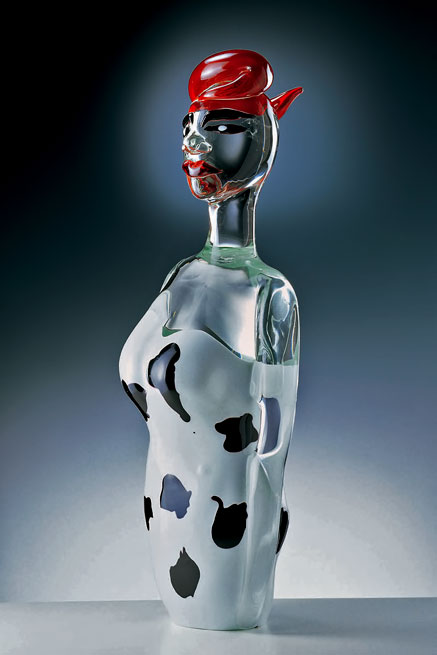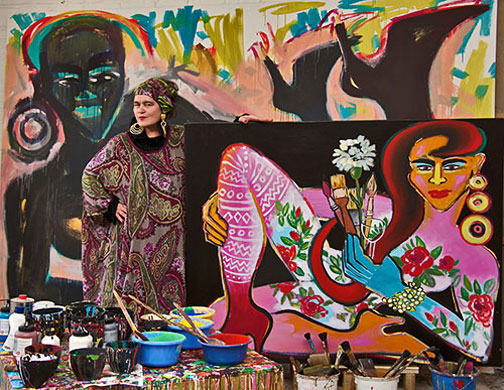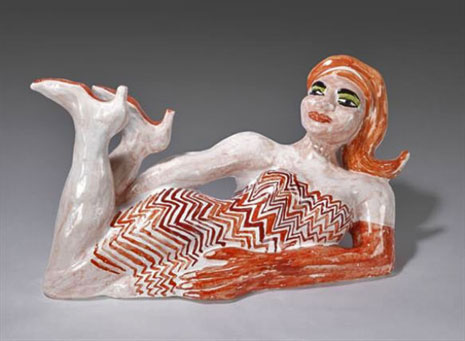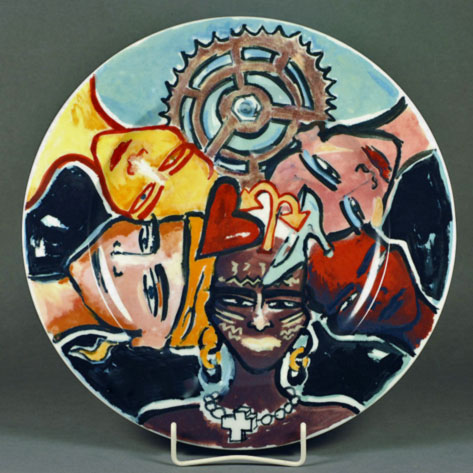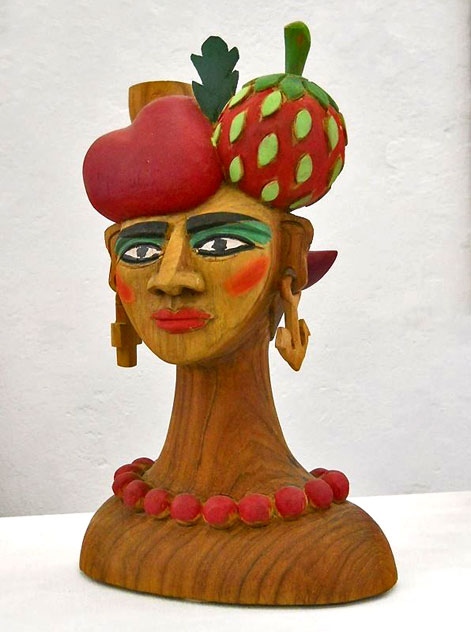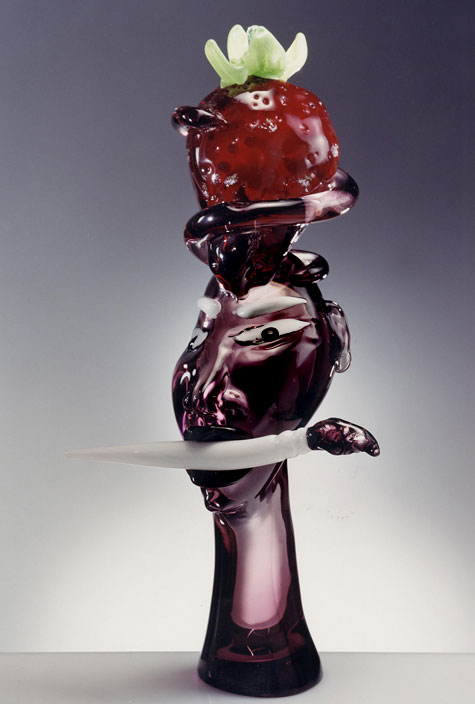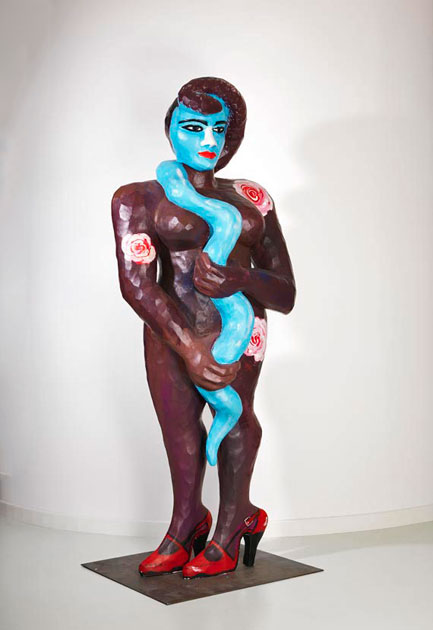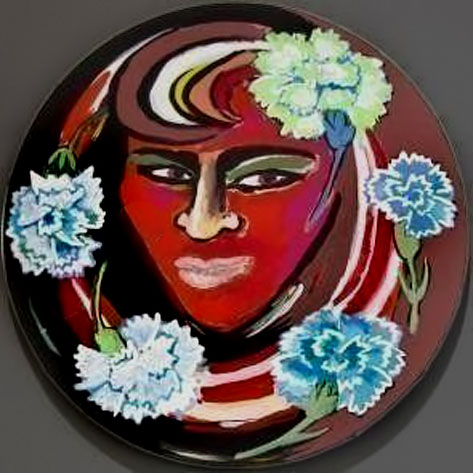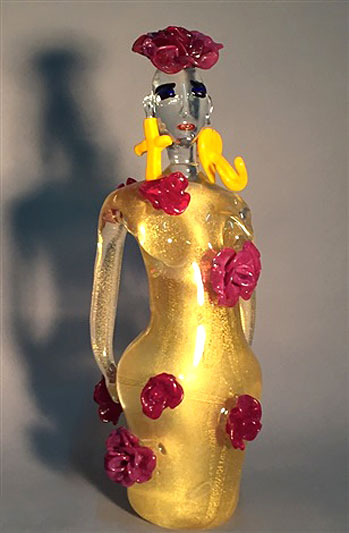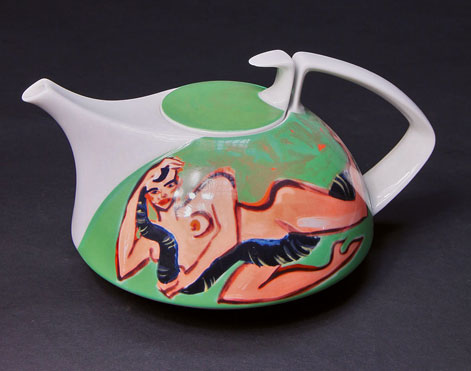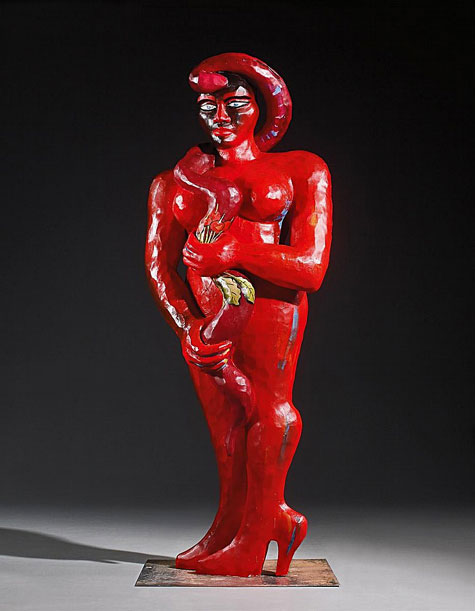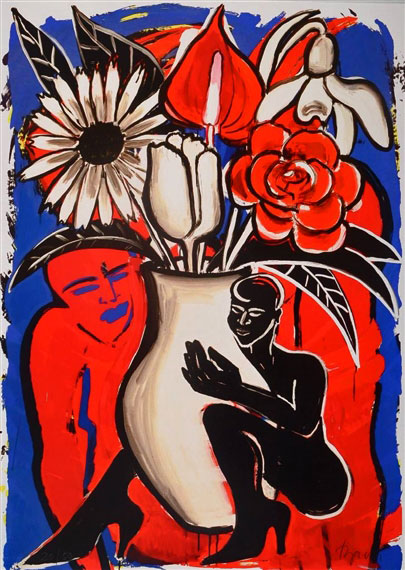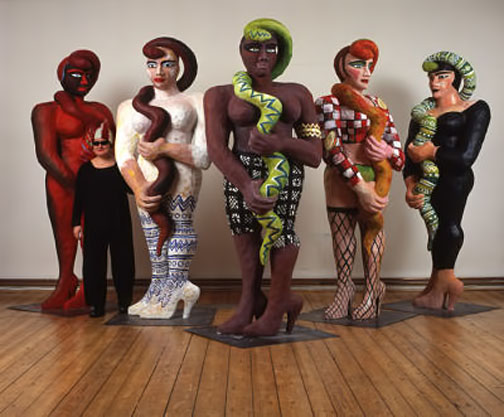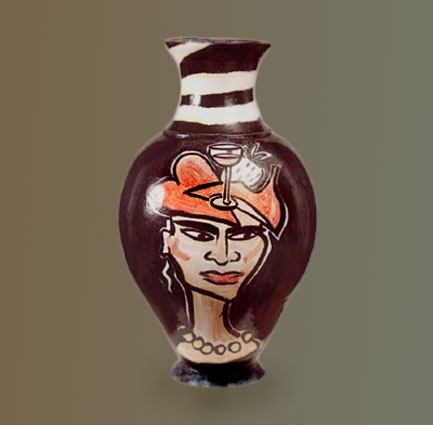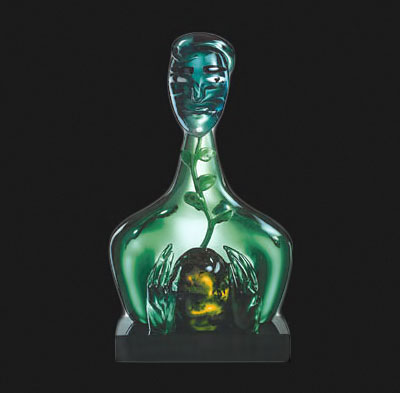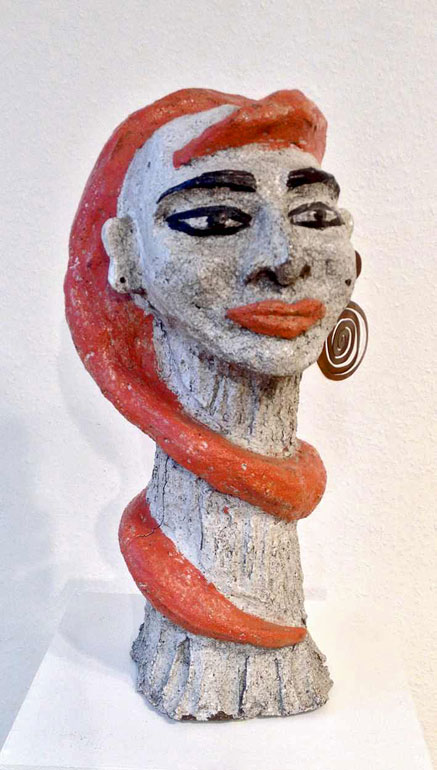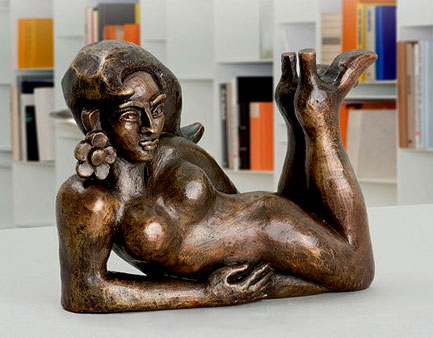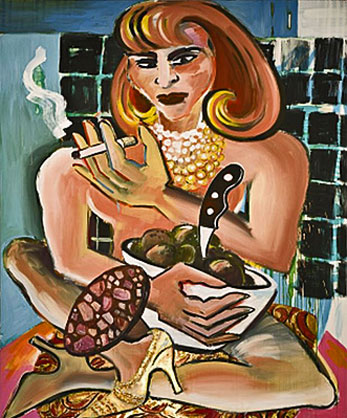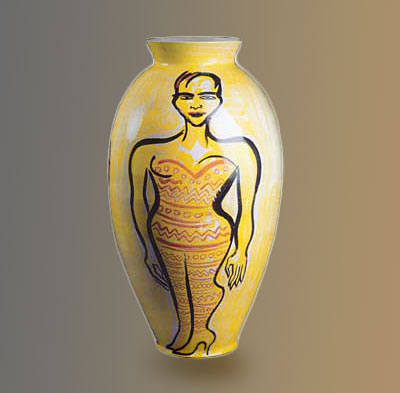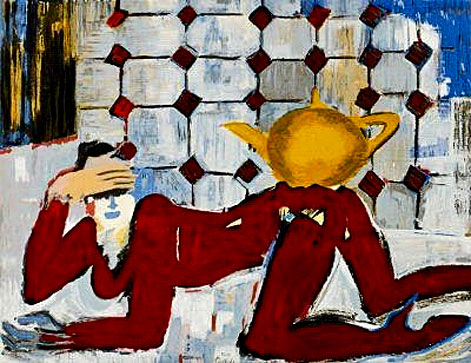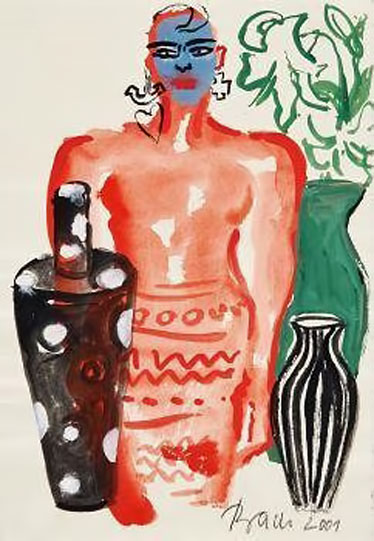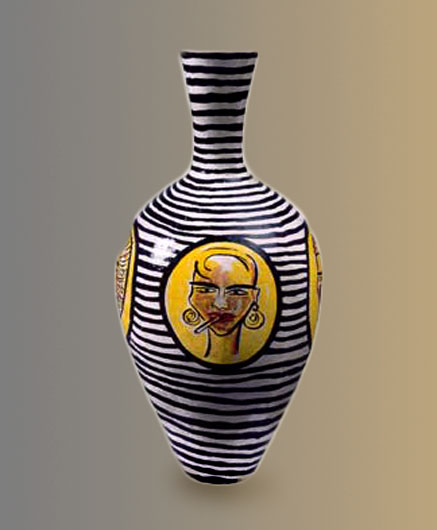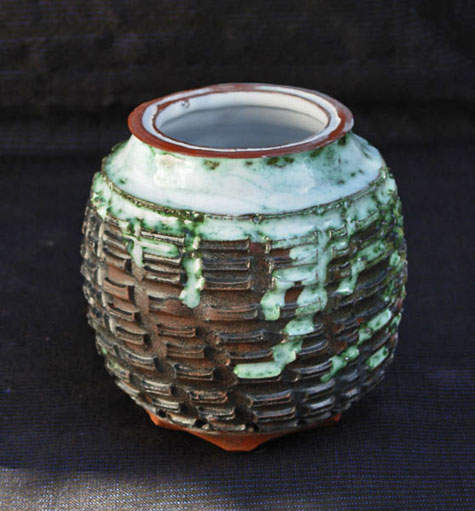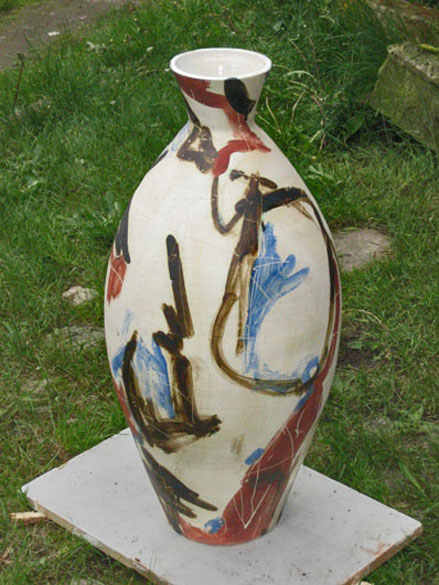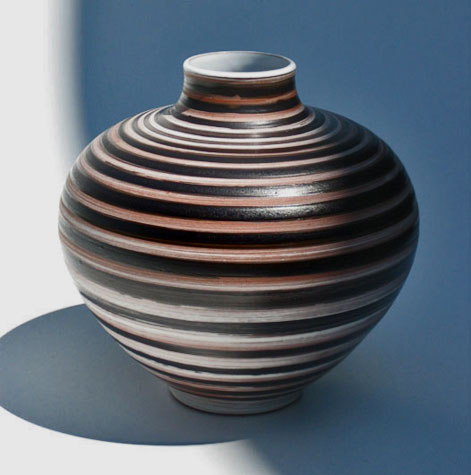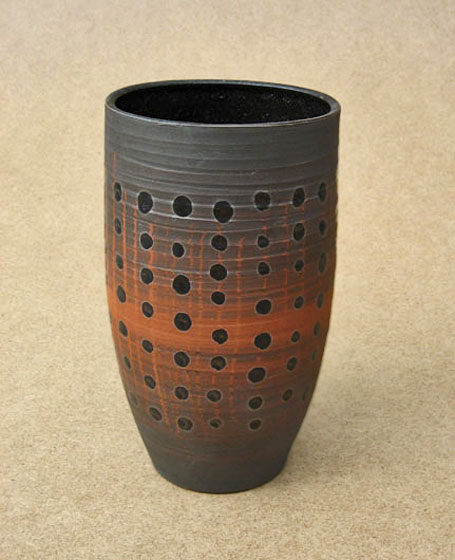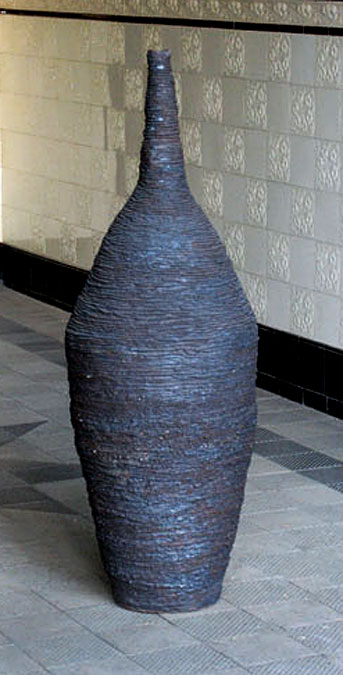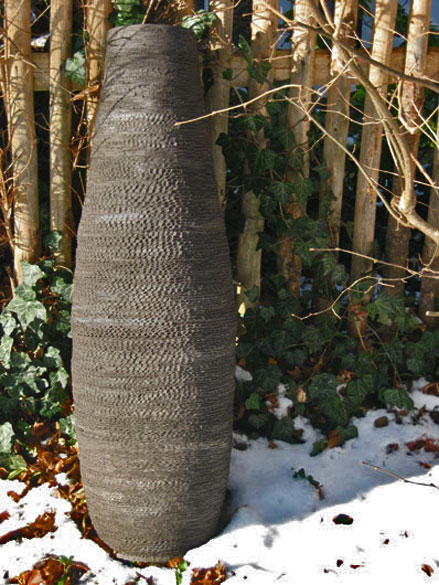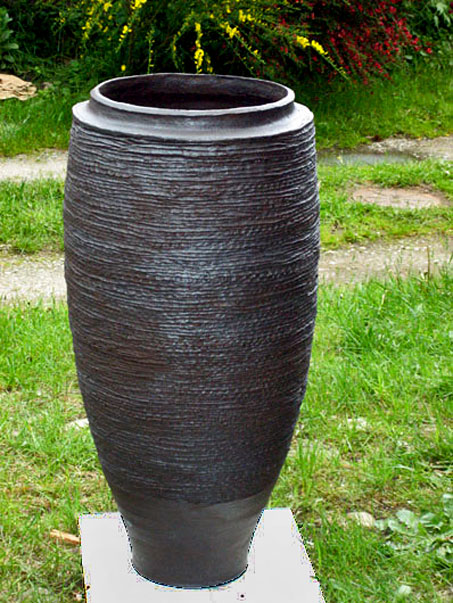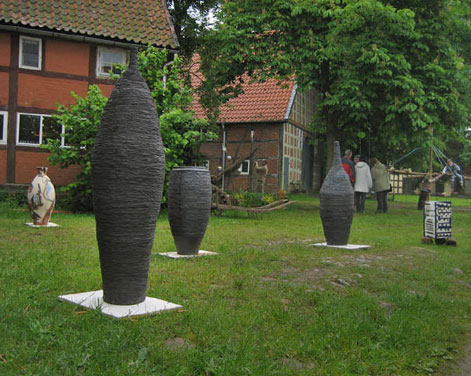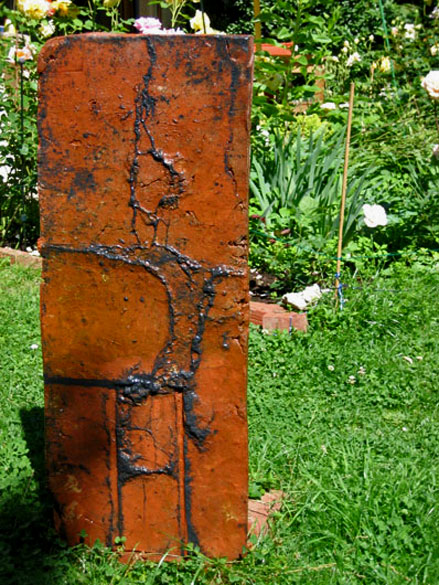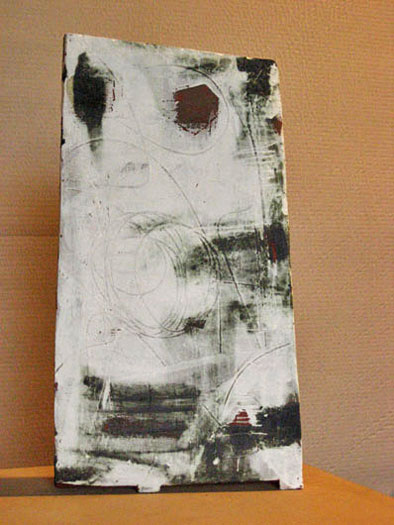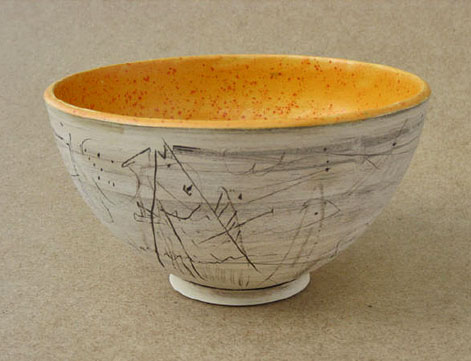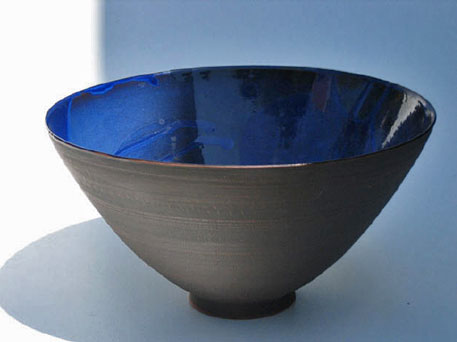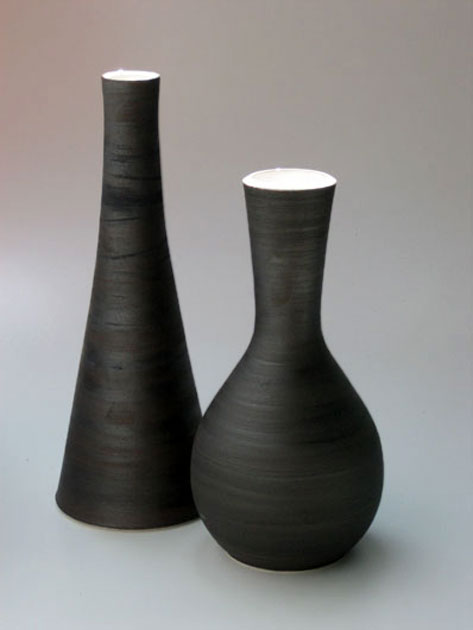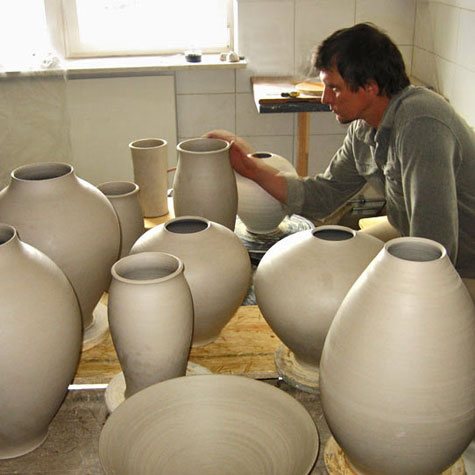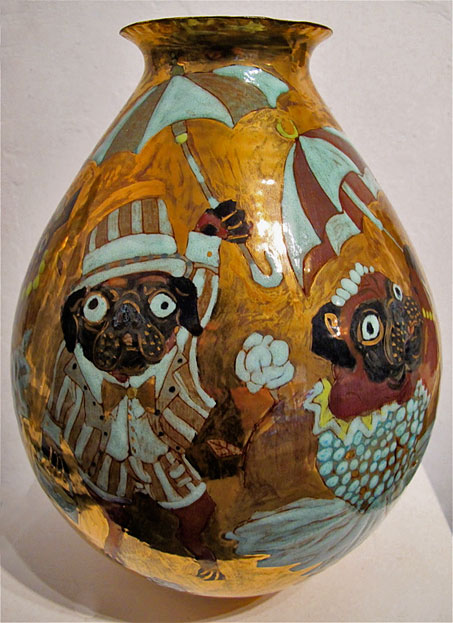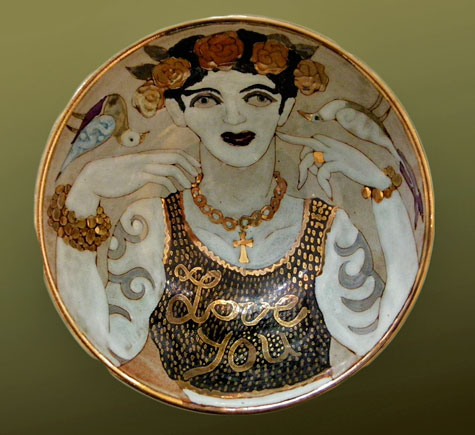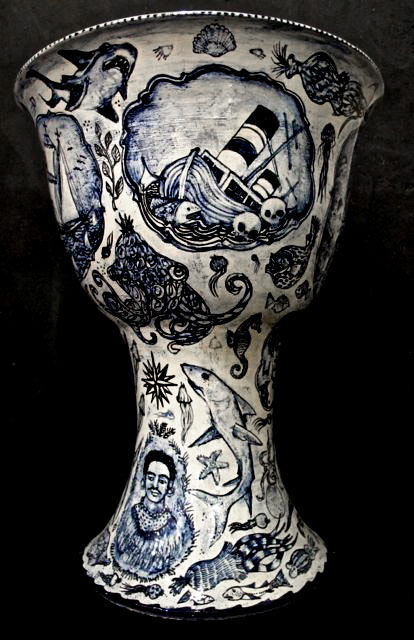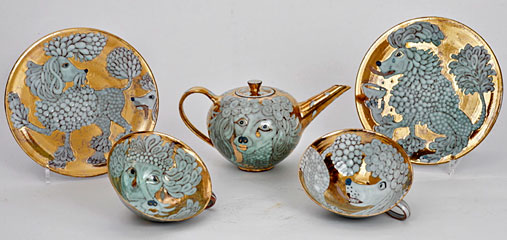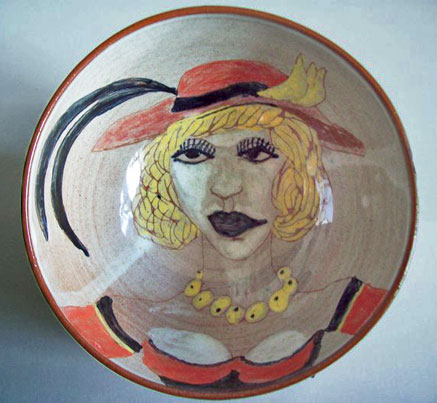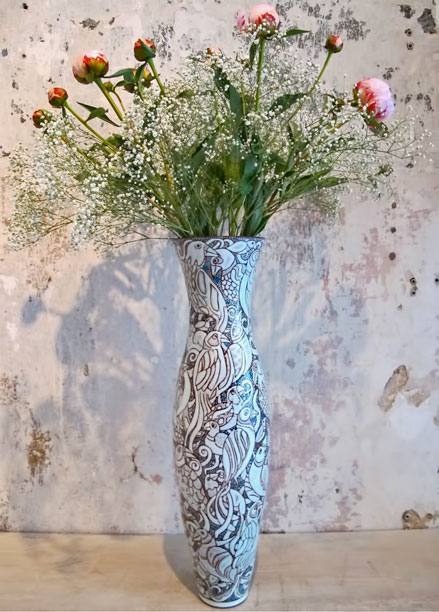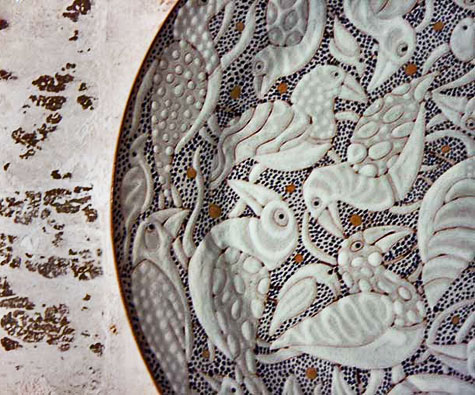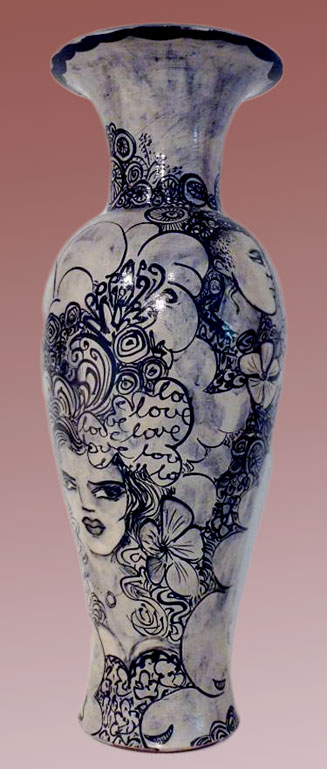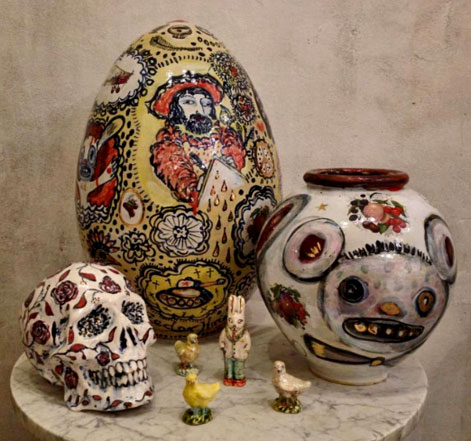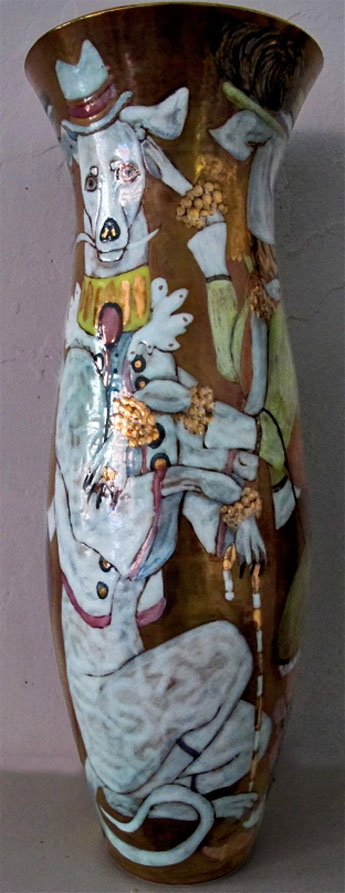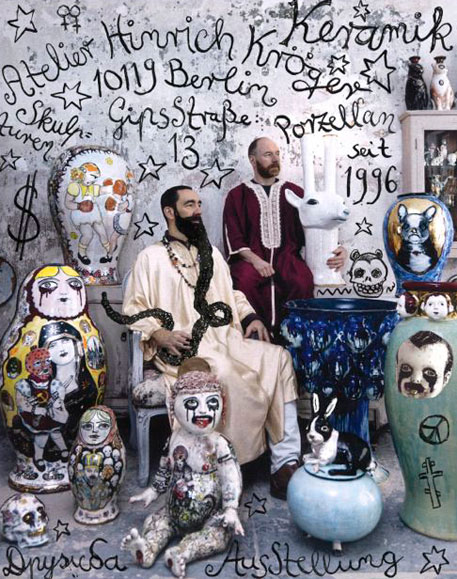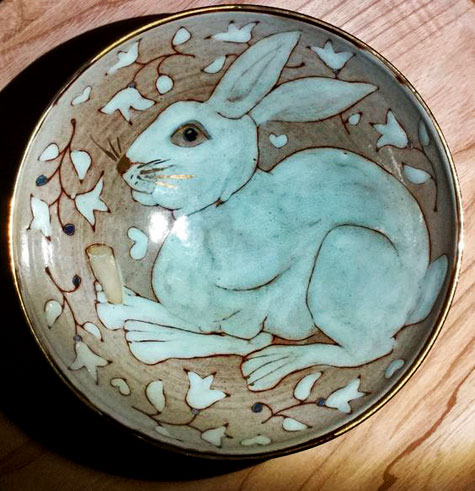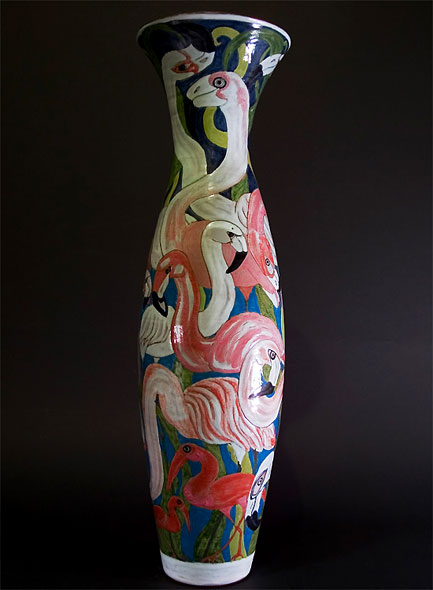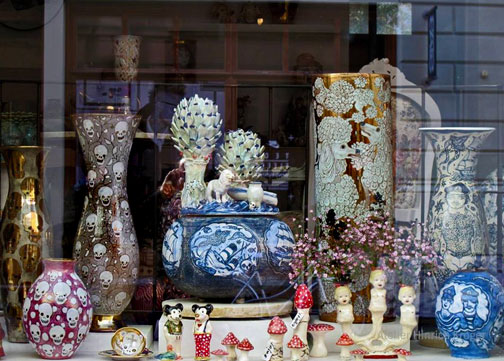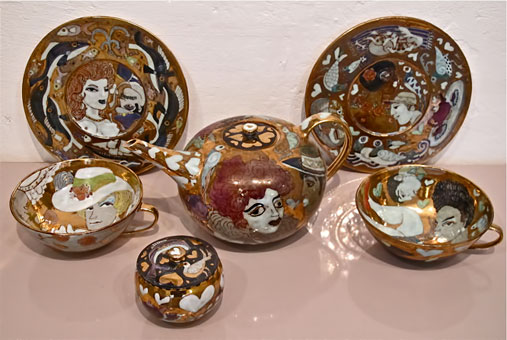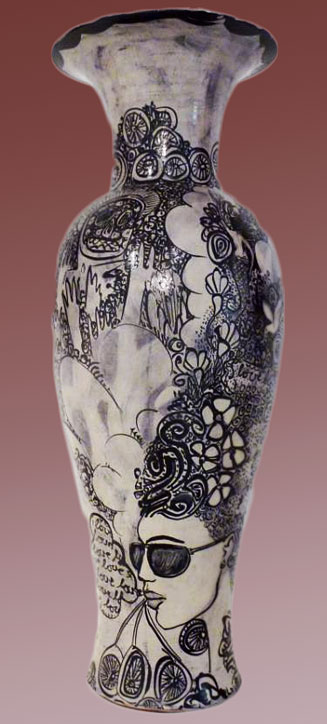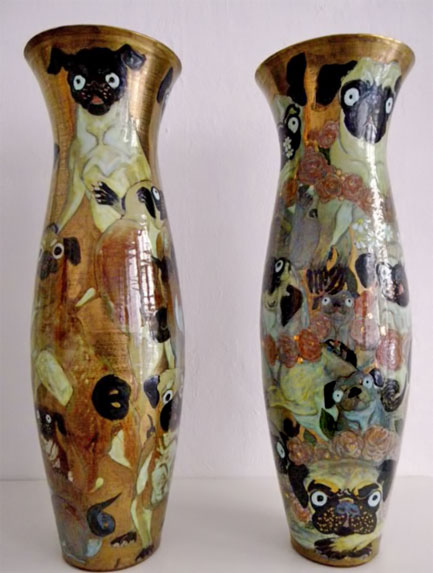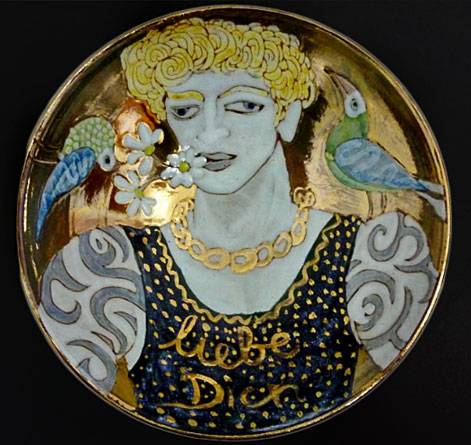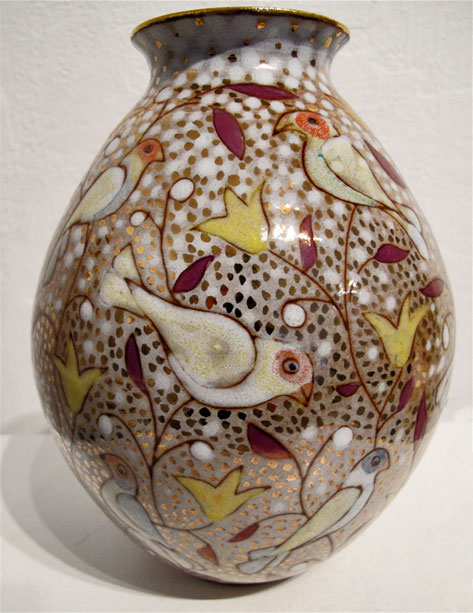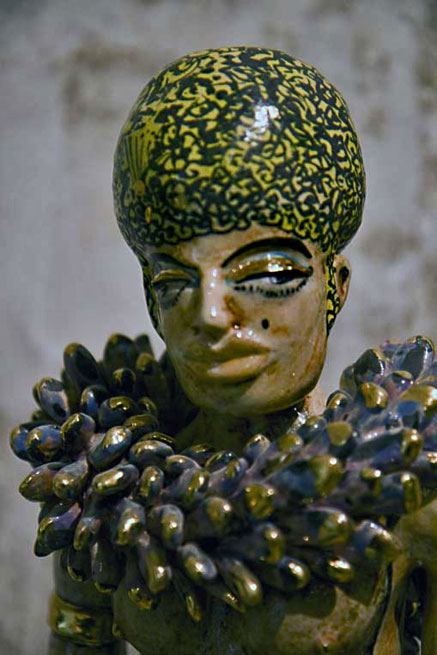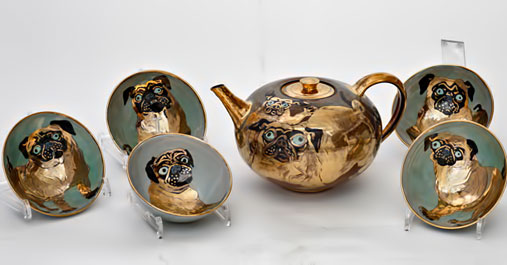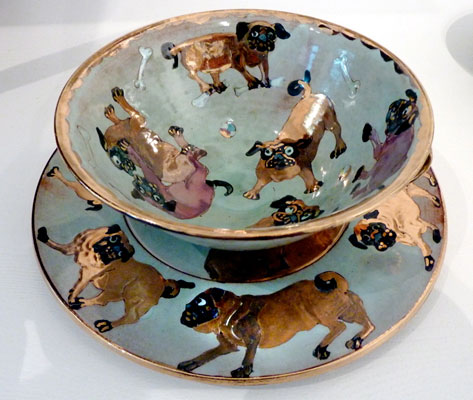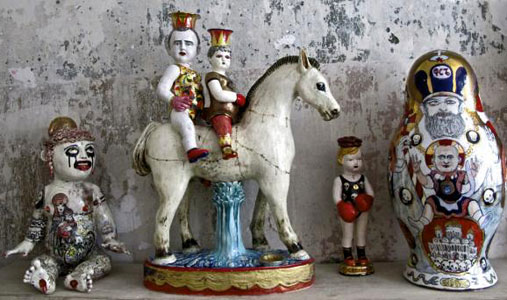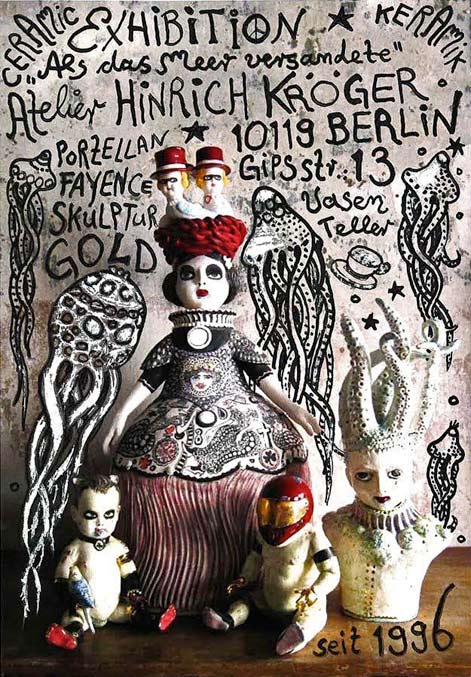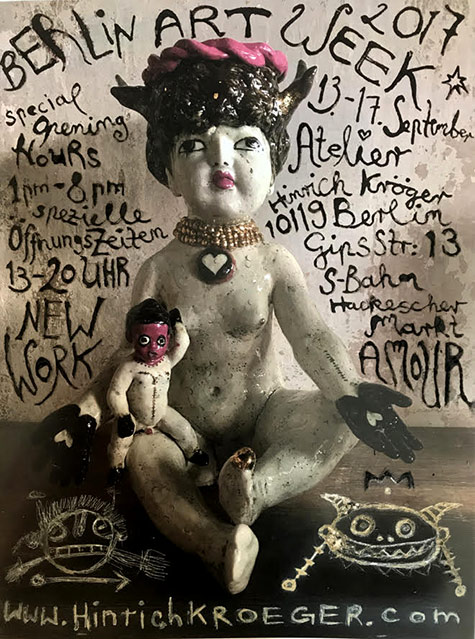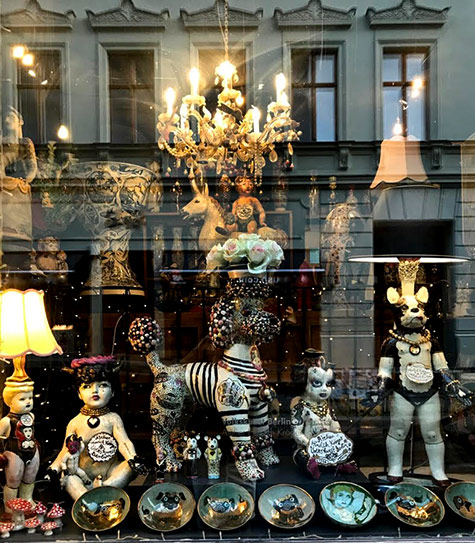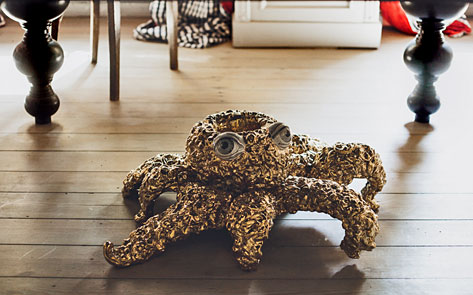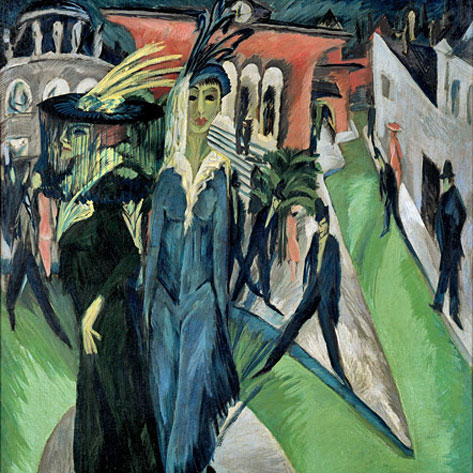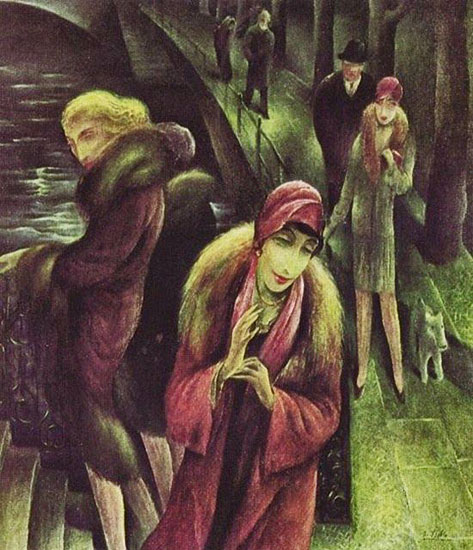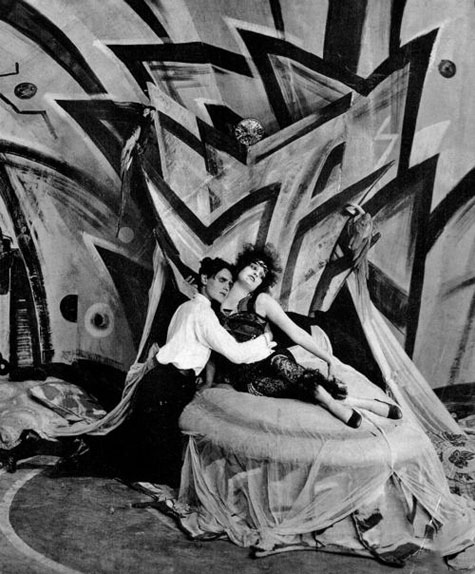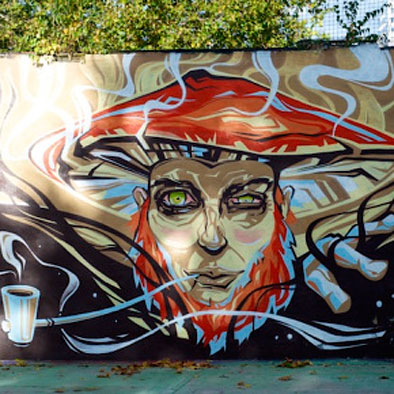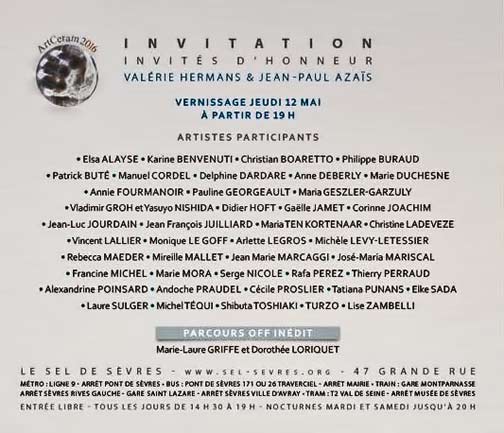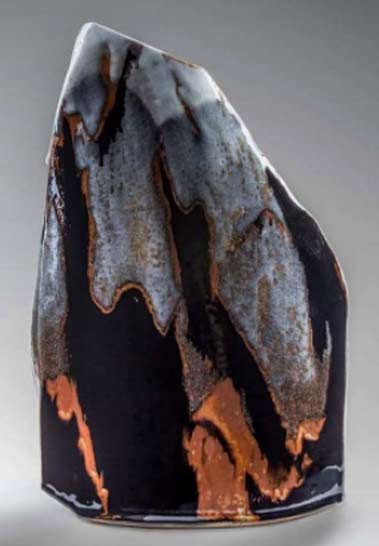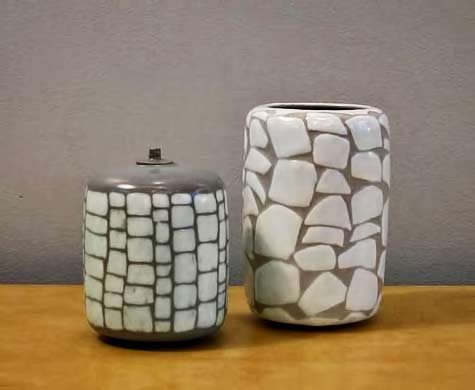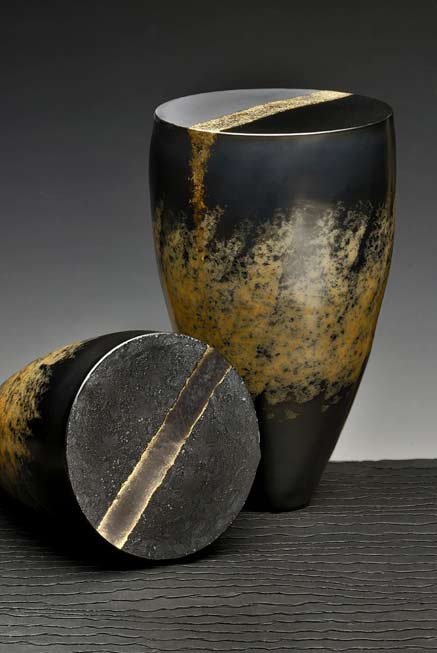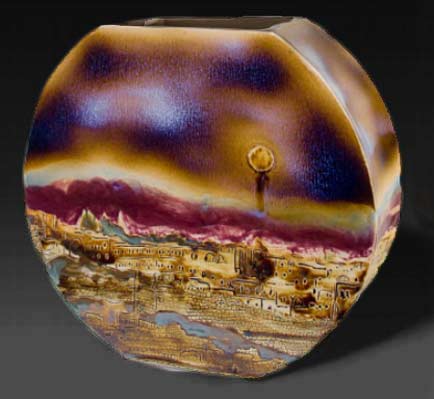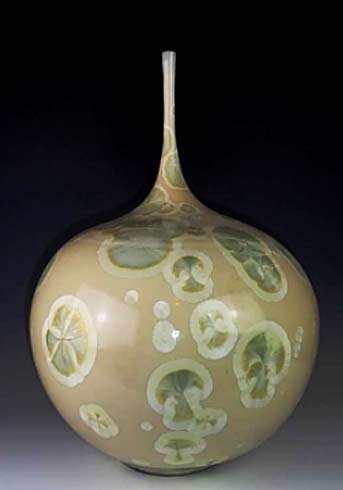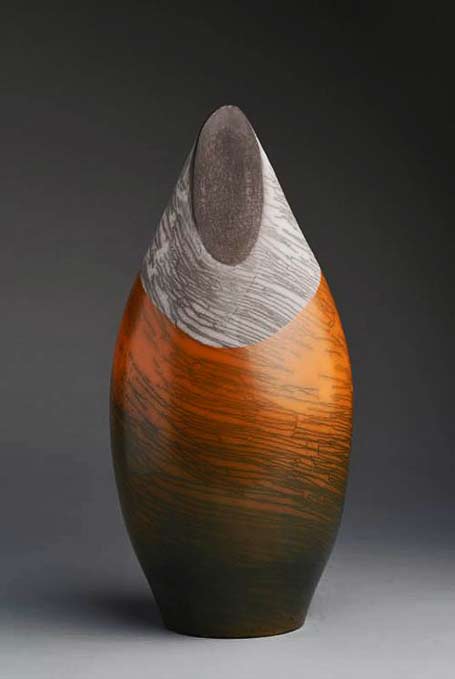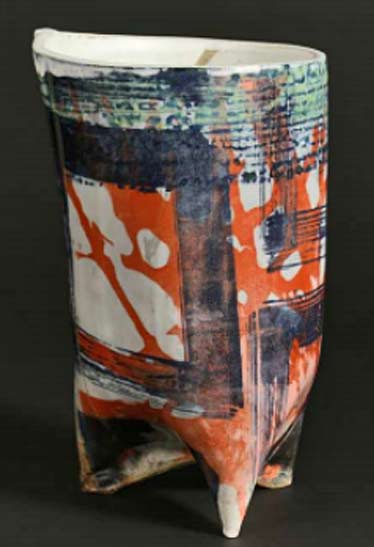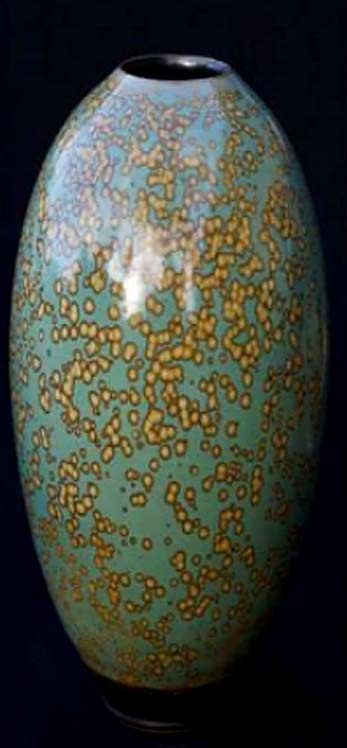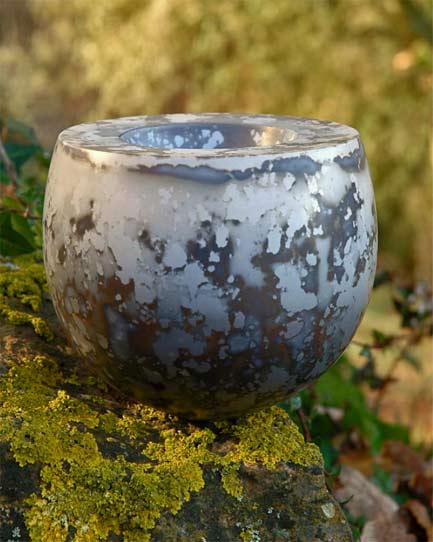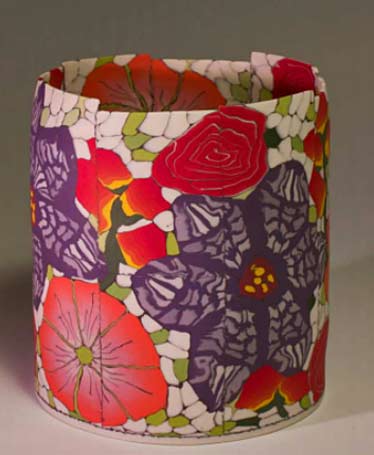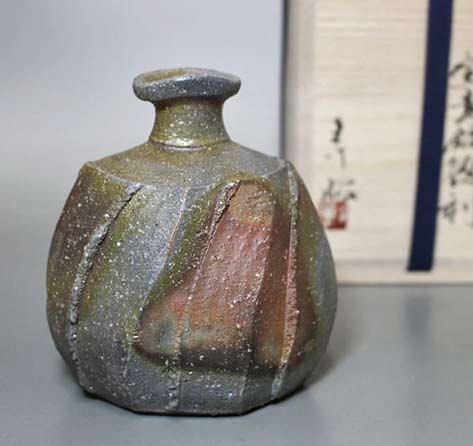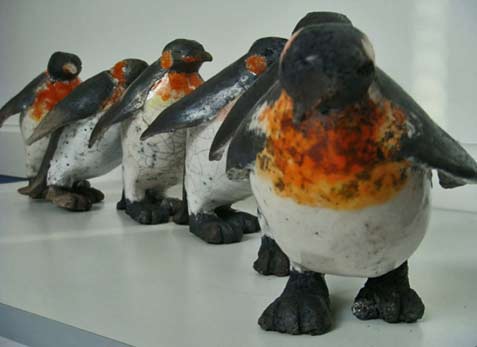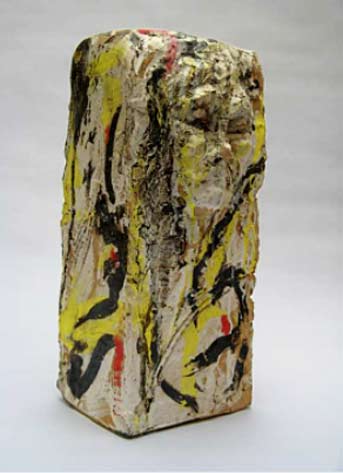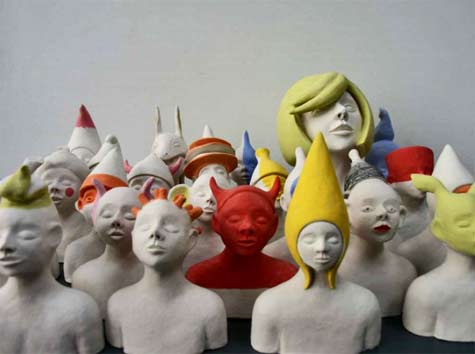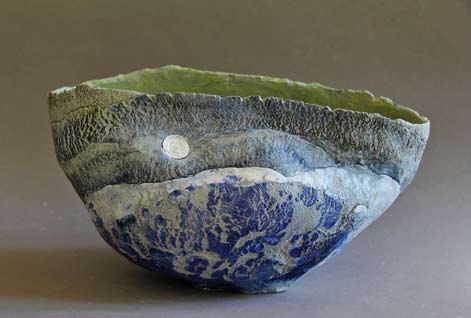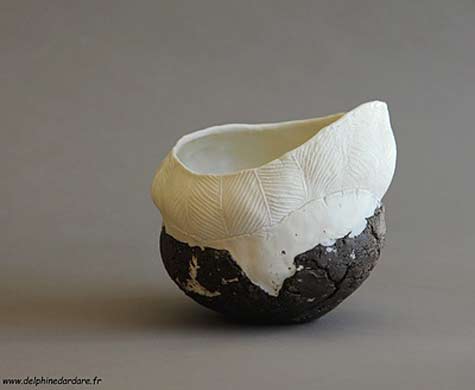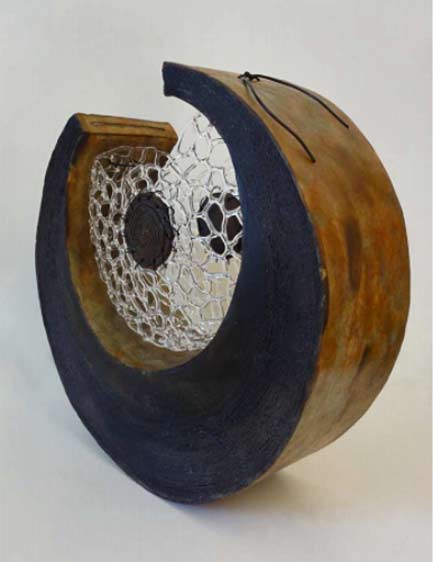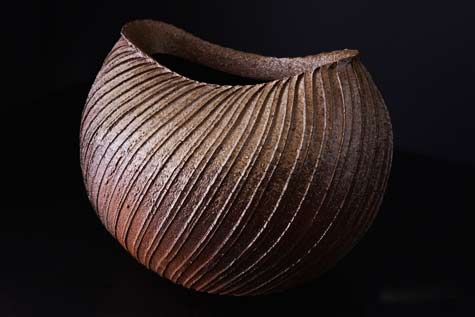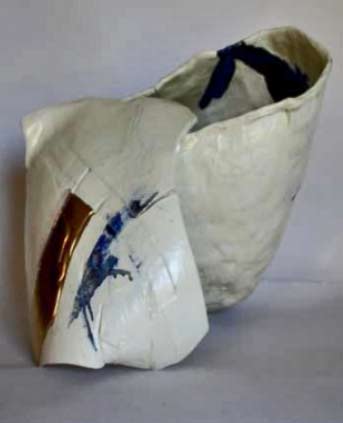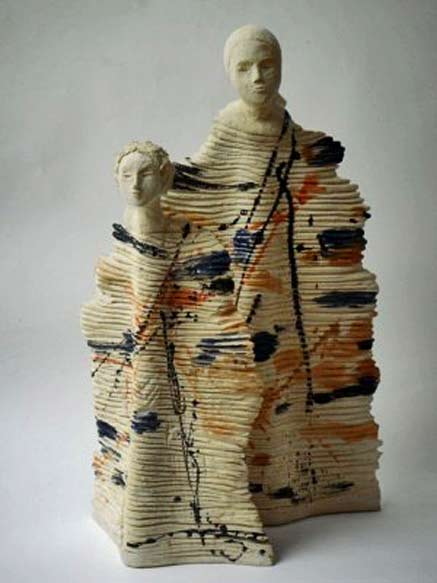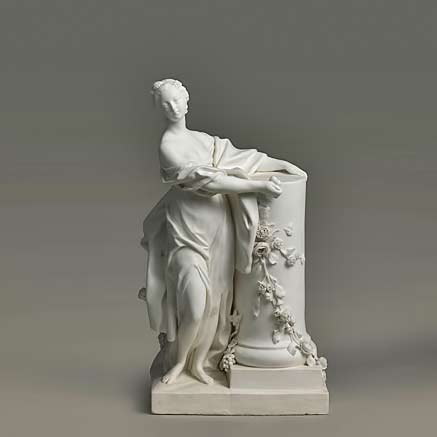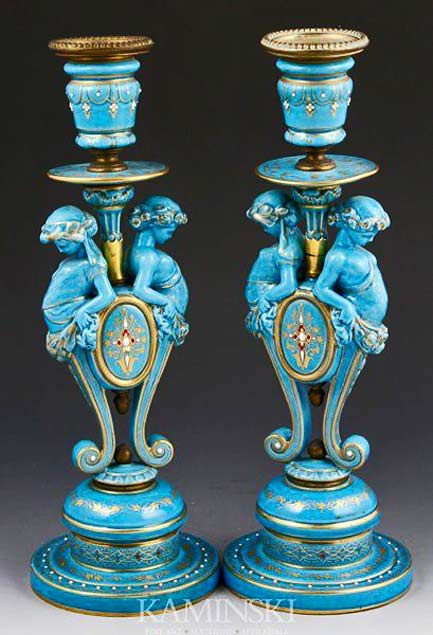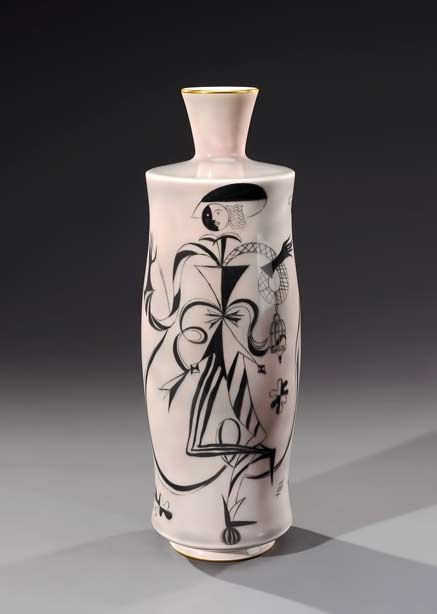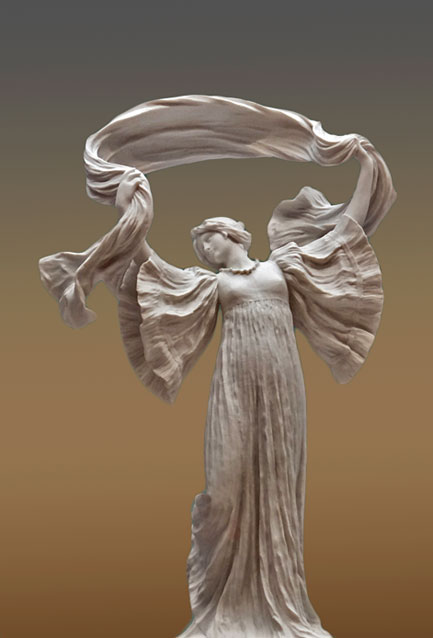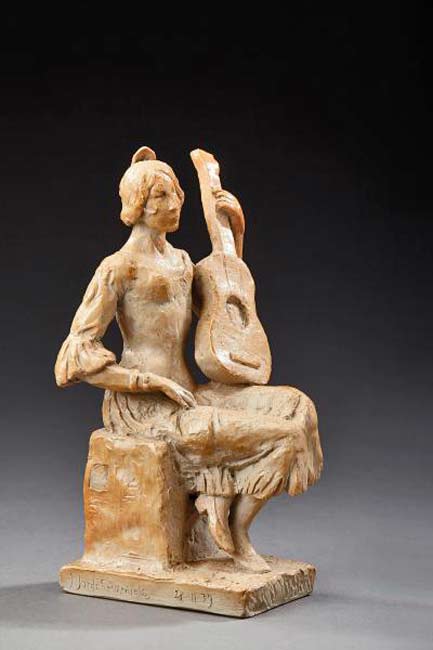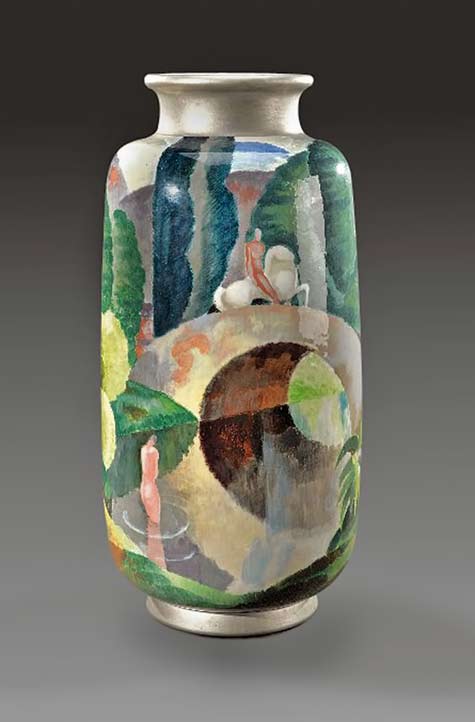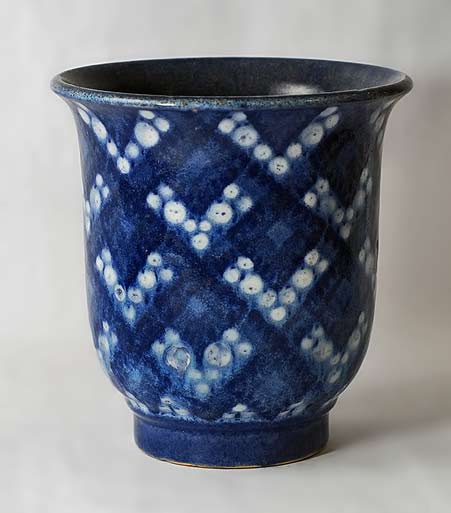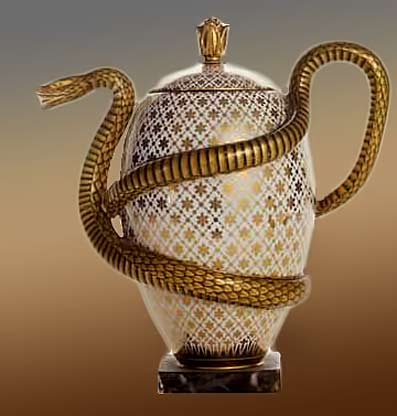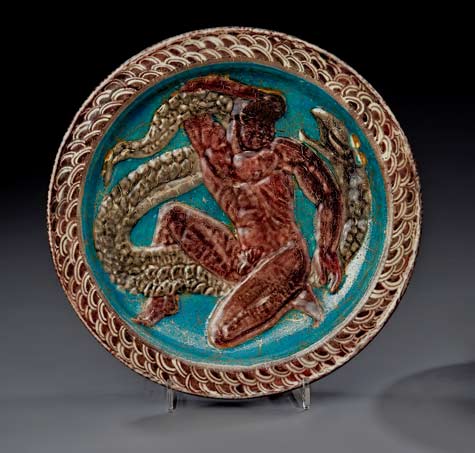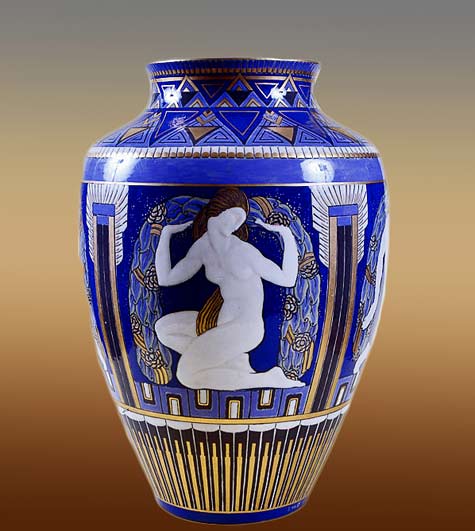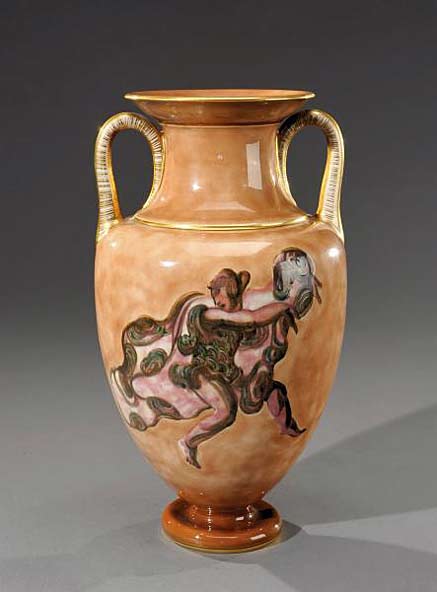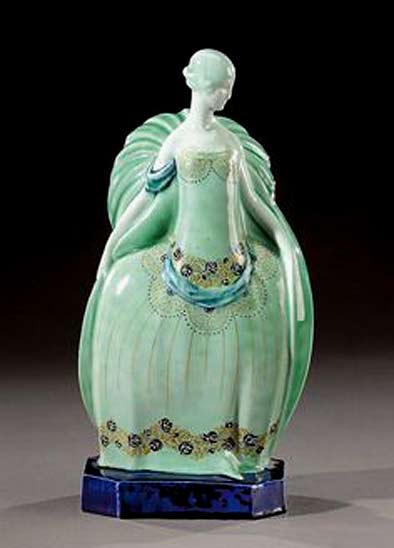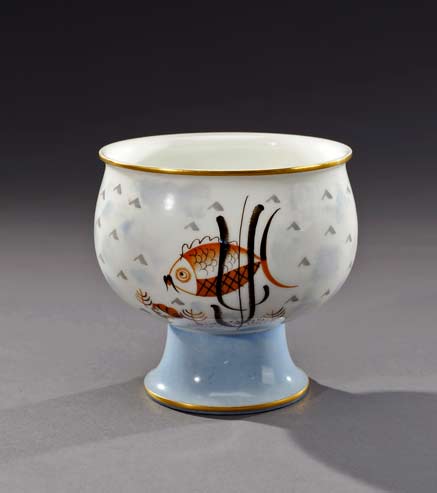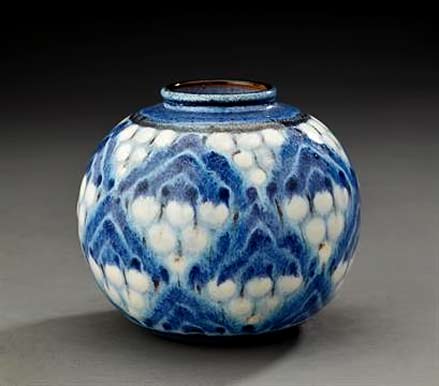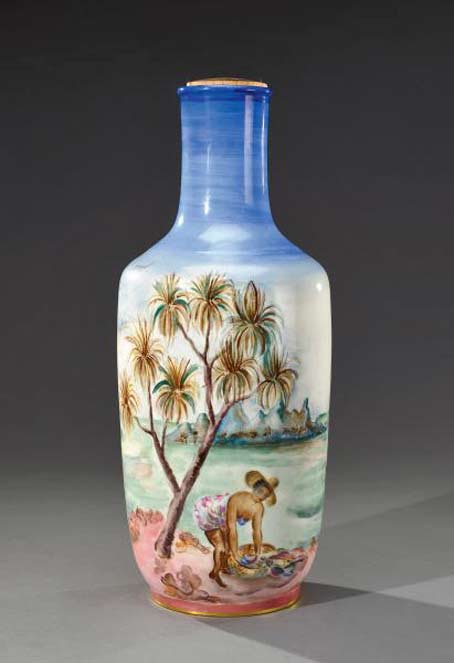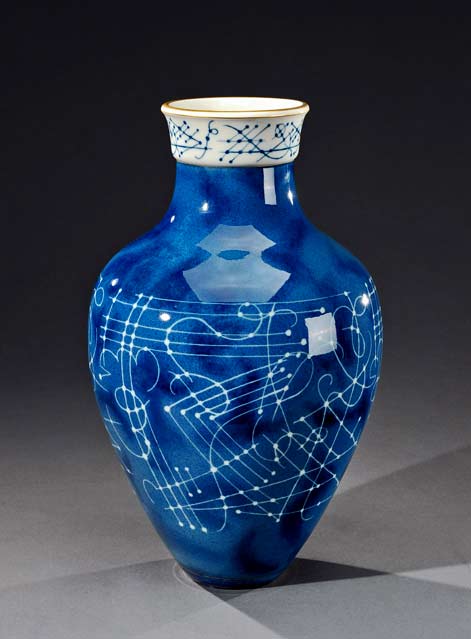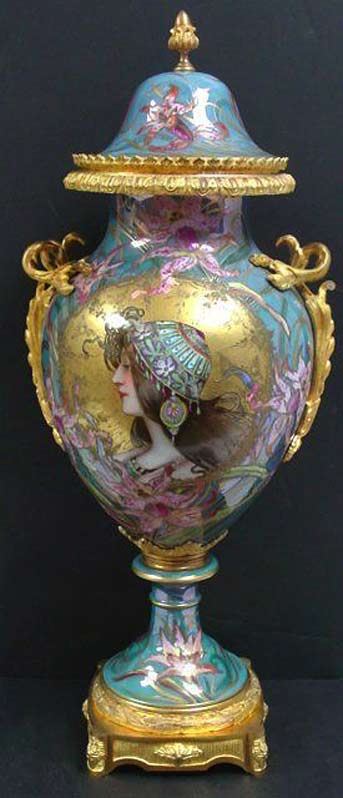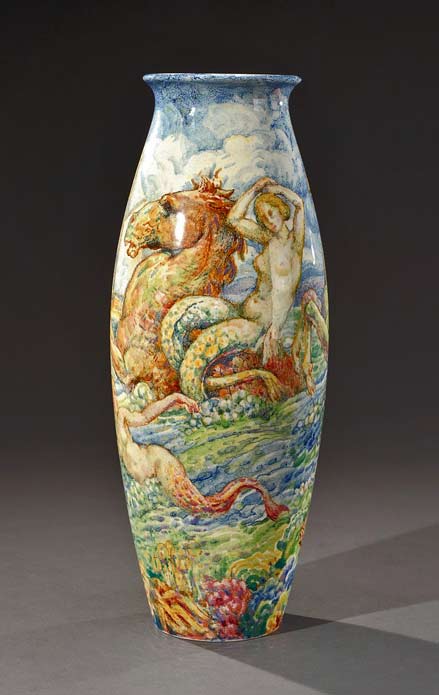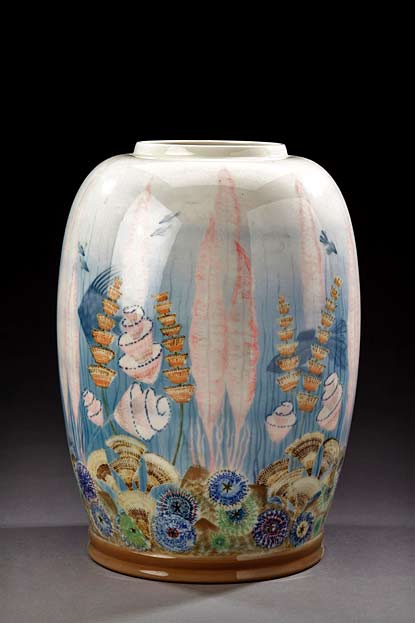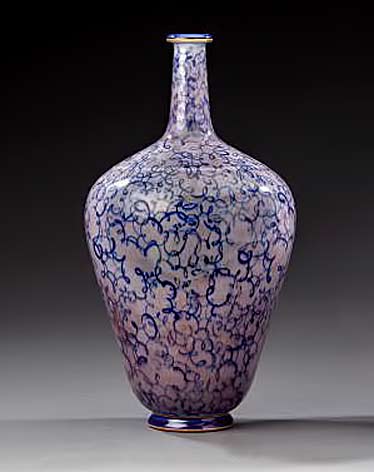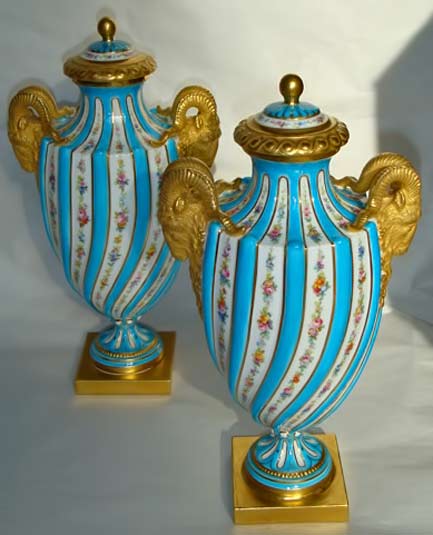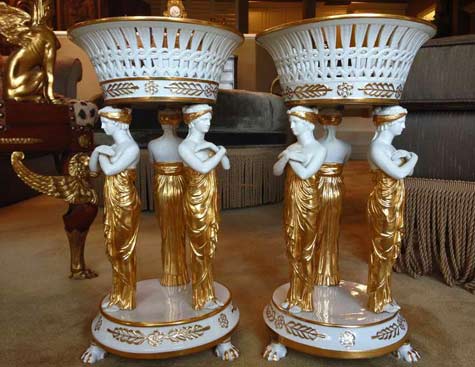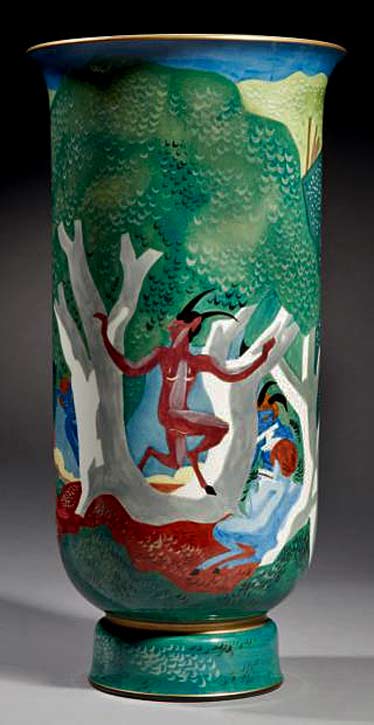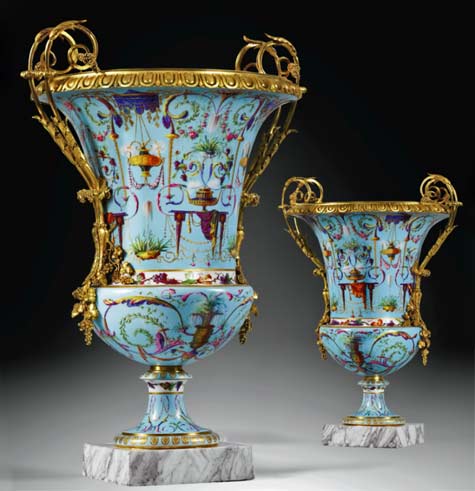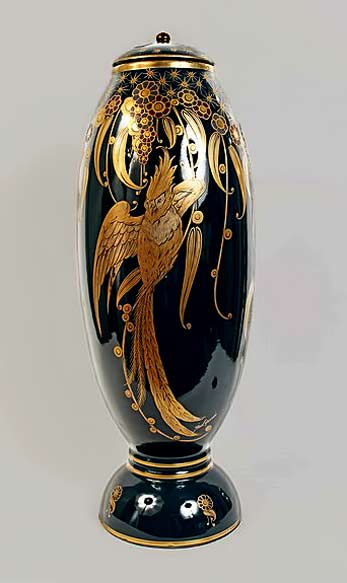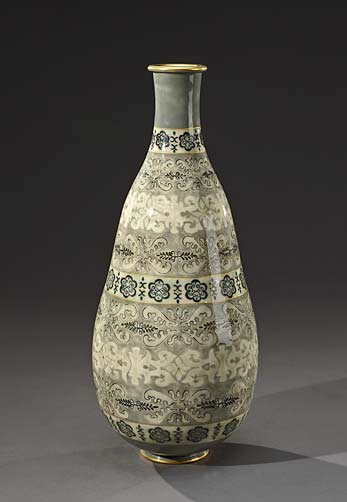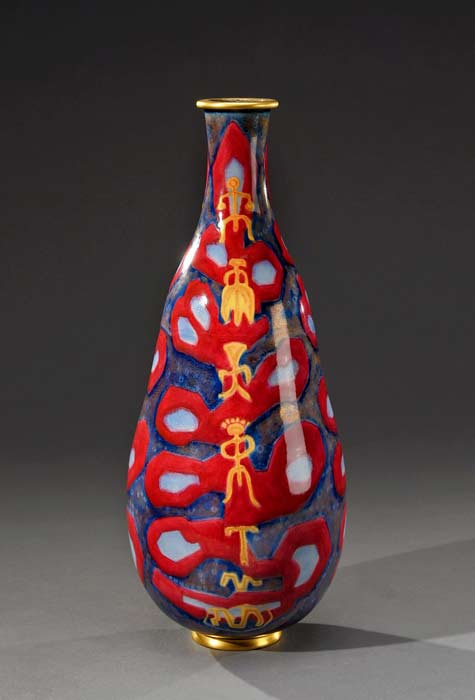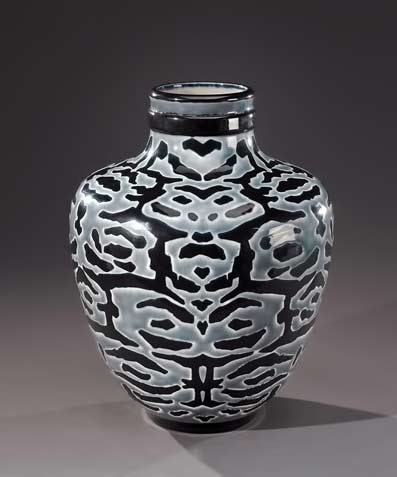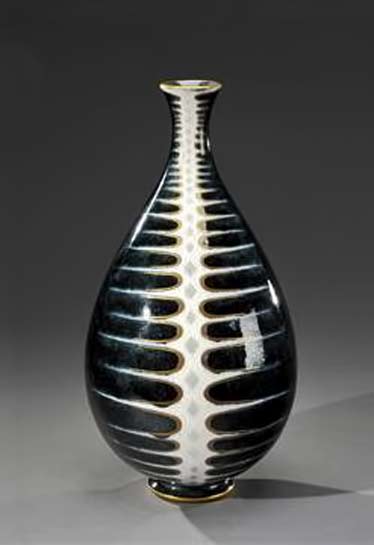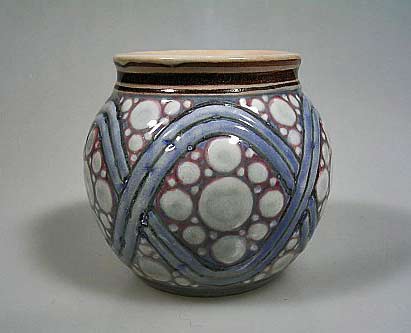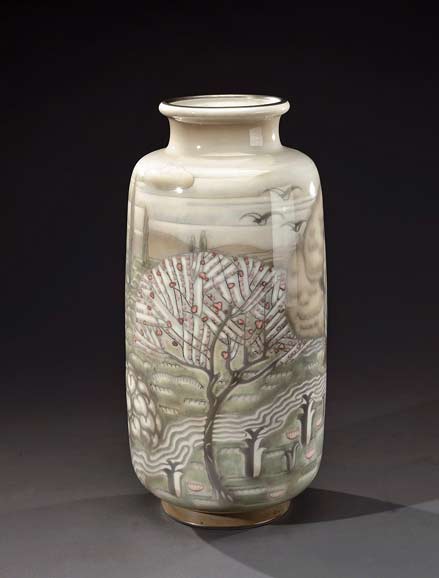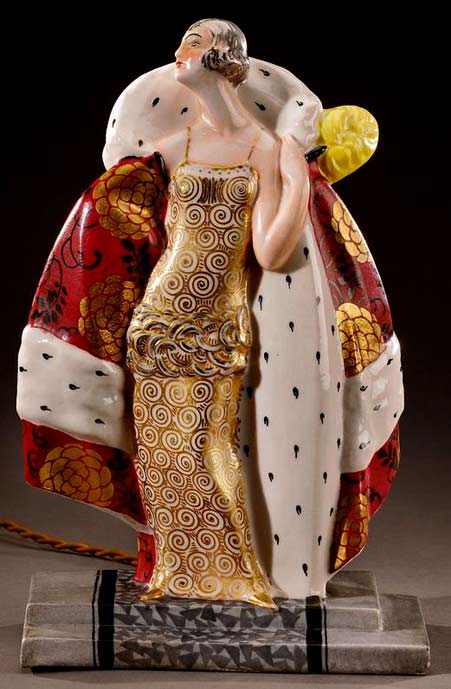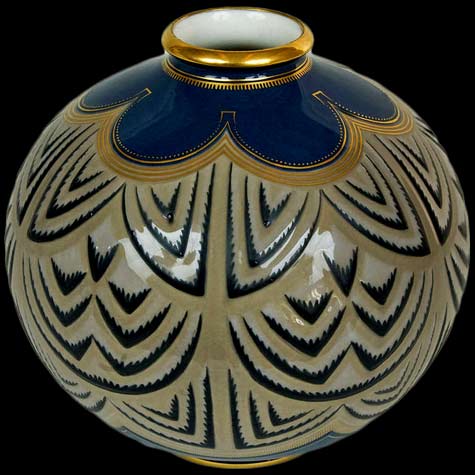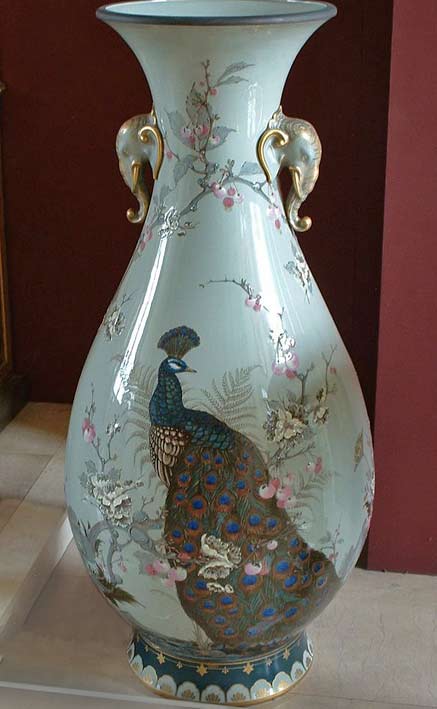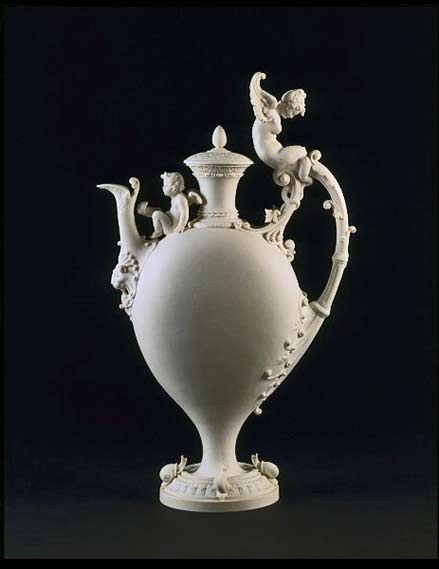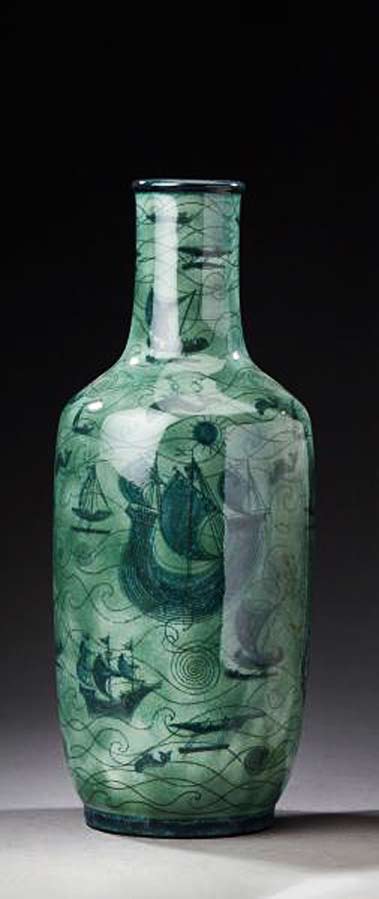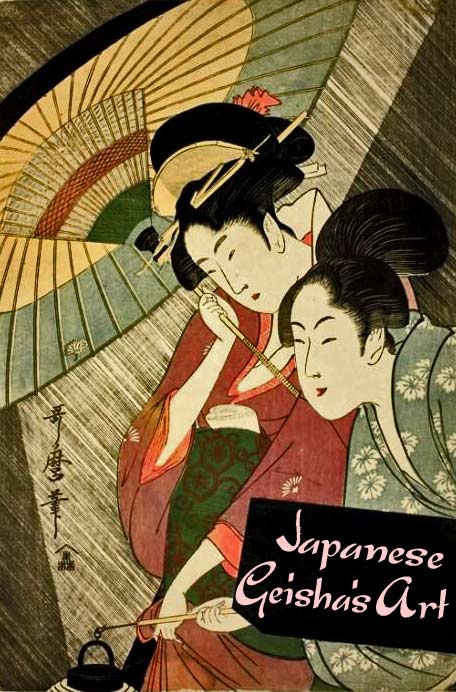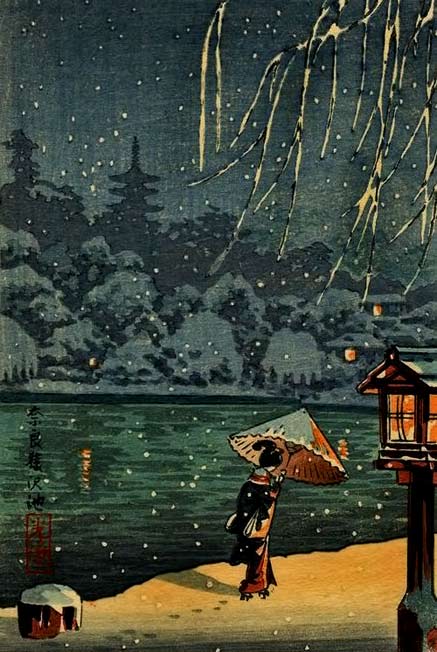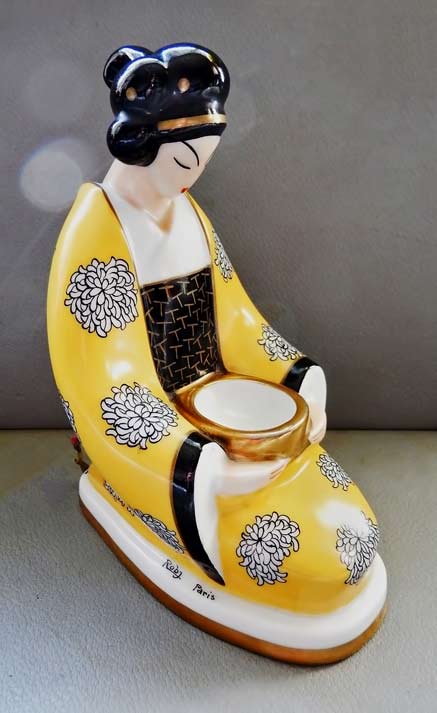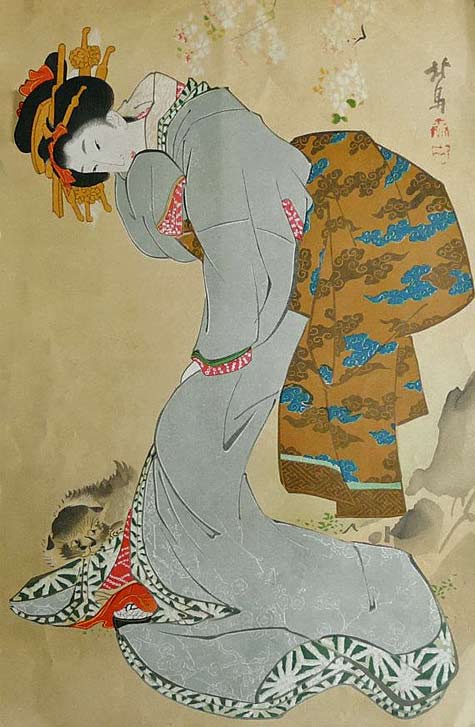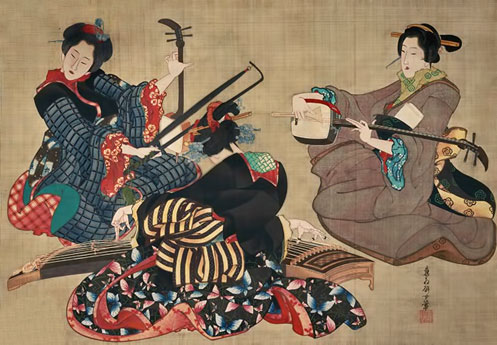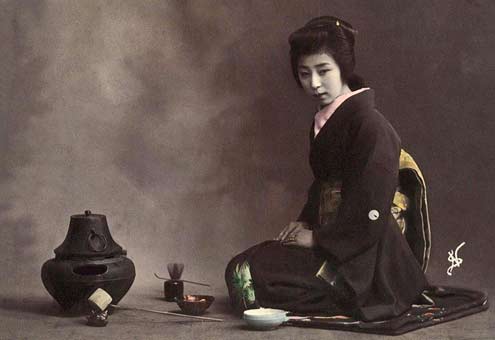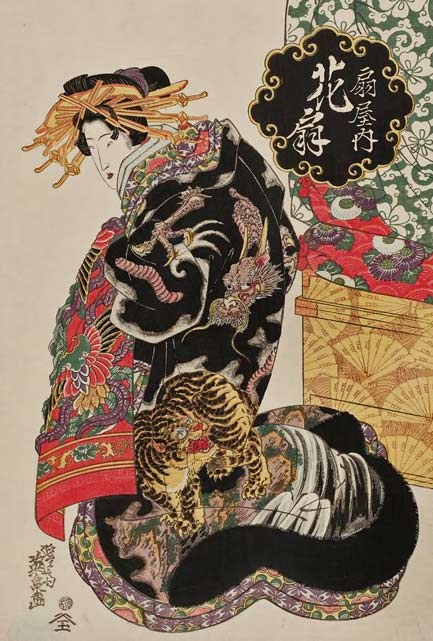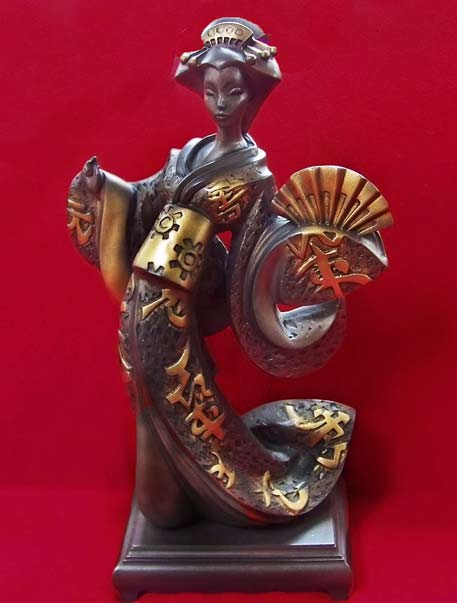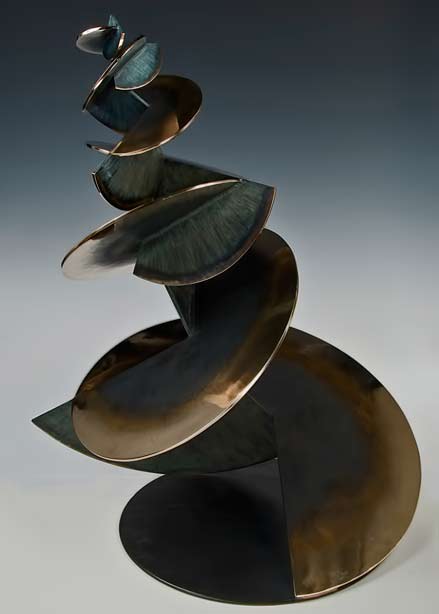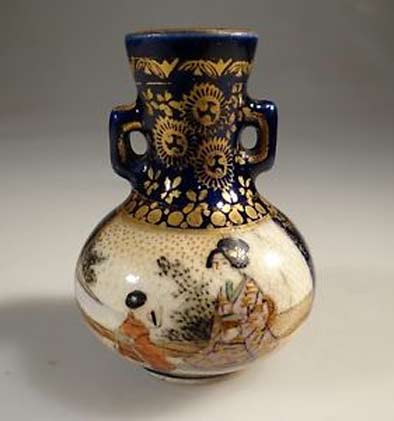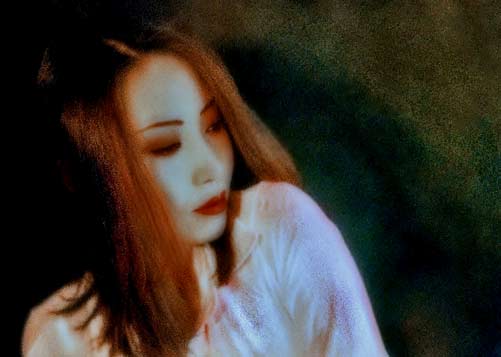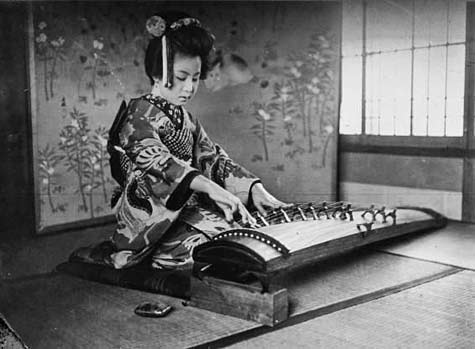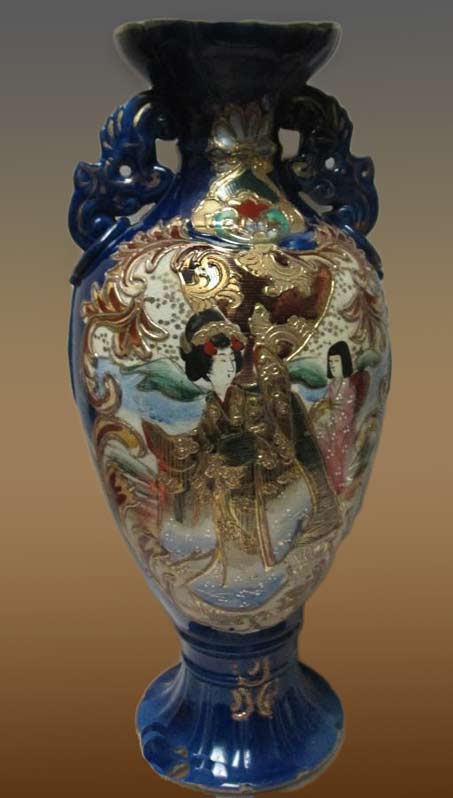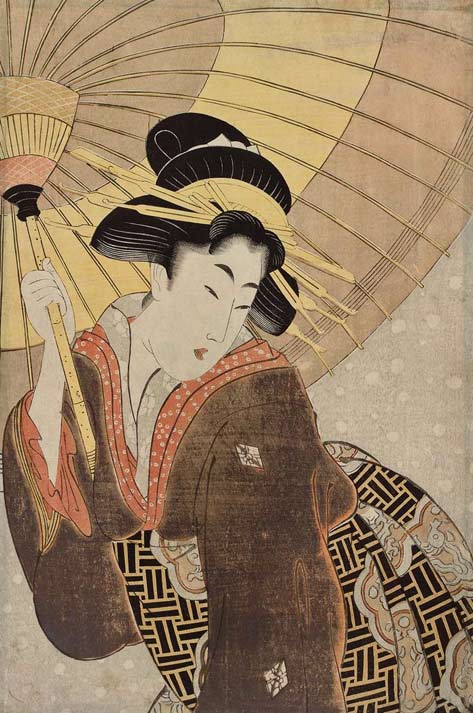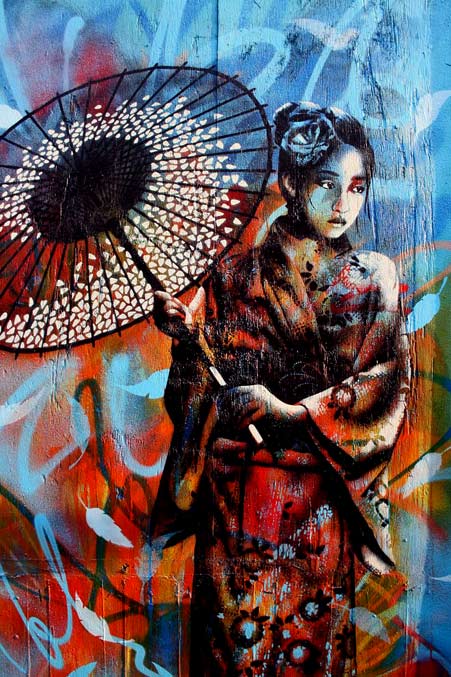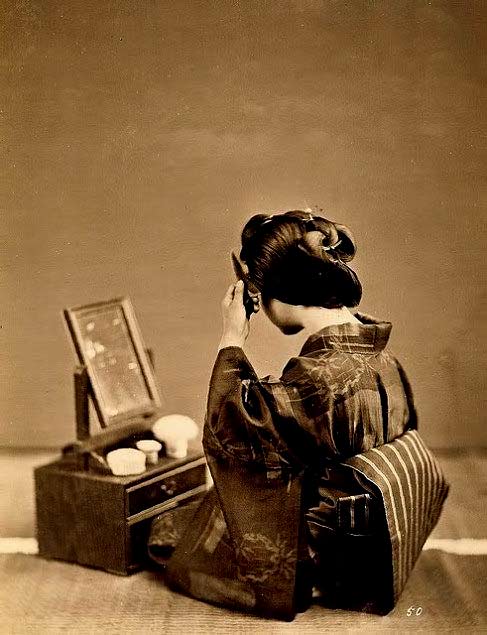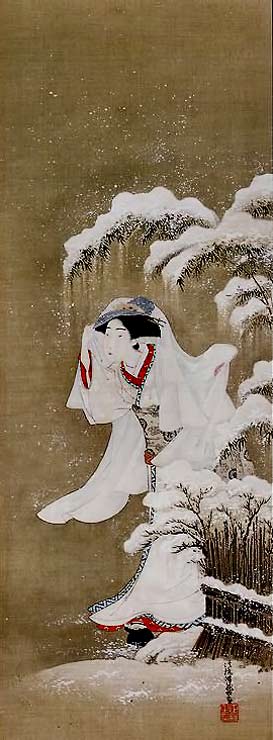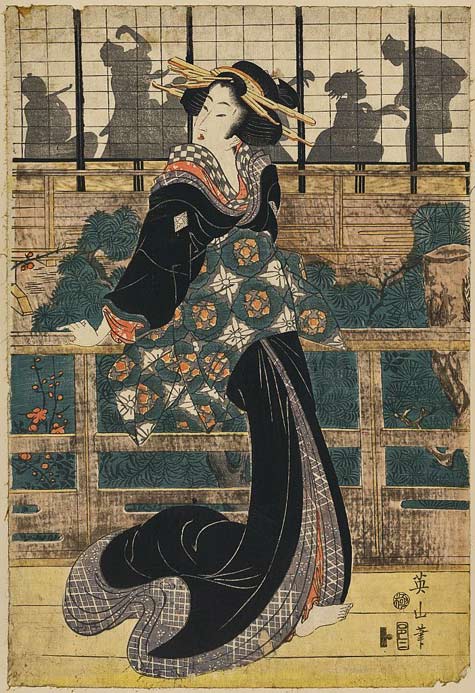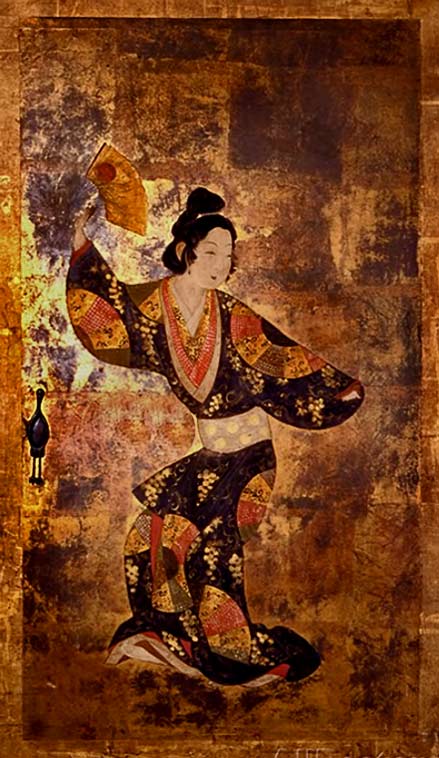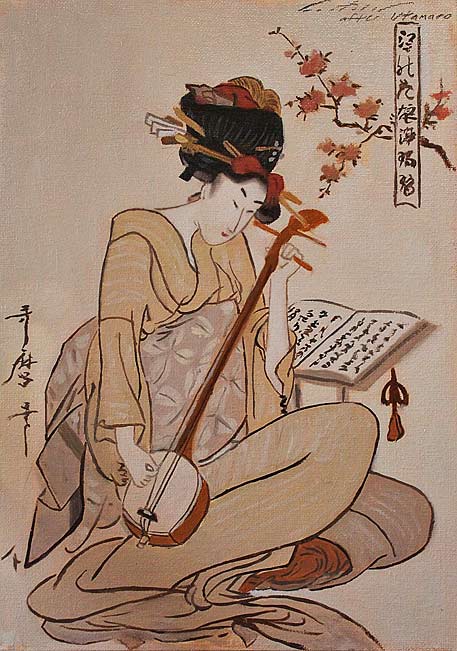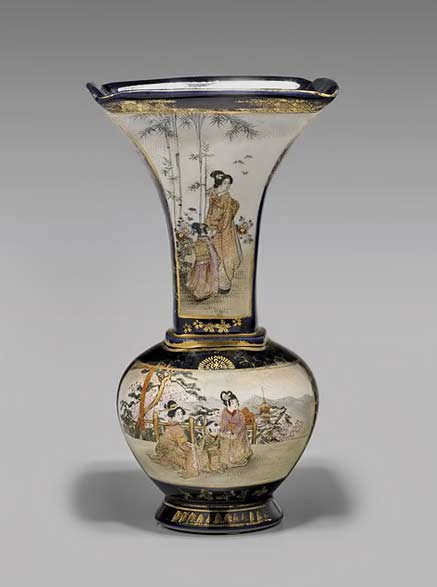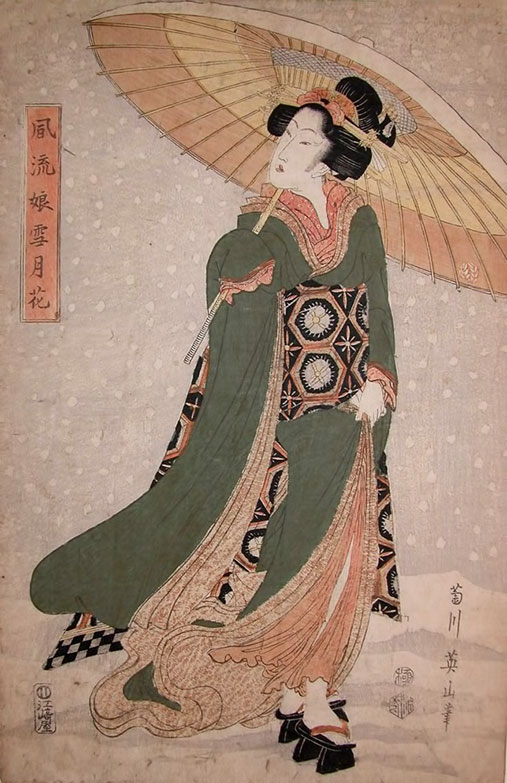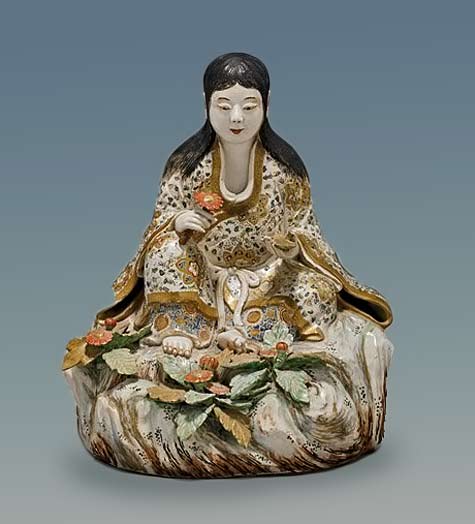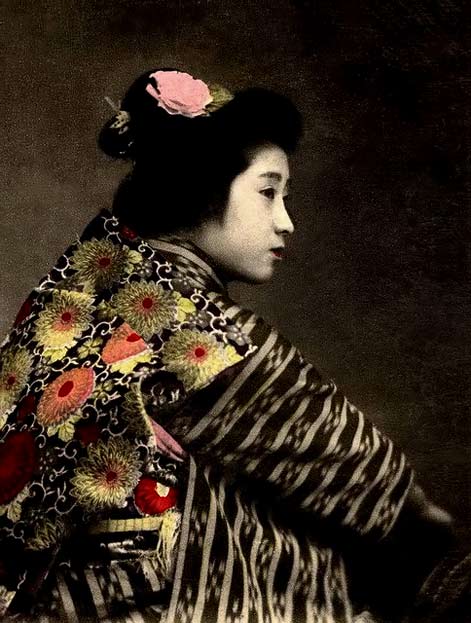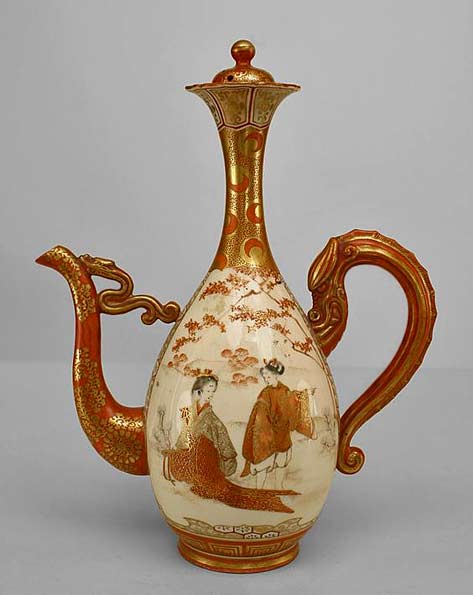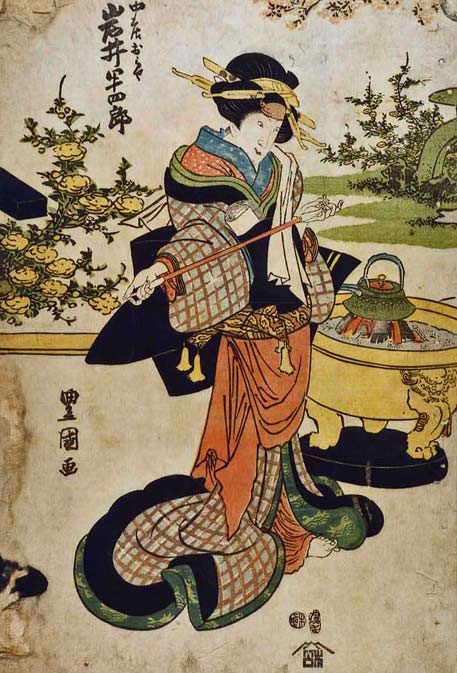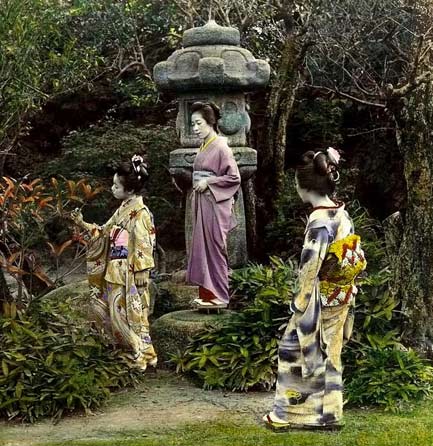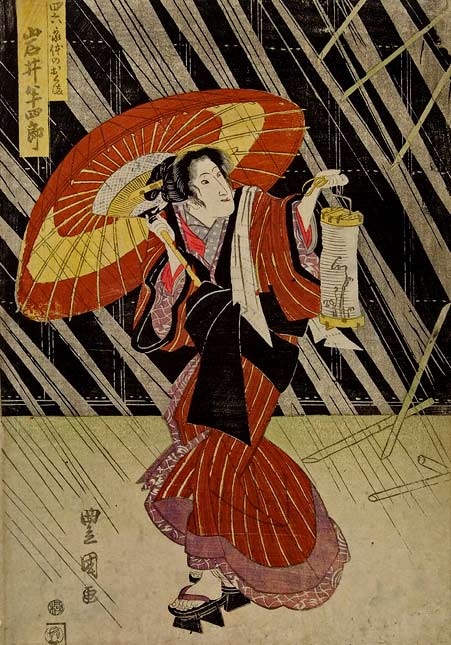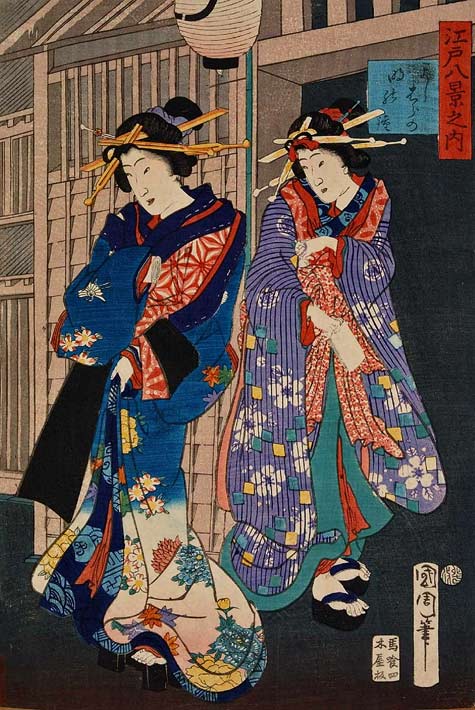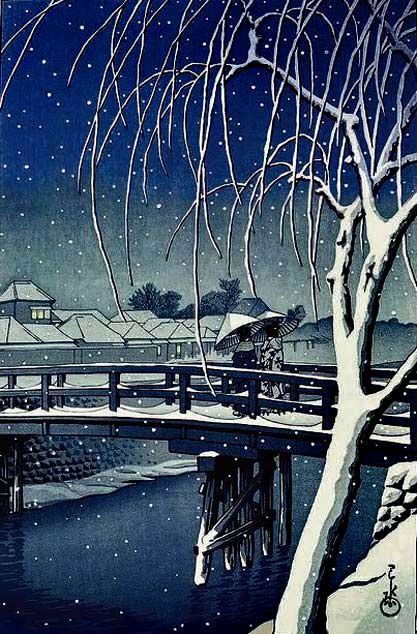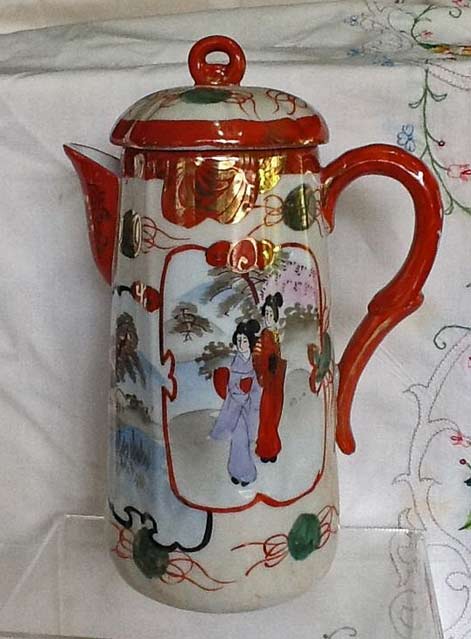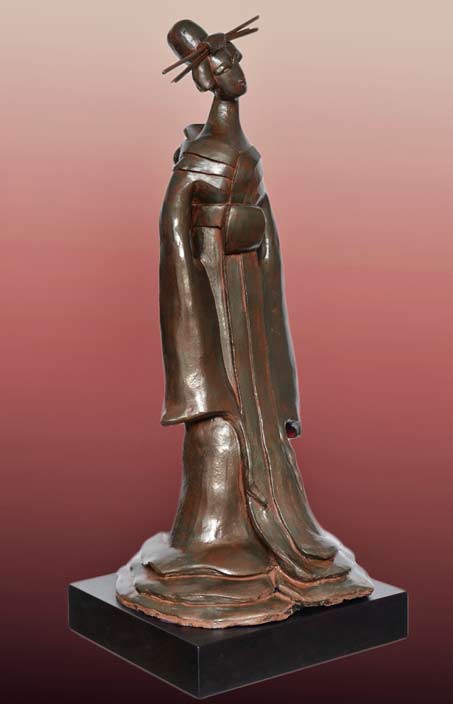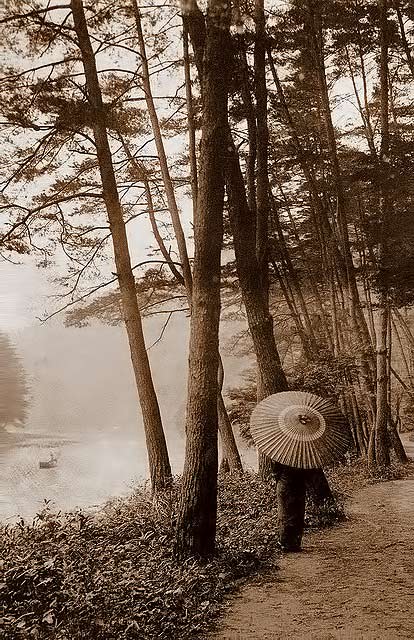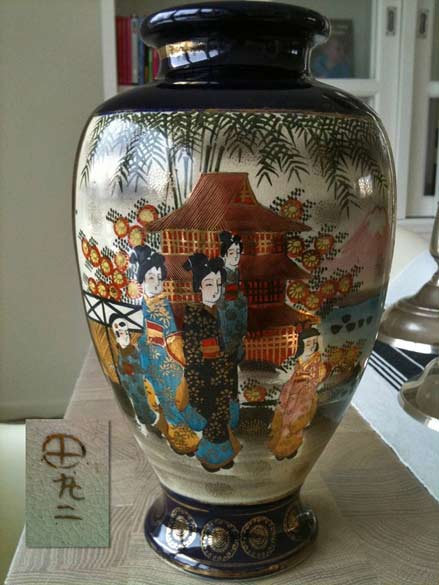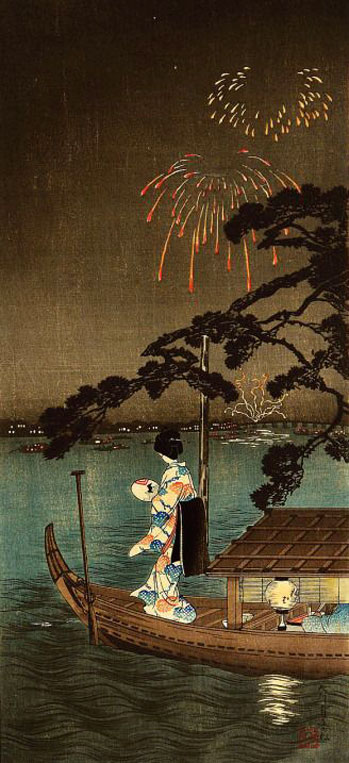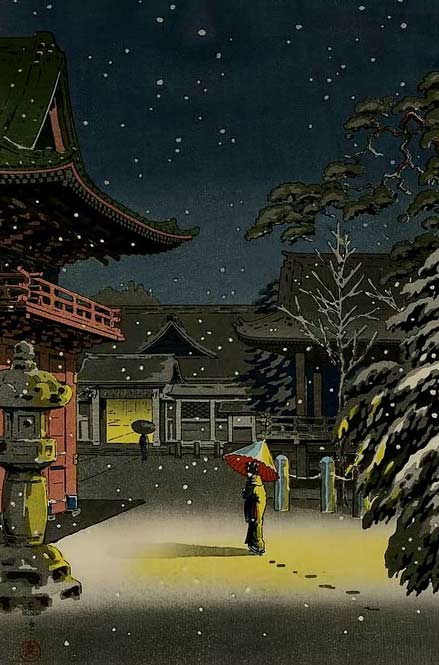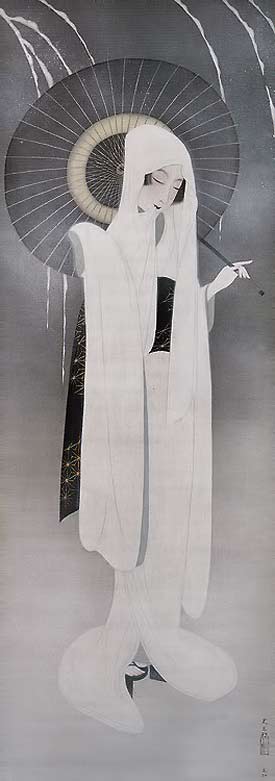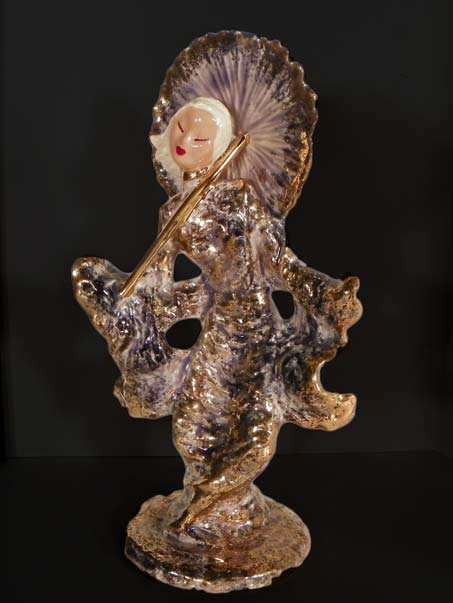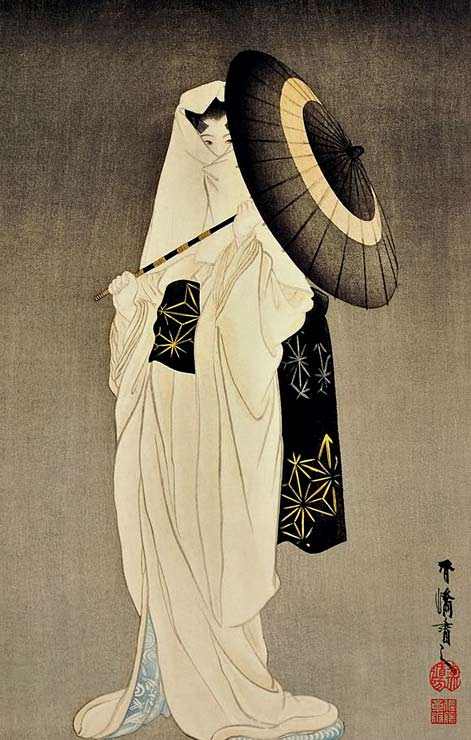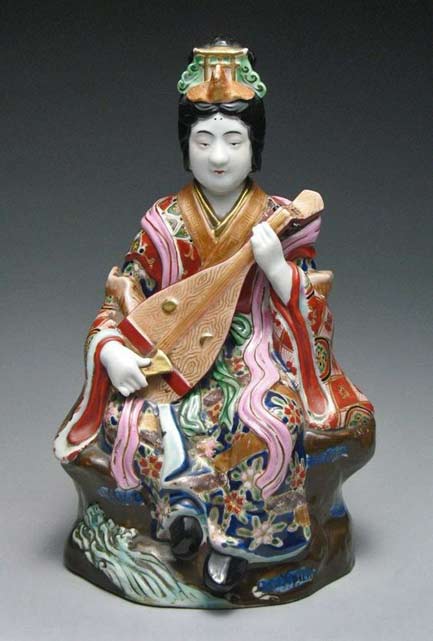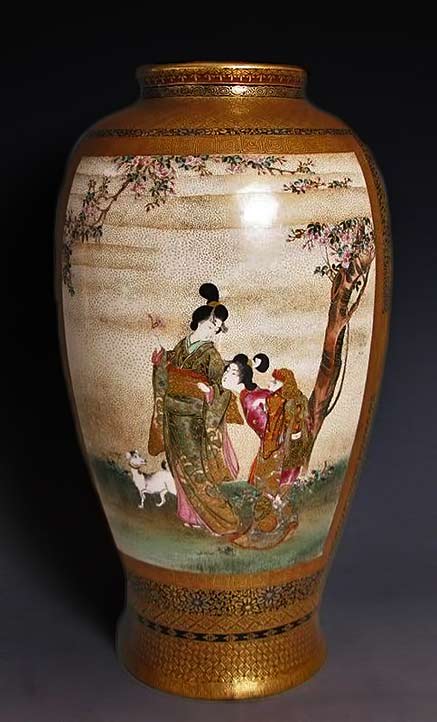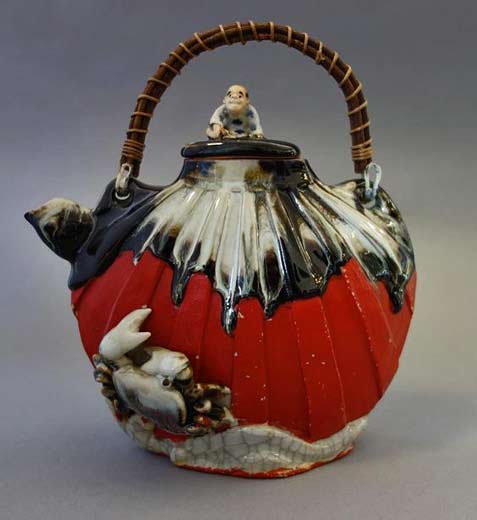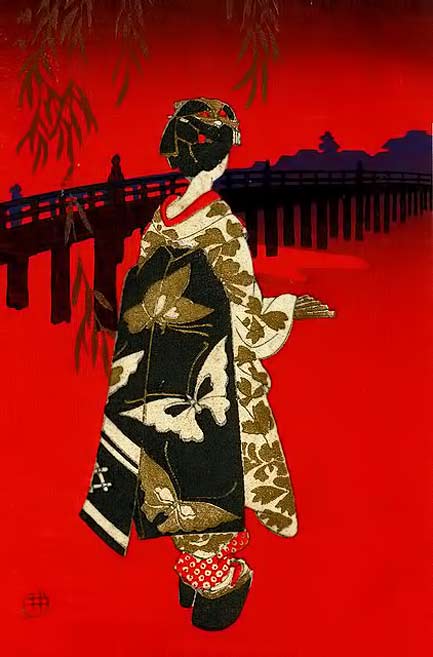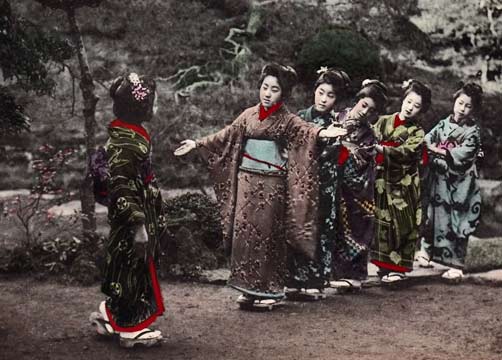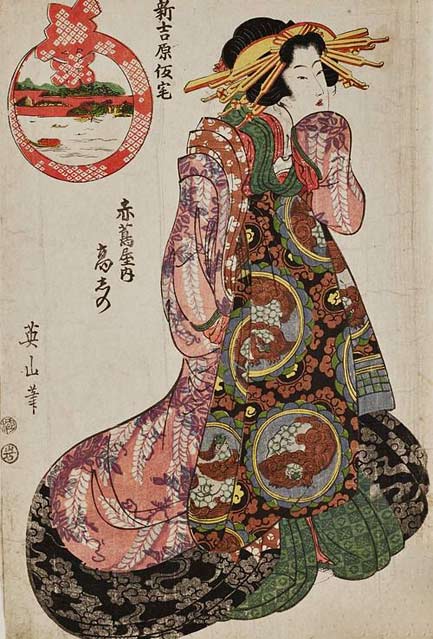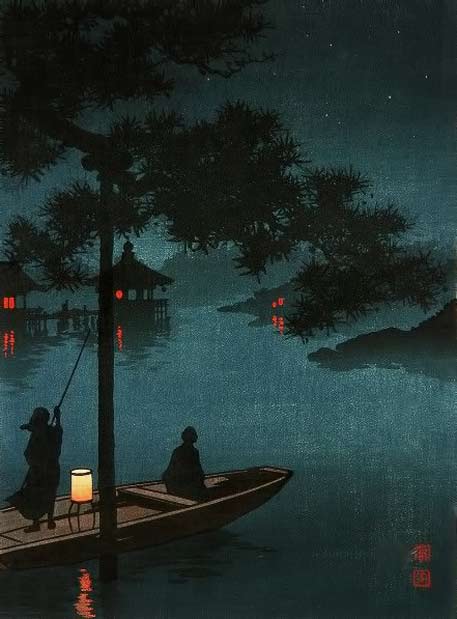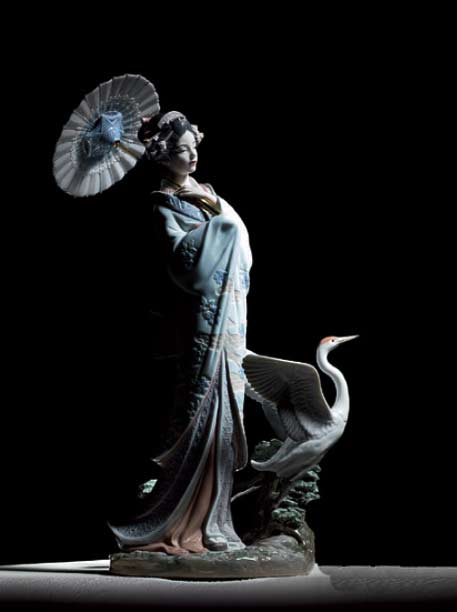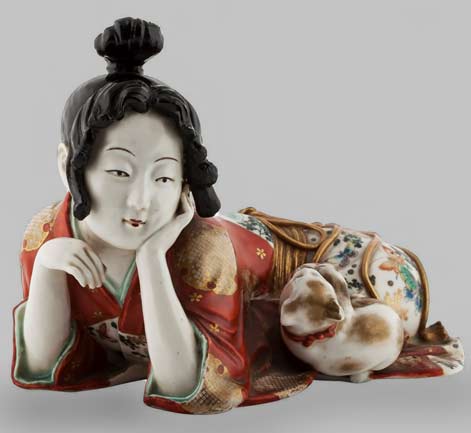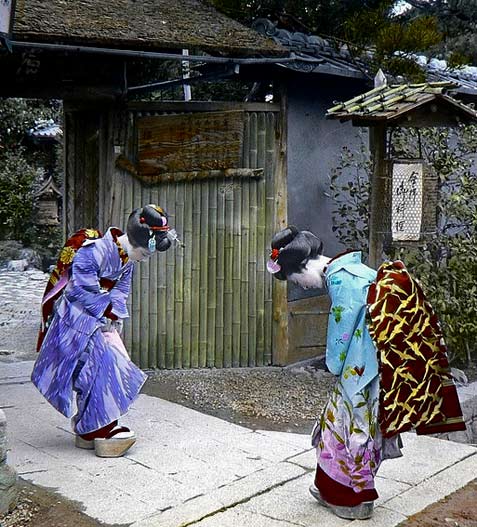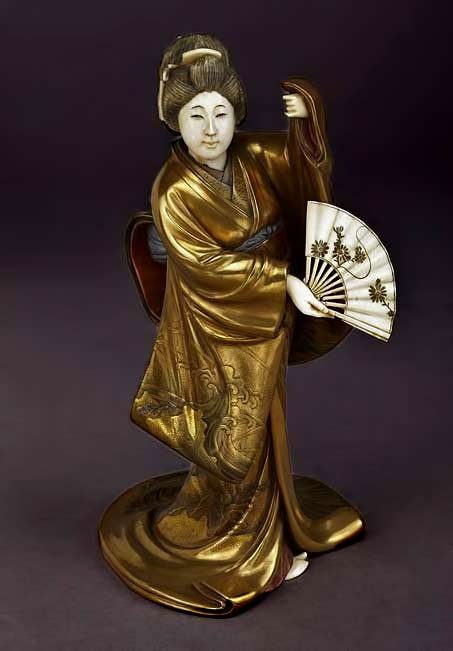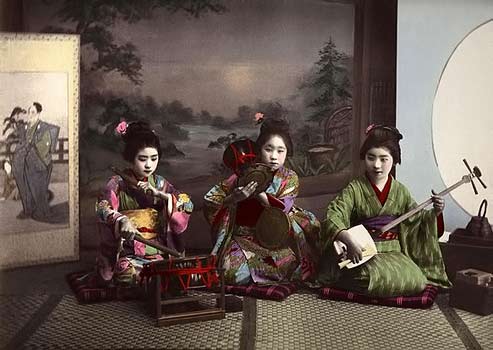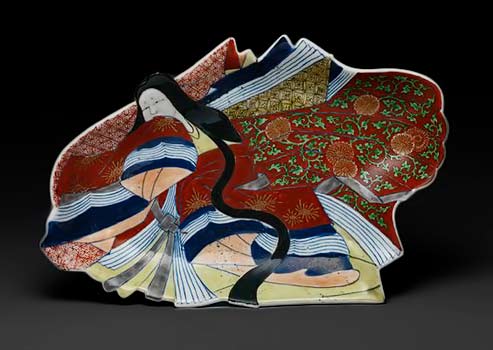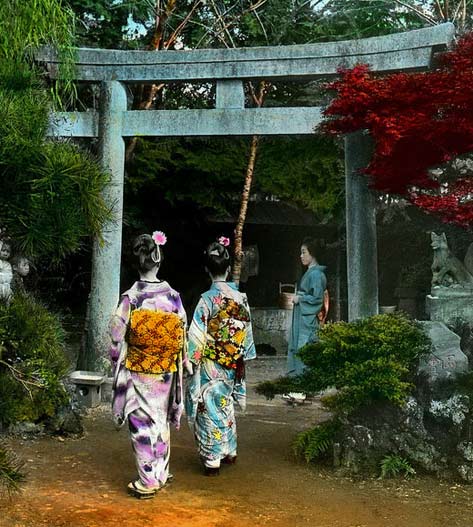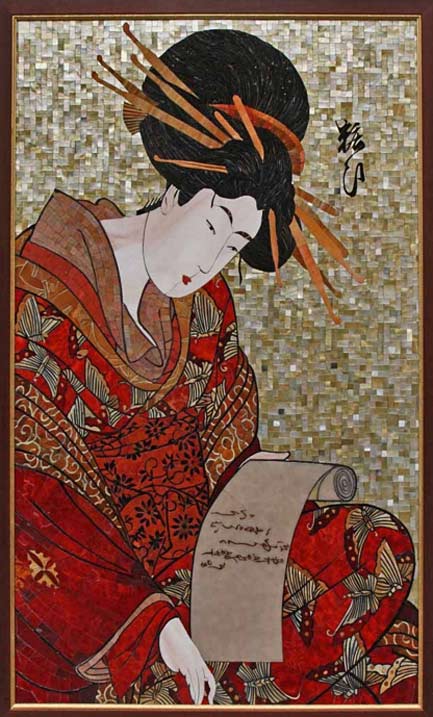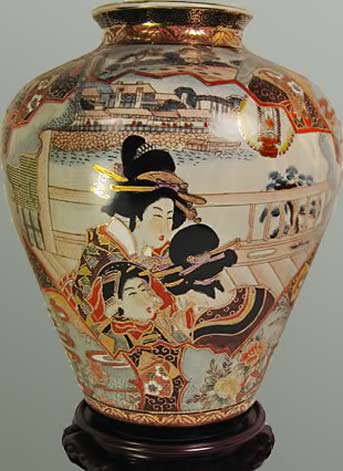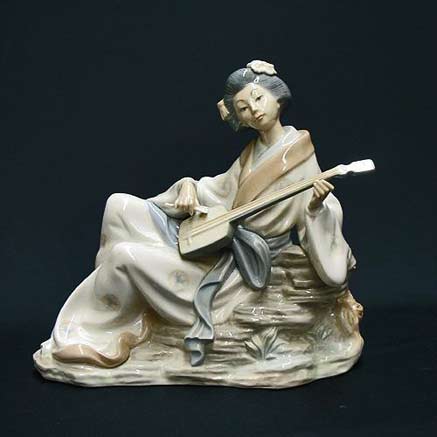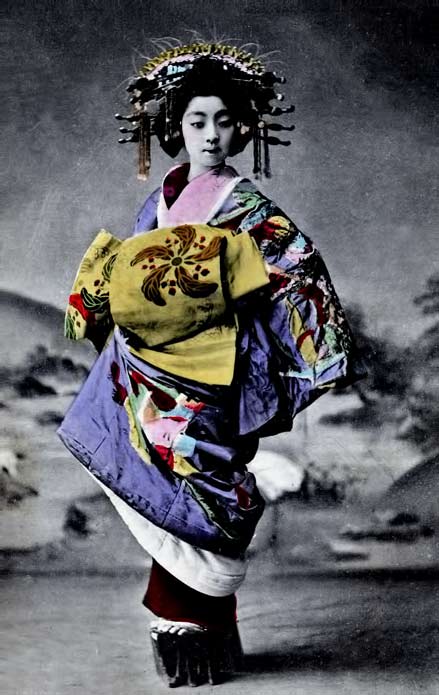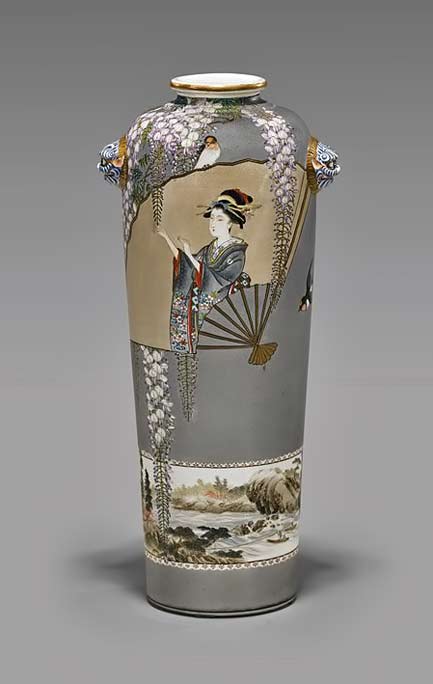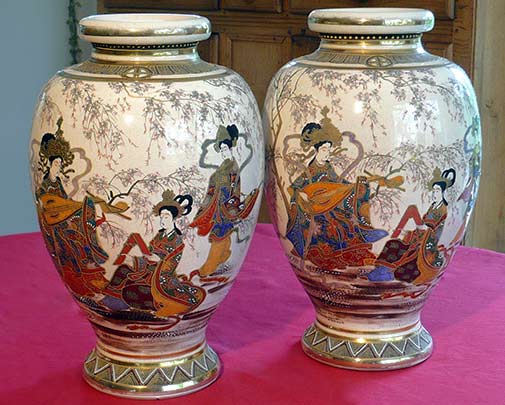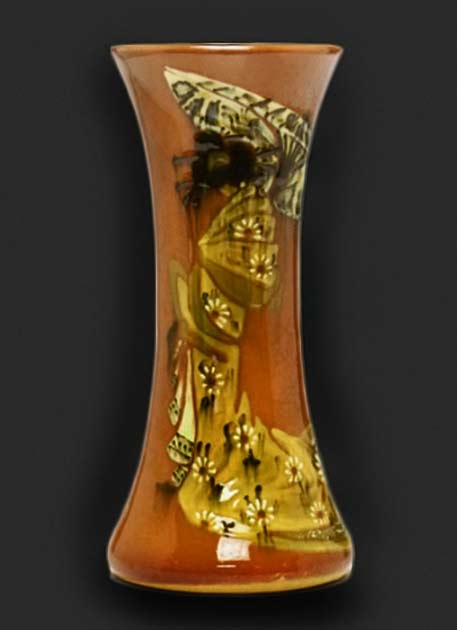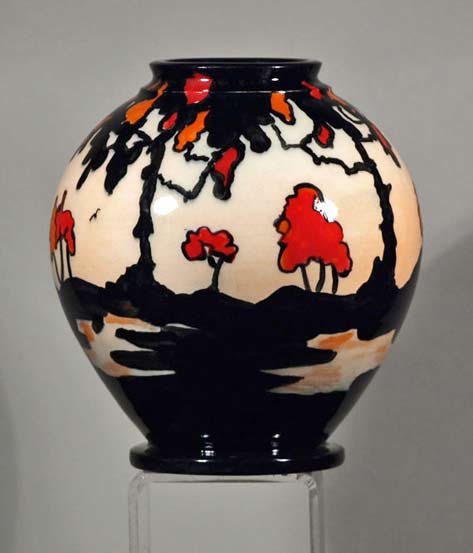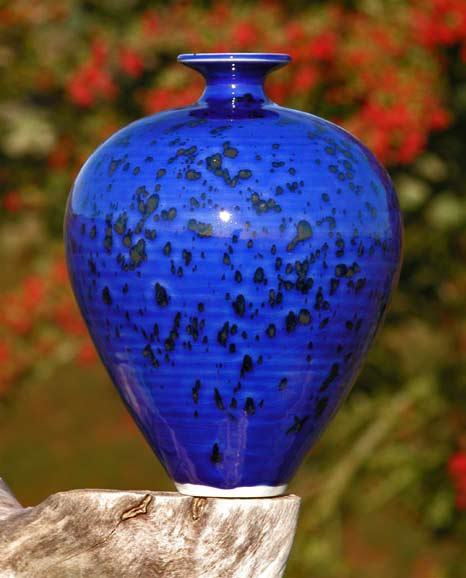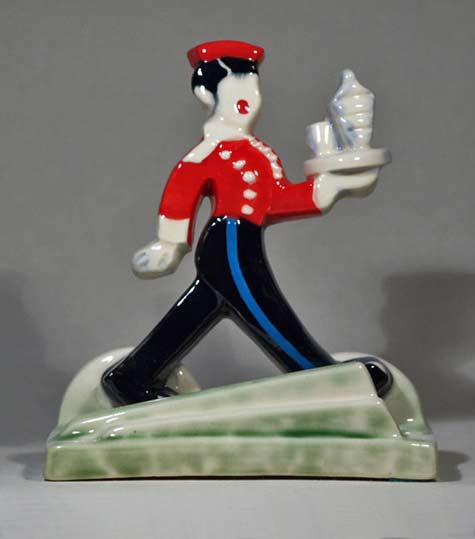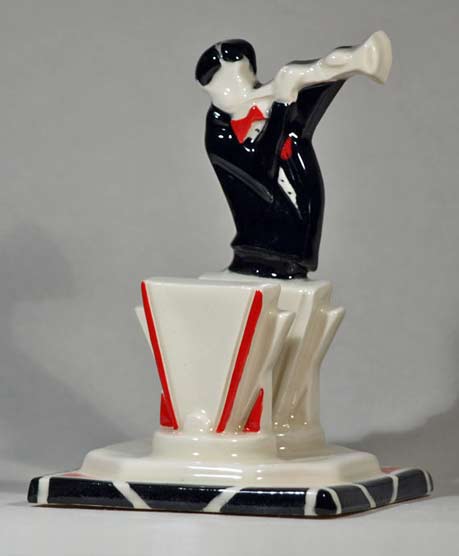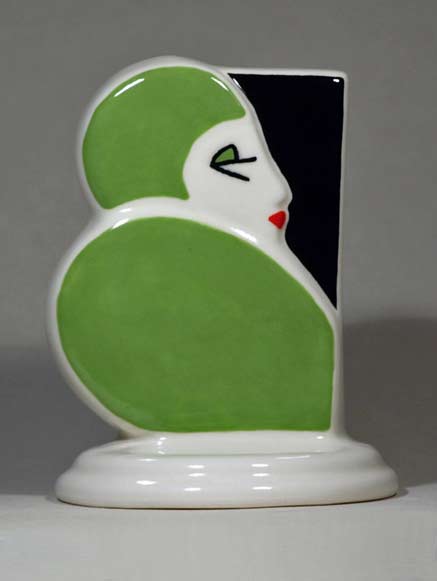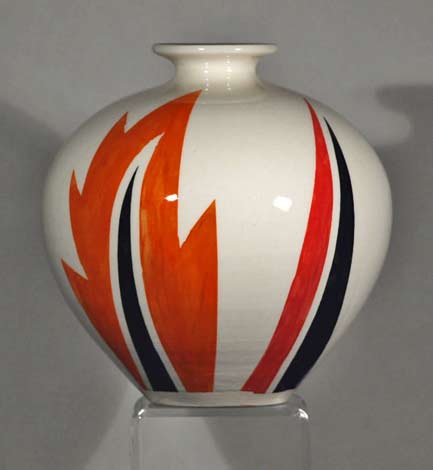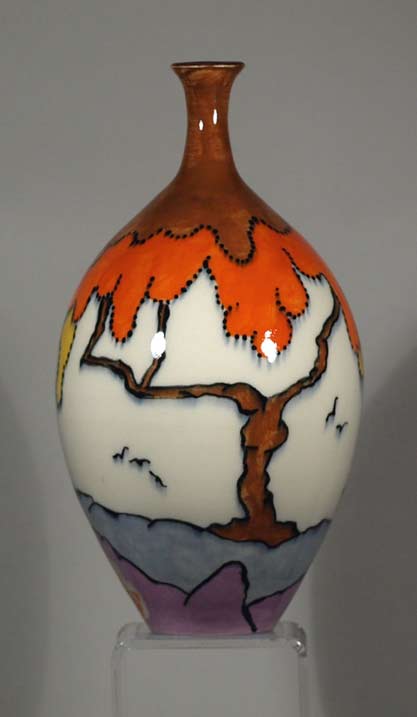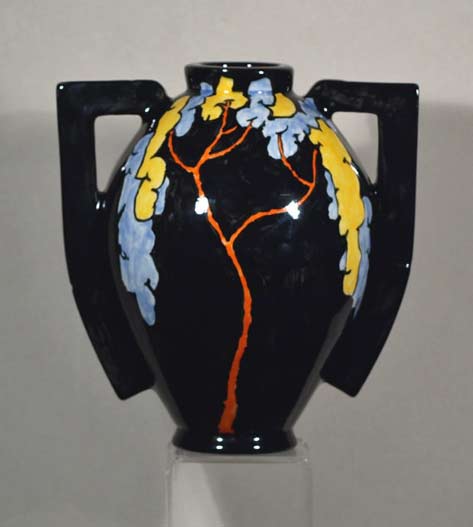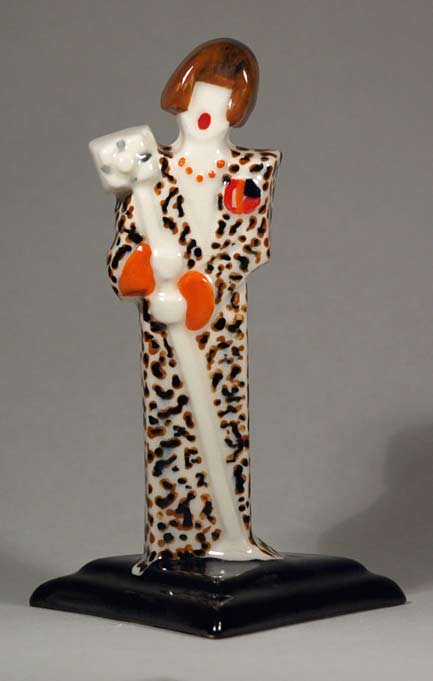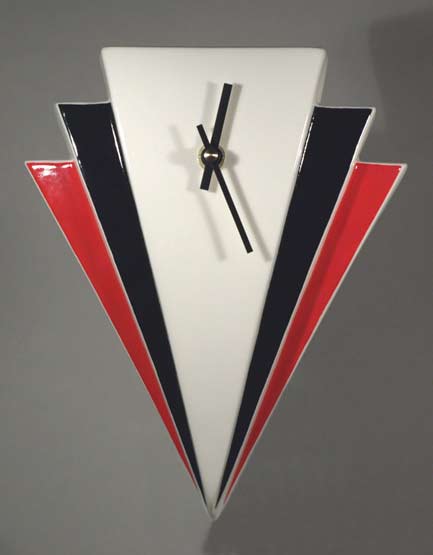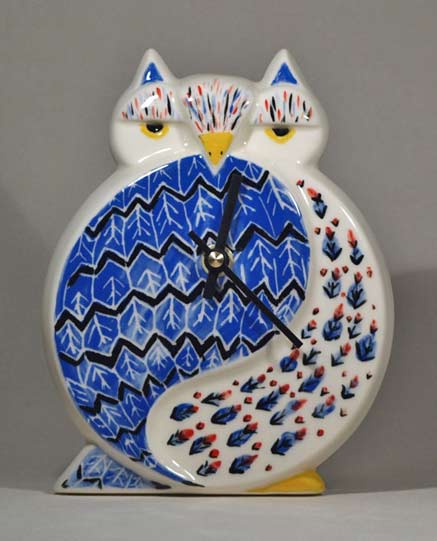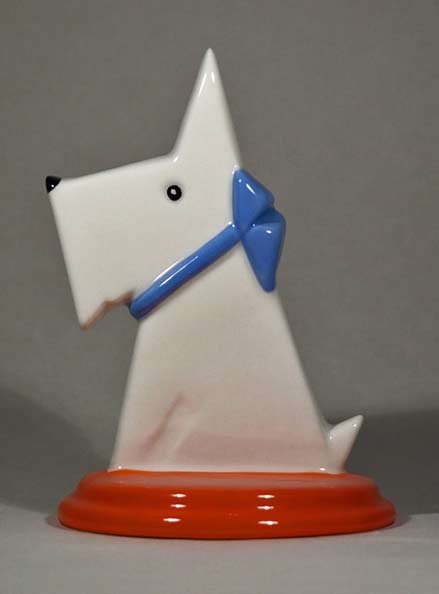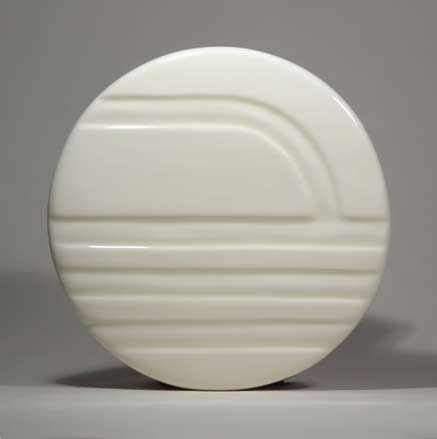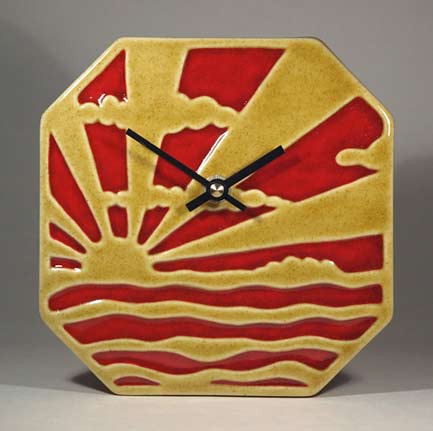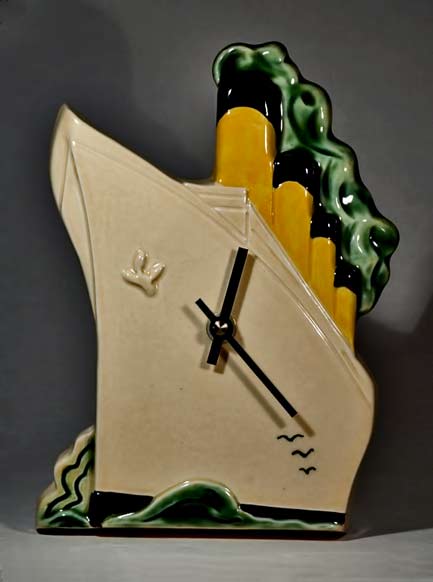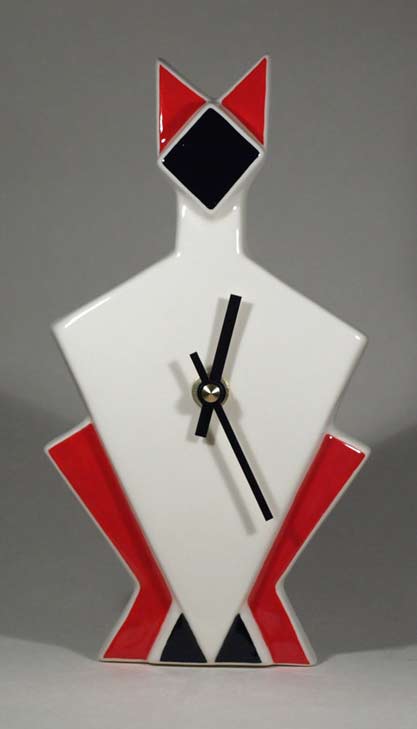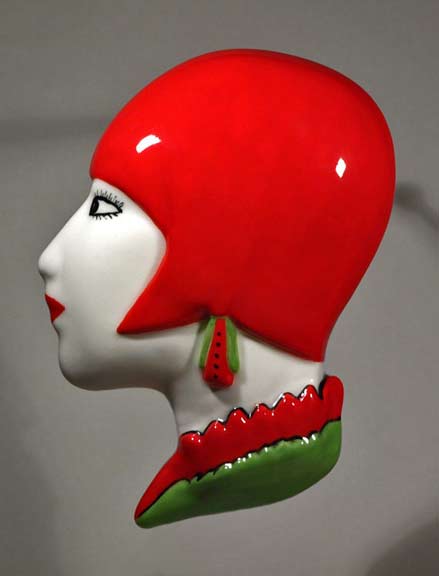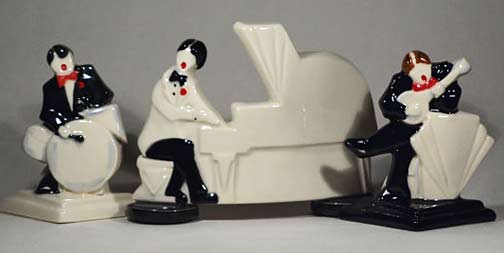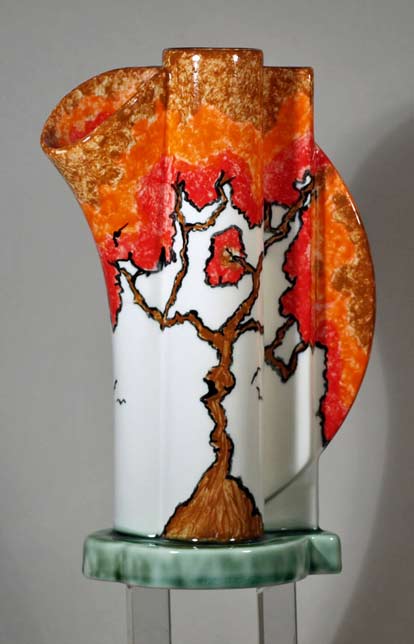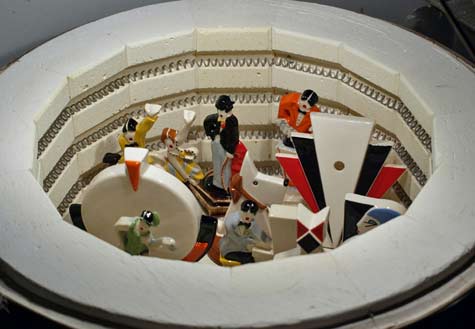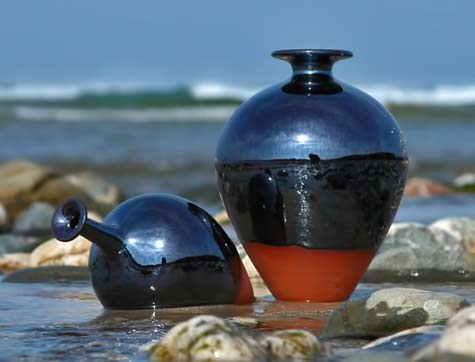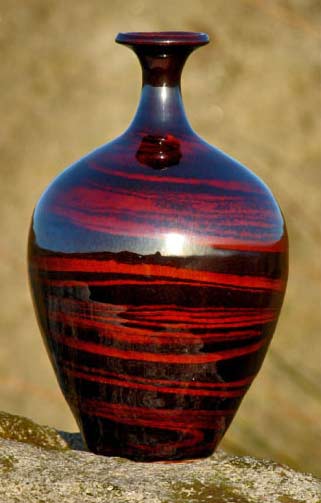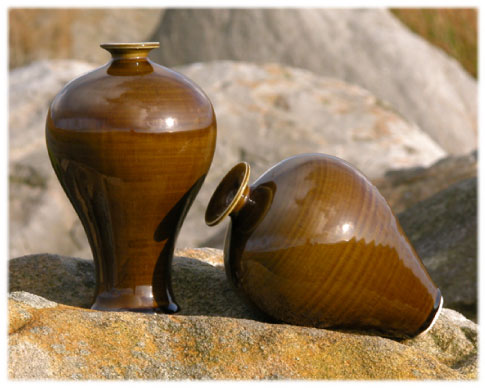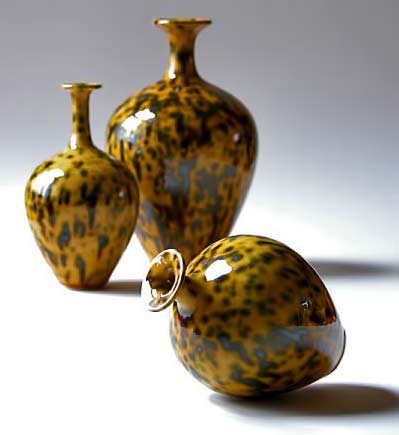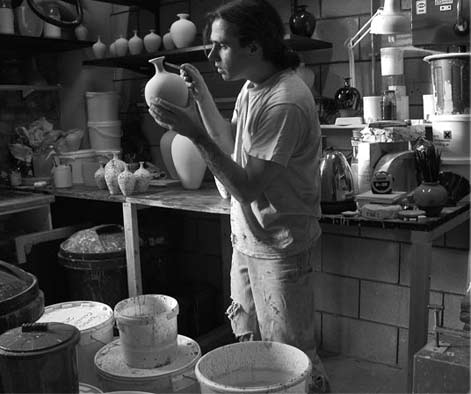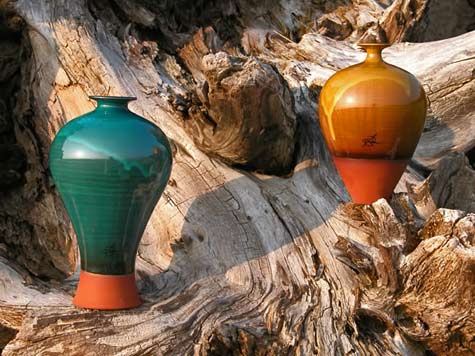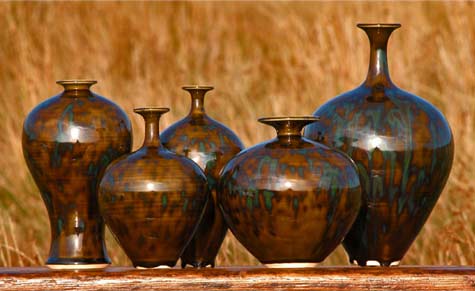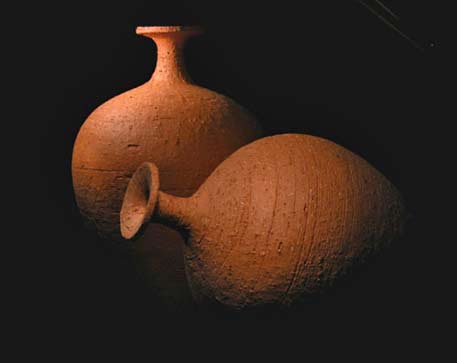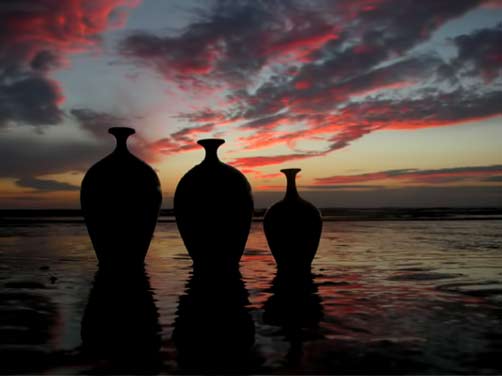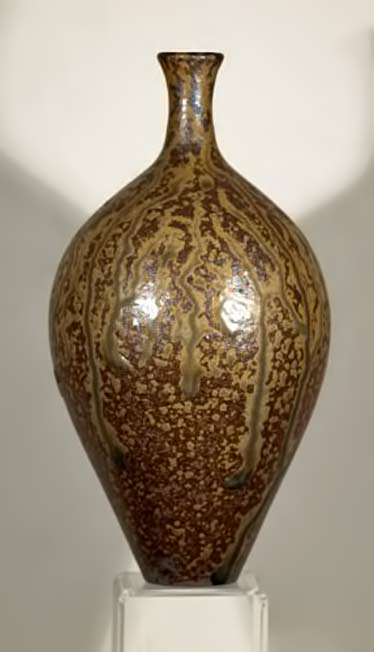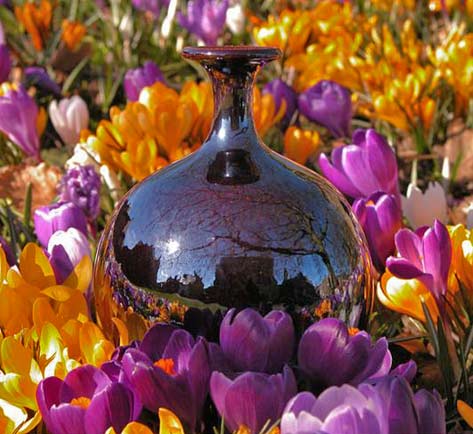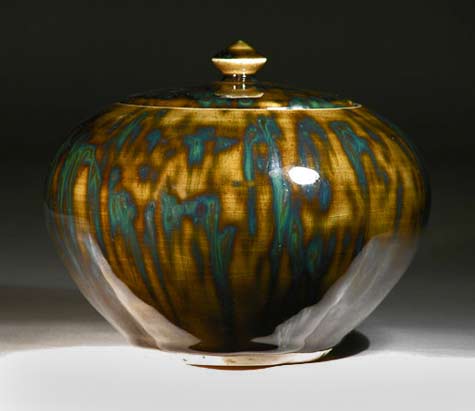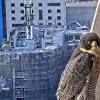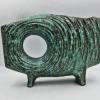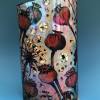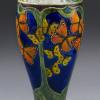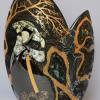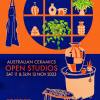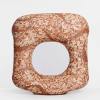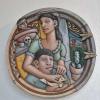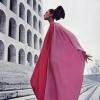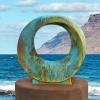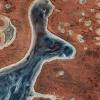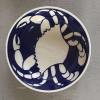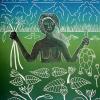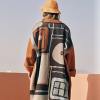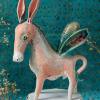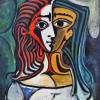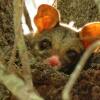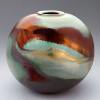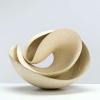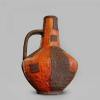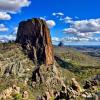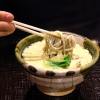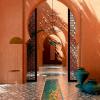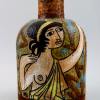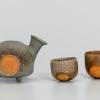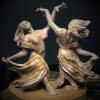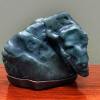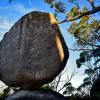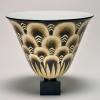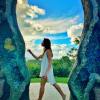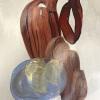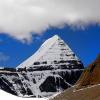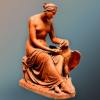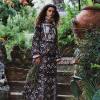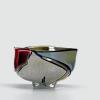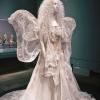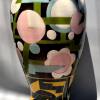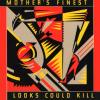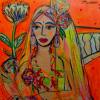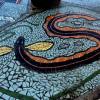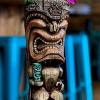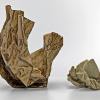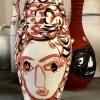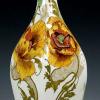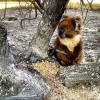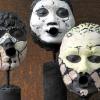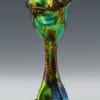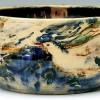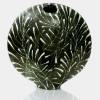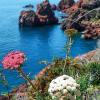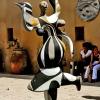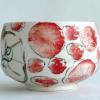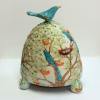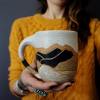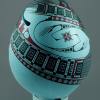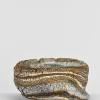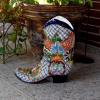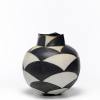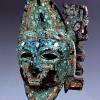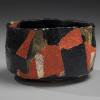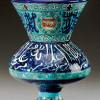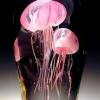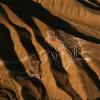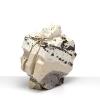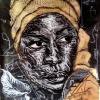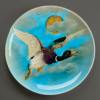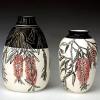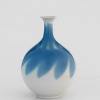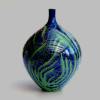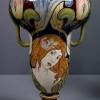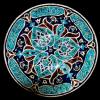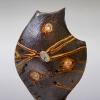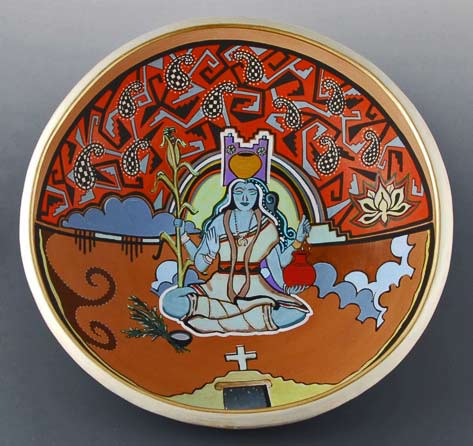
‘Lakshmi open bowl’ by Susan Folwell (Santa-Clara) and Les Namingha (Hopi Tewa Zuni)
Art’s universal language of creativity and spirit.
In India, Tibet, Nepal and other Eastern countries they have rituals to enliven the spirit of a work of art after it has been created. To the Hindus this is known as Abhisheka, also called Abhishekam. This is conducted by Brahmins who pour libations on the image of the deity being worshiped, amidst the chanting of mantras. Usually, offerings such as milk, yogurt, ghee, honey, sesame oil, rosewater, sandalwood paste and other perfume oils may be used, along with other offerings such as flowers, depending on the type of ceremony being performed. These rituals are routinely performed in Hindu, Buddhist and Jain temples. This is believed to create a purified ambience and transform the consciousness projected by the piece. Christianity also performs similar ceremonies with candles, incense and prayer to its saints and deities, to purify the atmosphere and objects of worship. Powerful religious imagery and symbols have been utilized over the ages with the intention of uplifting the atmosphere and spirit.
Artists, through their own intensity towards their objects of creation, can also project a degree of consciousness into their work, which can linger for a long time, sometimes indefinitely. This can also be influenced by the subject matter and the degree of personal emotional involvement. Long periods of concentration on a singular object are known to arouse meditative states that can lead to a blissful consciousness and even rapture. Prolonged devotion, an inspired focus on beauty and even fatigue can trigger a transcendence and elevated creativity.
The reverence of Japanese and Korean artists towards established traditions and their recognition of cosmic factors, such as the interplay between Heaven and Earth, are a factor in the spiritual resonance of their art. Awareness of the alignment between form, perspective, colour and textures to the forces of yin and yang sometimes act as a guide to their creative decisions. A meditative detachment from internal emotions can also introduce an alternate perspective where visual stimuli is interpreted differently and art created in this state tends to have a calming effect.
Some works of art can have a deeply spiritual impact on viewers even though the artist was completely oblivious to this quality during the process of creation. The merging of the metaphysical with the physical in art is unfathomable, where a single stroke or action can act as a catalyst.
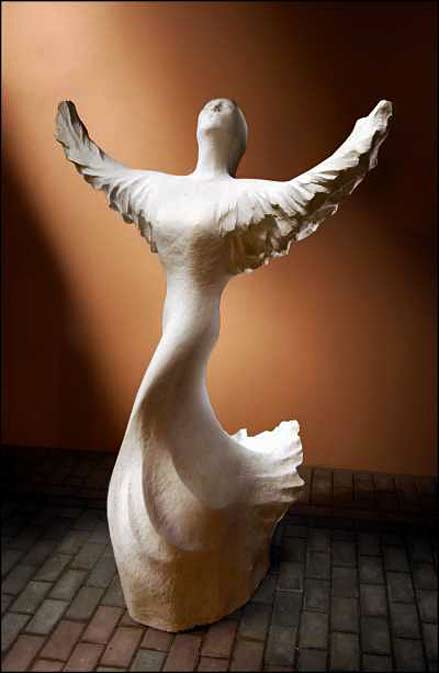
‘Ariel 3’ – Ginger Gilmore
Artists draw on a myriad of influences in their creative expression. Innate inspiration can flow from endless sources :- childhood memories, nature, a random encounter with a person on the street, landscapes, spirituality, animals, music, to name a few. It is also possible to draw on an inner inspiration independent of any external stimuli. Artists, by virtue of their sensitivity and refined awareness can connect with their inner spirit and beauty and channel it into their art. Perception can be altered by awareness which can also influence the intensity of projection. The same can be said for belief and conviction.
Artistic instincts can be stifled and repressed by external factors, much to the detriment of a culture and an individual. Conversely they can be stimulated through interaction with other artists and mentors and also by powerful artistic statements from gifted artists filled with freedom of expression. Spiritual concepts and practices can also act as a stimulus towards creativity. Here, a selection of artists is considered from a spiritual perspective, including the diversity of influences that have provided the impetus to drive their creativity.
Hawaii
Joey Chiarello (Mojomaker1) – “growing up, I have always had a great appreciation of the many forms and capabilities of the entire animal kingdom. I am captivated by the stillness of the instinctual nature of each diverse creature. Through the Zen of simple being I find my answers. I can have a goal in mind however I must be open to the clay too guide me along to achieve my most accurate form of personal expression. When I give in, creatures seem to flow from my fingertips.
Currently I am working with narrative character creation and interaction. I love to see and study many old ancient designs and interpretations. The content includes a wide range of Native, Asian, folklore and spirituality as paintings drawings and tattoos. I use these age-old 2-D designs as inspiration to make 3-D interpretations.”
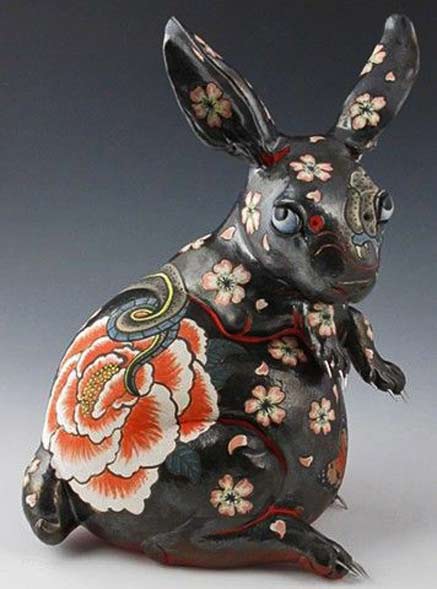
‘Acceptance’ – Joey Chiarello
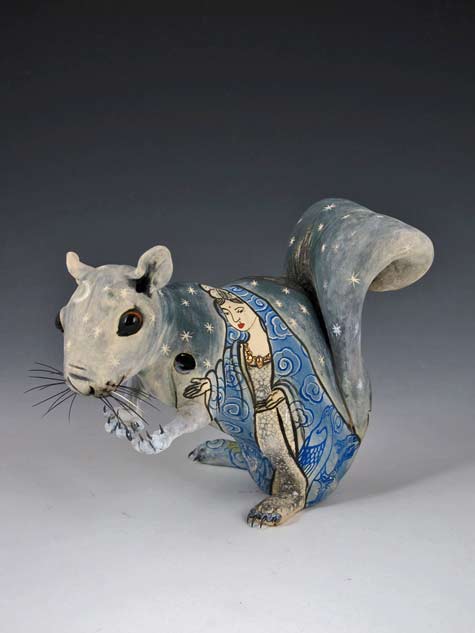
‘The Dawn of Compassion’ ceramic squirrel — Joey Chiarello
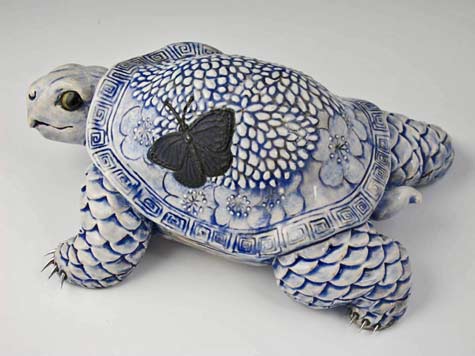
‘Eternal Inspiration’ ceramic tortoise sculpture – by Joey Chiarello
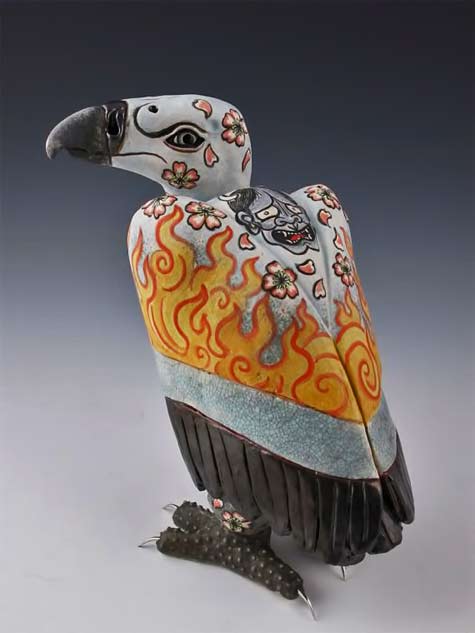
‘The Cleaner’ – Joey Chiarello
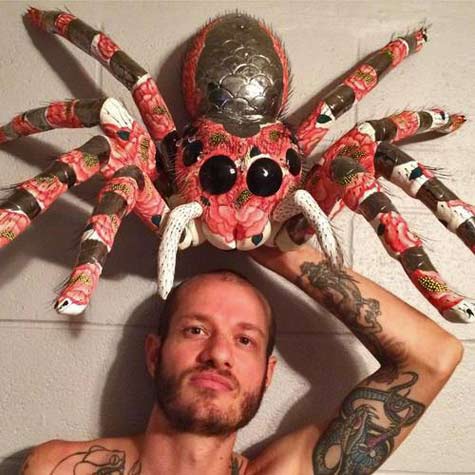
Joey Chiarello with his ‘Simran the Sacred Jumping Spider’ sculpture.
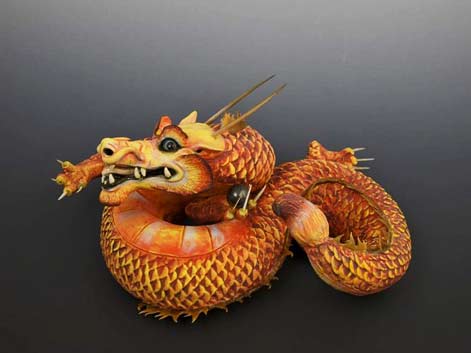
‘The sound of compassion’ ceramic dragon – Joey Chiarello
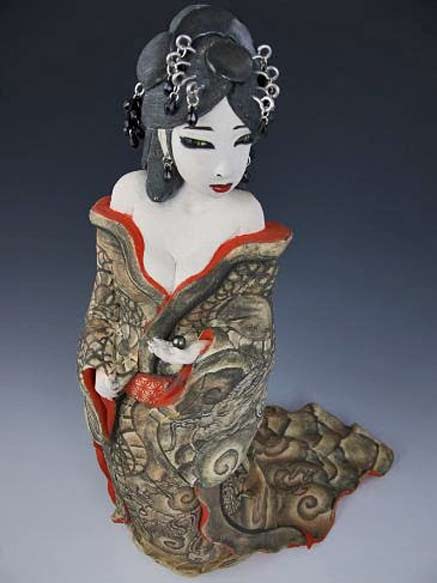
Raku Geisha sculpture – Joey Chiarello
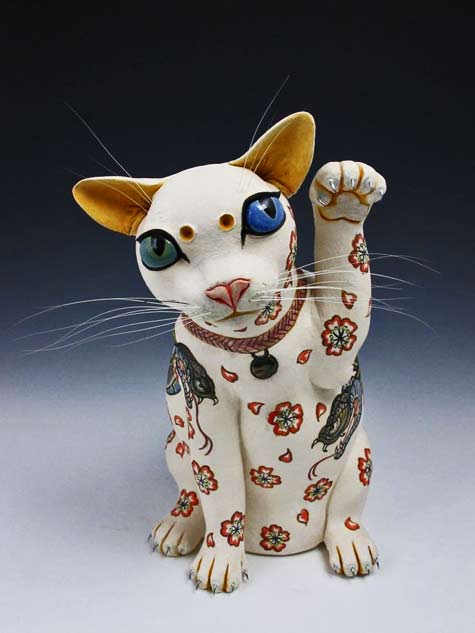
‘Live in the Now’ lucky cat sculpture figurine – Joey Chiarello
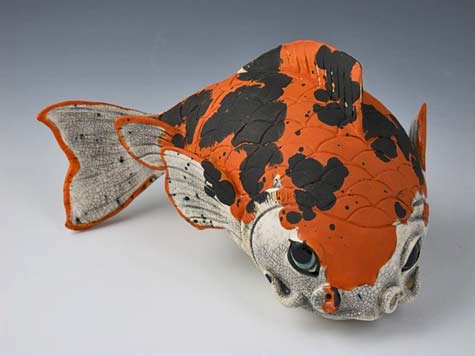
‘Good fortune Koi’ – Joey Chiarello
USA
Poet, potter and a 30 year practitioner of Zen in the Korean tradition.
‘Creativity is, yes, the person, but as he/she intersects with all the other variables of present moment experience. Meeting at the cross-hairs of lived experience, the voice that emerges from the individual is the potential for creative force. In both of my mediums I rarely start with a topic or idea. I start with music — in poetry this would be the particular music of a word or phrase as it appears in my mind. In clay, it would be the physical music of clay’.
“I am interested in showing the flow of engagement, which may reflect vulnerability and fear, yet finds stillness within that. The only way the absolute can come through is through the subjective.” –Anita Feng
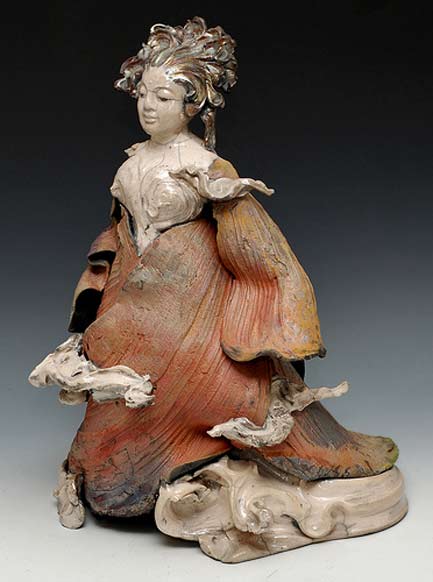
Raku Quan Yin sculpture – ‘Compassion in the Clouds’ – Anita Feng
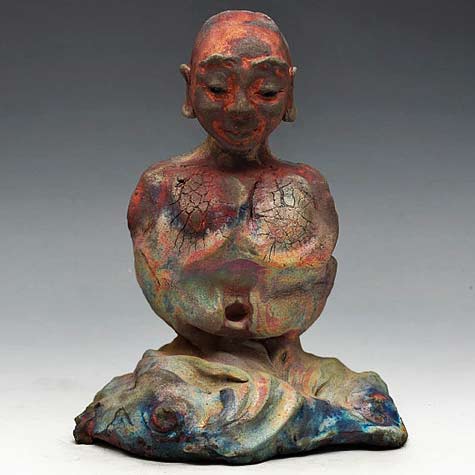
‘Buddha Seated in Meditation’ — Anita Feng
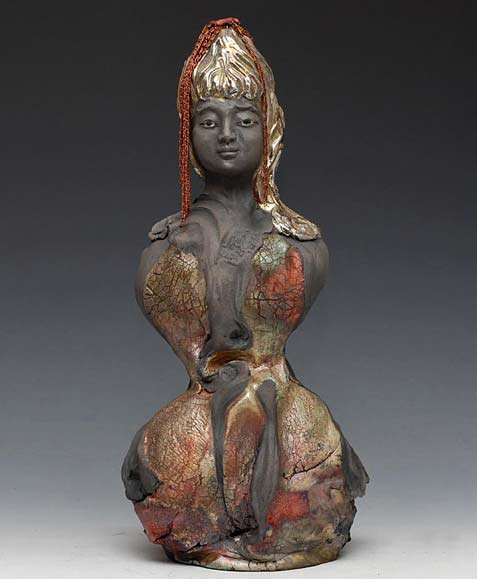
‘Buddha Kwan Yin Goddess Statue With Chains’ – Anita Feng
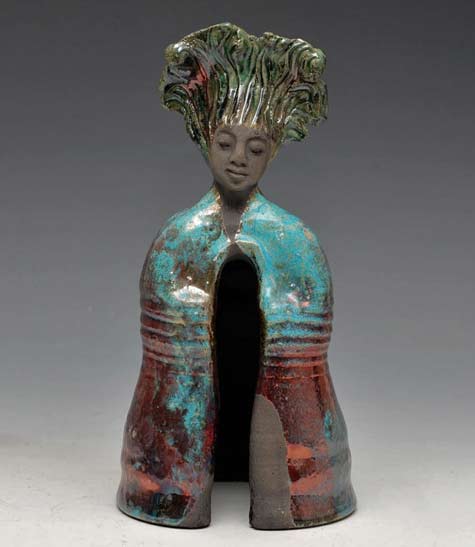
Anita Feng – ‘Standing Buddha Statue in Turquoise Red Copper Raku’
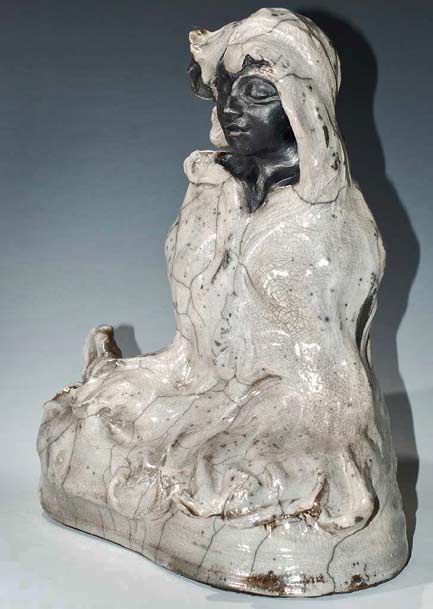
‘Black Woman Buddha’ — Anita Feng
Also see the other veniceclayartists post on Anita Feng here
Anita’s poetry books are: Internal Strategies and Sadie and Mendel
William Morris
USA
Morris gathers much of his inspiration from ancient cultures from around the world – Egyptian, Asian, Native American – all peoples who respected and admired the land they inhabited. Because of this, Morris’s artwork has become something all its own: culturally distinct and yet familiar to all cultures. His pieces embody a spiritual quality that sharply contrasts old beliefs with those of the modern world. “Art broadly speaking is that which invites us into contemplation. Art arrests attention, it is an important service to the soul.”
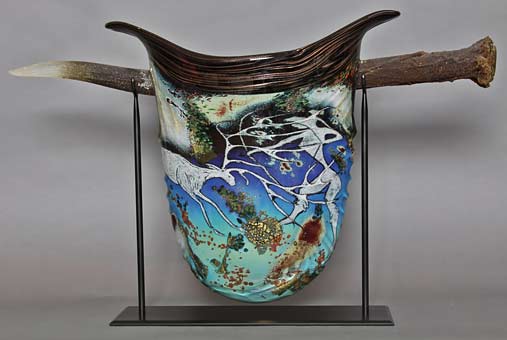
‘Suspended Artifact’ – William Morris, USA
1991
Wolfs
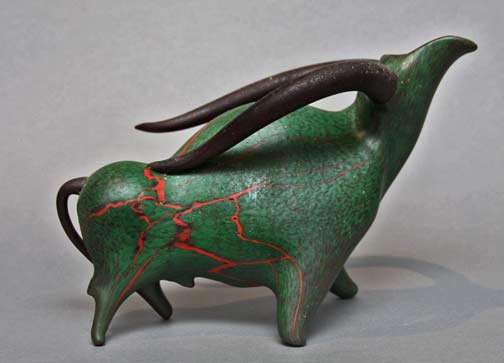
‘Rhyton Bull’ – William Morris
USA
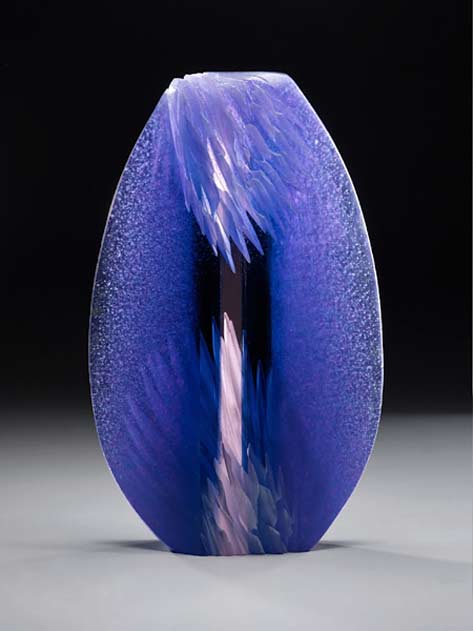
‘Window 15’ – Alex Bernstein
Artist Alex Bernstein presents a refreshing exploration of visual form and storytelling by combining metaphor with the power and sensuality of sculpted glass. His glass sculptures provide the viewer with intimate narrative landscapes, drawn from light, form and color. Alex explores ideas about the passage of time and the processes of creation and transformation.
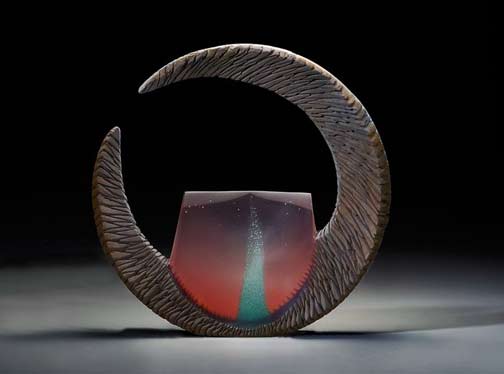
‘Copper Window’, Cast & cut glass, fused steel – Alex Bernstein
2015, Habitat Galleries
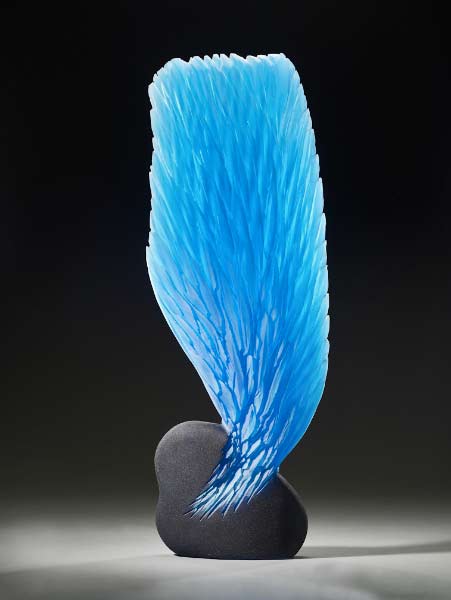
Alex Bernstein
…
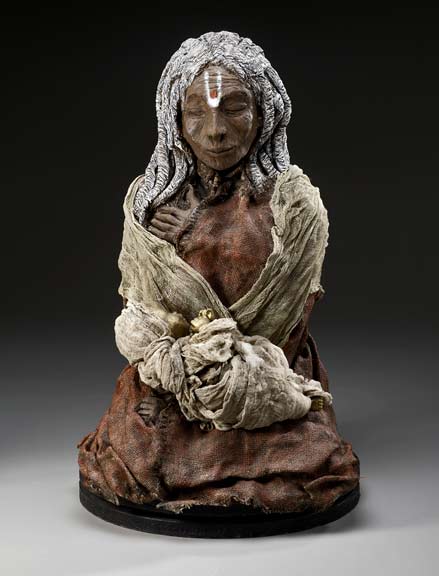
‘Ancient Consecration’ – Kat McIver
“I experience my art as a radical response and prayer to life. Each piece develops as a deep, evolutionary process, expressing my personal spiritual journey and the emotional vicissitudes of beingness.”
…
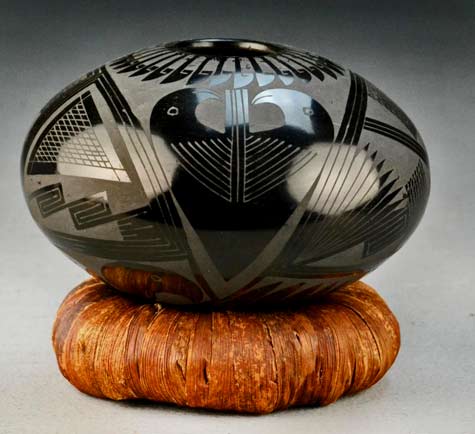
Seed jar with four polished birds and geometric designs against a buff black ground by Andrew Octavio
Jonathan Middlemiss
Britain
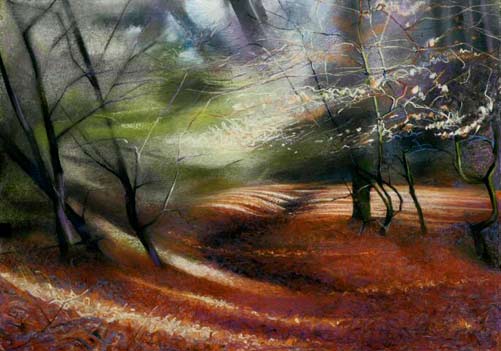
‘Beech path, dancing light’ – Jonathan Middlemiss, UK
“Meditation on the ‘Tree of Life’ of the Western Mystery tradition underpinned my ceramics for most of my career. I spent several years absorbing the influences of other spiritual traditions, particularly Vajrayana Buddhism and shamanism. Painting and drawings in mixed media are a contemplation on these influences ” Jonathan Middlemiss
“I am inspired by experiences of immersion in landscape and the opportunity to go to places where the wild lands speak in a way I understood as a child in the Yorkshire Dales and later on the North Yorkshire Moors. The experience of re-tracing my father’s droving routes to market, listening to the sounds of the wooded ghylls and waterfalls or walking the upland peat bogs and watching the wildlife of these now precious habitats… all become starting points for new paintings. Here I sense the portals to a greater spiritual reality that we have become culturally alienated from and dismiss as irrational, and here are opportunities to remember to appreciate our experience of the world as magical.”
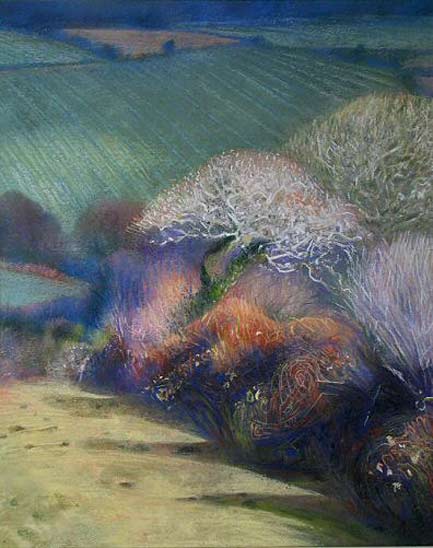
‘Pools of light’ – Jon Middlemiss
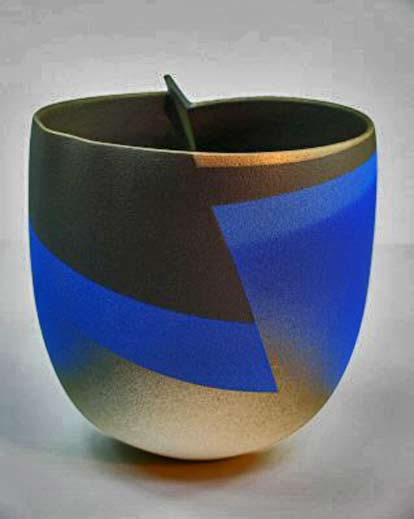
‘Rippled form blue and gold’ – Jon Middlemiss
Anne Shulenberger
“Being creative has always been very important to me. I believe that being creative is what connects each of us with the highest power in the universe (God/Goddess/All That Is). When immersed in creating artwork I often feel a deep connection with all sentient beings and a strong conviction that what I am making is of utmost importance to the world. This feeling of being part of something much bigger than my own individual self is what I am always striving for. It gives my creative struggle and my work meaning and makes my life worth living. I hope to communicate this powerful feeling of connection to all who come into contact with what I have created.”
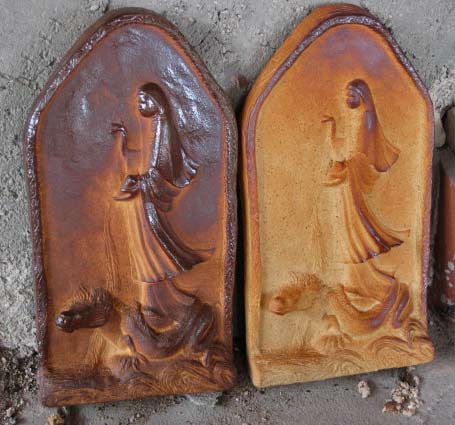
Kwan Yin riding a dragon wall panel – Anne Shulenberger
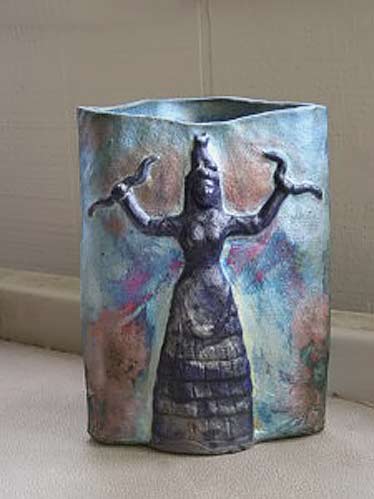
Snake Goddess raku vase- Anne Shulenberger
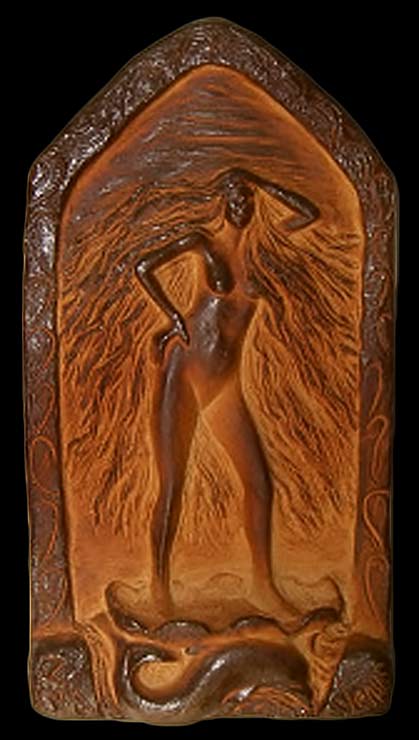
‘Venus’ raku ceramic panel – Anne Shulenberger
…
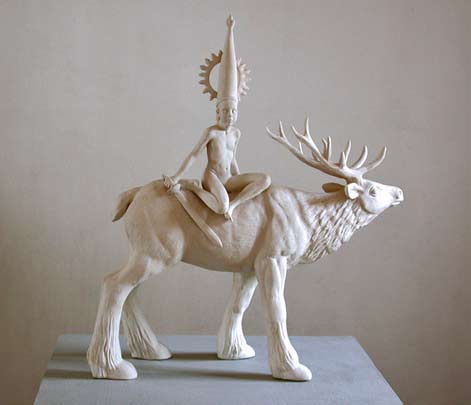
‘Durga In Montana’ – Tricia Cline
California
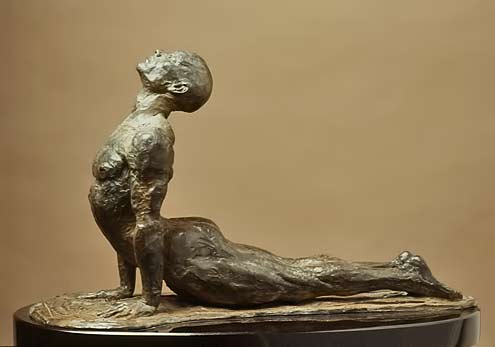
Metamorphosis series – ‘Emerging’ – Paige Bradley
‘I want to advocate healing and empowerment for people around the world. I want my art to be a forceful voice to help those who suffer from illness, repression, or exploitation. My sculptures express a depth and variety of the physical, the emotional, and the spiritual that we search for as a human race. Simultaneously, I want to provoke us to feel painful truths we keep bottled up inside. I want us to remember we are all the same. And, it is this understanding that can heal us all.’
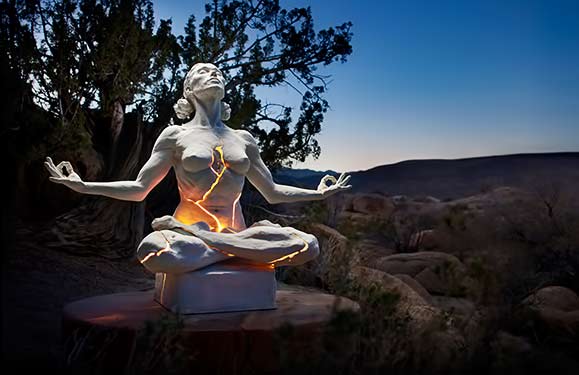
‘Expansion’ – Paige Bradley
‘From the moment we are born, the world tends to have a container already built for us to fit inside: A social security number, a gender, a race, a profession or an I.Q. I ponder if we are more defined by the container we are in, rather than what we are inside. Would we recognize ourselves if we could expand beyond our bodies? Would we still be able to exist if we were authentically ‘un-contained’?
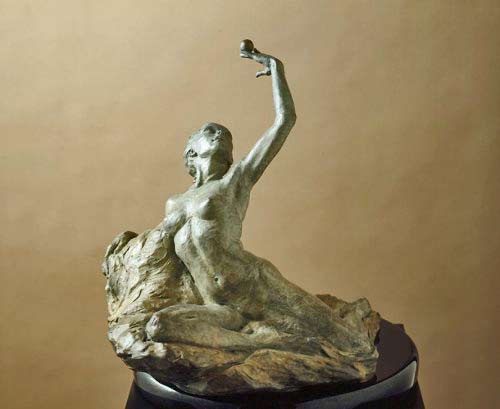
‘Breath’ – Paige Bradley
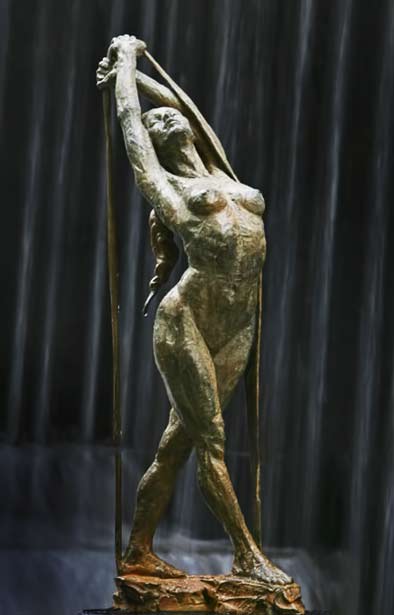
‘Release’ – Paige Bradley
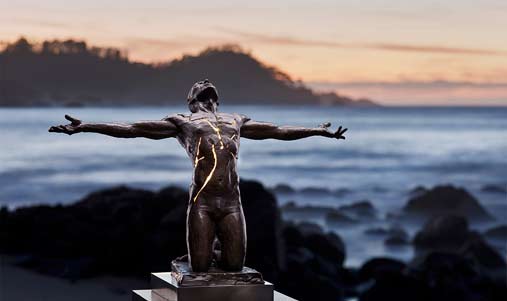
‘Illumination’ – Paige Bradley
…
France
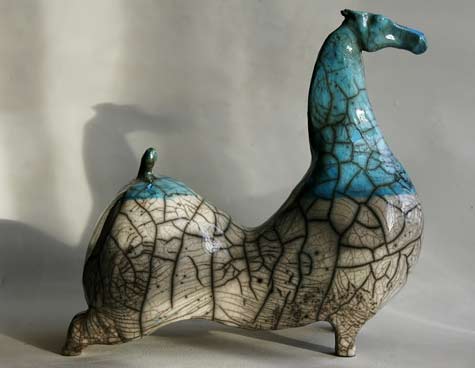
Raku Horse – Ilona Jo, Bordeaux
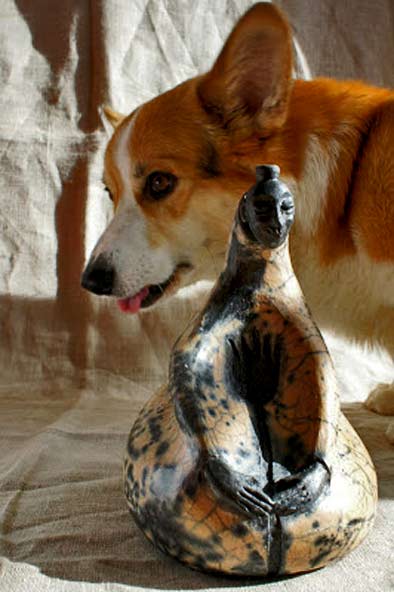
Zen, Dew, Earth – Ilona Jo
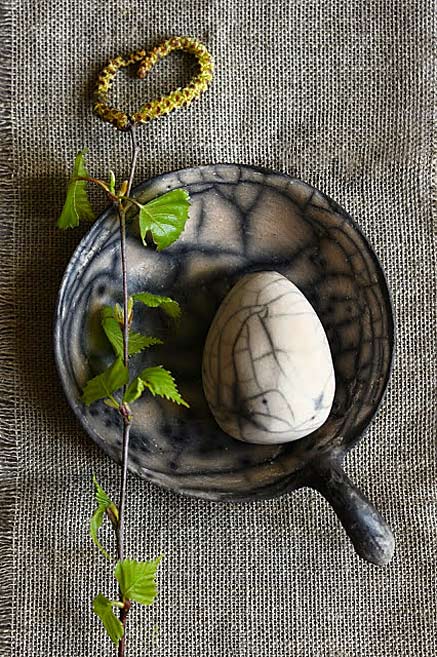
‘Happy Easter’ – Ilona Jo
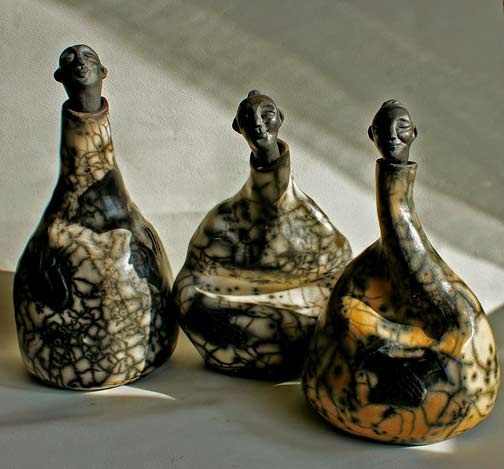
‘Meditation Trio’ – Ilona Jo
“All are naked raku. I took a lot of pleasure to shape…. they are serene, gentle, cheerful … except the last which resists a bit”
George Lafayette
USA
“I spent a few years in animation and maquette-making, and then became a real estate agent. After further exploration of my artistic desires, I realized that my passion was sculpture.
Inspirations for my sculptures come from my inner feelings about life, rebirth, and spiritual mysticism. They are the reflections and interpretation of my life experiences.”
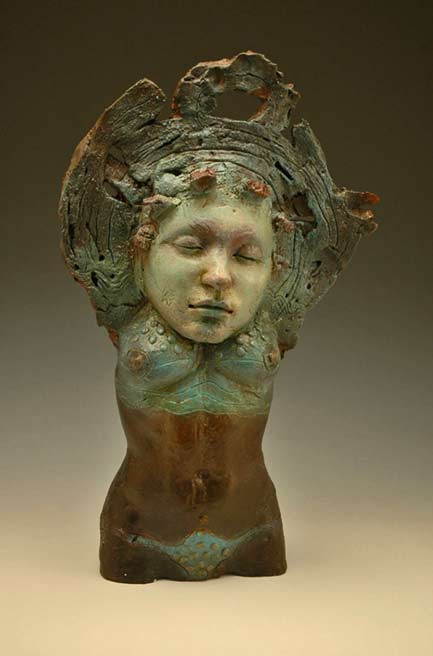
George Lafayette – ‘Dream time’
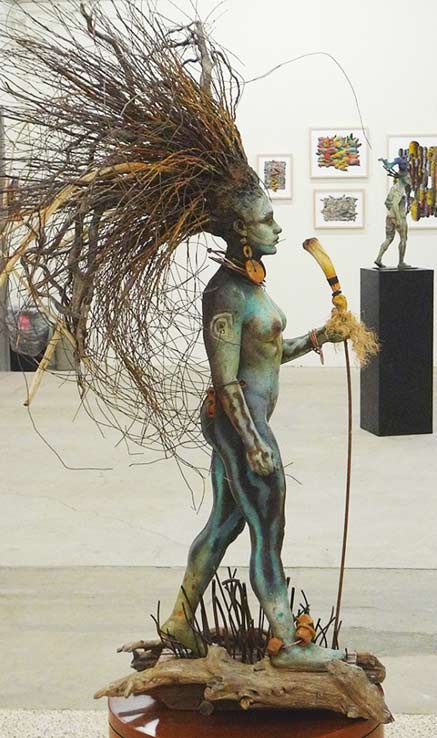
George Lafayette sculpture
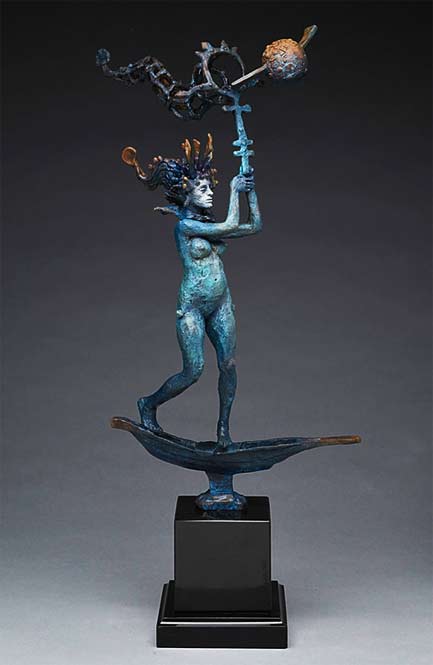
‘Dream Catcher on a boat’ – George Lafayette
…
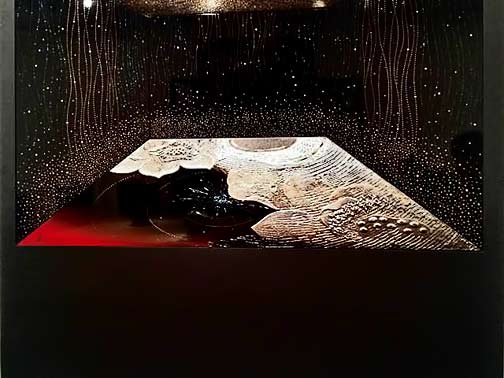
‘Room for Meditation’ – wall art – artist?
Hanoi Fine Arts Museum
…
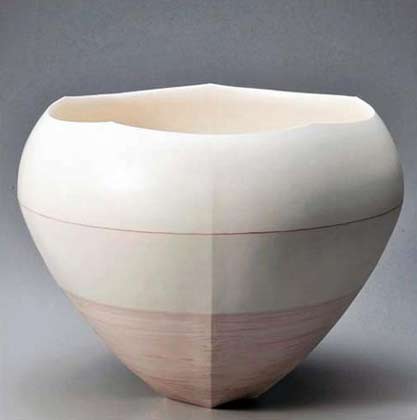
Hoshino Tomoyuki
When I work on the wheel I find myself harmonizing with the clay, and it’s then I can feel a sense as if my own genes somehow become synchronized with the clay drawing itself out in spirals; I find it a fascinating process.
Kaku Hayashi
Japan
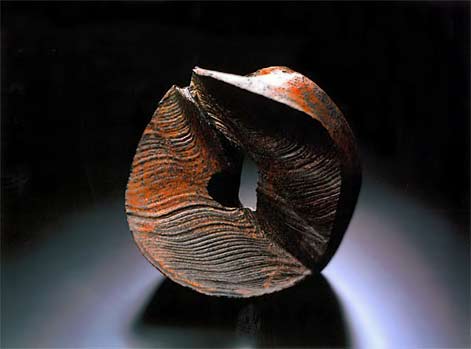
‘Zero Trajectory’ – Kaku Hayashi
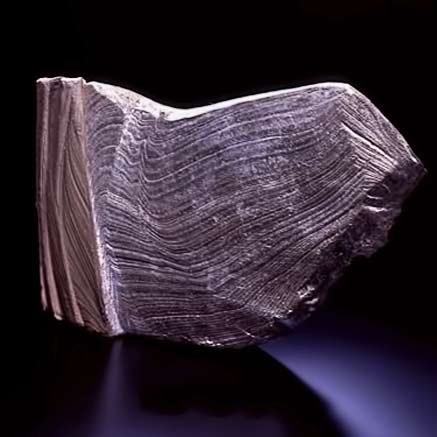
‘Zero Trajectory’ – Kaku Hayashi
Hayashi’s Zero Trajectory series was inspired by an encounter with a calligraphy artist. Her creations begin with the idea of ZERO or ‘nothingness’ found in ZEN Buddhism. This Eastern philosophical concept has provided wide-ranging inspiration for Hayashi’s ceramic work. She exploits the malleability of clay to express her ideas through a dynamic series of folds, combined with undulations derived from calligraphy brushwork.
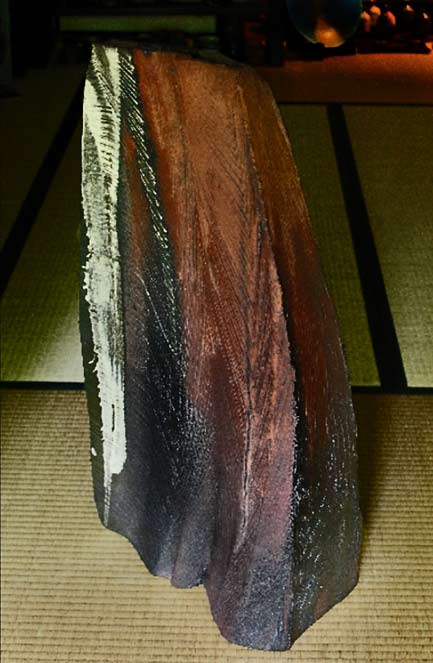
Kaku Hayashi – Kegon
The exhibit, ‘Kegon’, is inspired by the beautiful sacred waterfall in Tochigi prefecture, Kegon no Taki. This masterful work brilliantly evokes in pottery the dramatic cascade of water and its substance as droplets.The Kegon Waterfall is one of the most famous waterfalls in all of Japan and Hayashi lives close to this location. She draws upon the majestic beauty and power of the falls and incorporates those elements-emotions into her works.( see below)
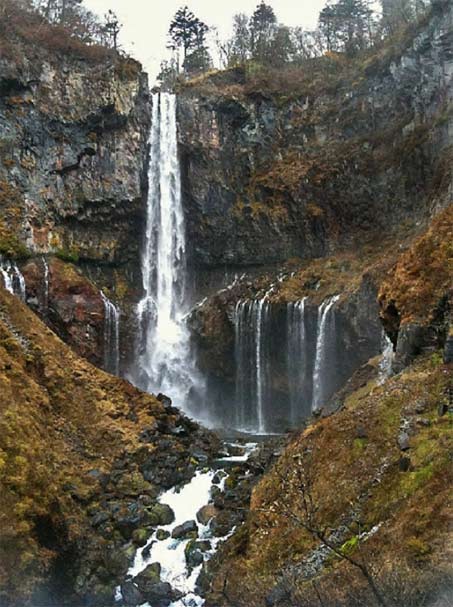
Kegon Falls, Japan
Fujino Sachiko
Japan
“I create my pieces through a dialogue with the soft clay . Clay is a moist, flexible medium, whose plasticity suggests new ceramic forms. Conscious of both the suppleness and the fragility of the clay, I attempt to create forms which possess an inner power of conviction. I would like to approach the clay in such a way that my pieces are expressions of profound thoughts and feelings”. She enhances the depth of her surfaces by using an airbrush device that sprays slip and occasionally colored glazes.
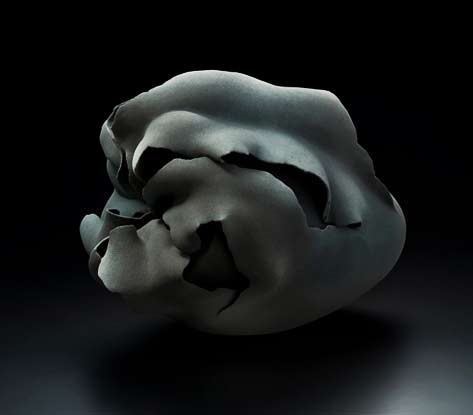
Collapse/Rebirth – Fujino Sachiko
Interconnection ’15-3
Joan B Mirviss
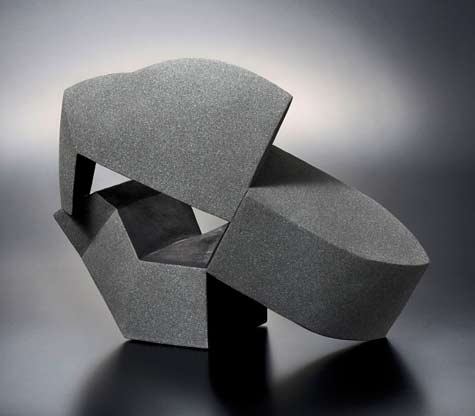
‘Rensetsu’ – Fujino Sachiko
Stoneware with matte glaze
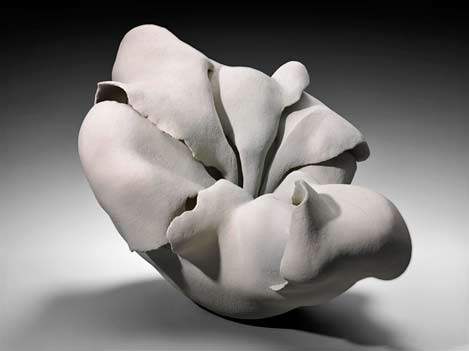
Stoneware ‘Bud Casing II’
Fujino Sachiko 2011
Mary Ann and Stanley Snider Collection
Photograph © Museum of Fine Arts, Boston
Jinnai Sakata
Japan
Hajomon or the Wave Motif itself expresses the five elements of the ancient Chinese philosophy of yin and yang-wood, fire, earth, metal and water-of which all things, living and nonliving, in heaven and on earth are composed. Since ancient times the Chinese have viewed the world through the prism of the “yin and yang five elements”.
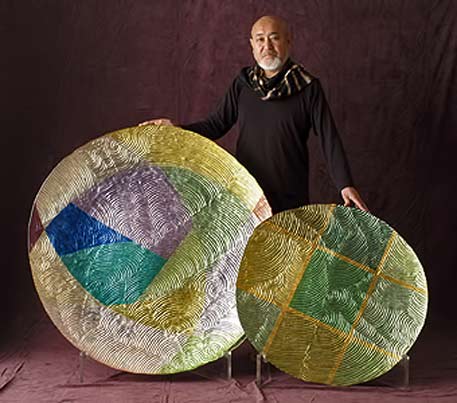
Jinnai Sakata
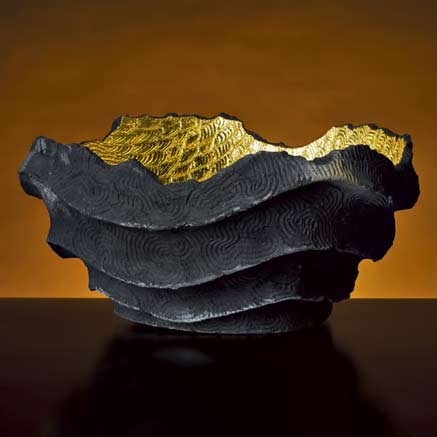
‘Jormon memory’ – Jinnai Sakata
Vessel of Black exterior with gilt pressed inside (Daihachi)
“What I am attempting is not to imitate the warmth and forcefulness found in Jomon vessels, nor to merely reproduce their shapes. But rather I wish to reconstruct in the present, through the means of my awareness, the spirituality imbued in Jomon pieces – each one a prayer of divine awe and reverence.”
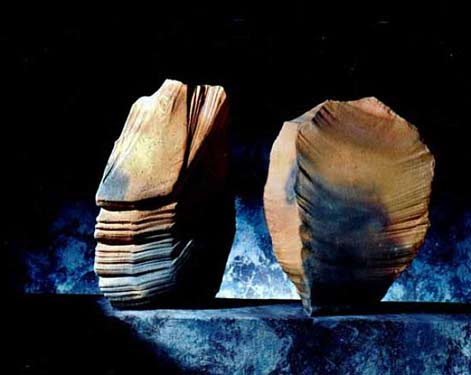
‘Zanskar of Convergence’ – Jinnai Sakata
1994
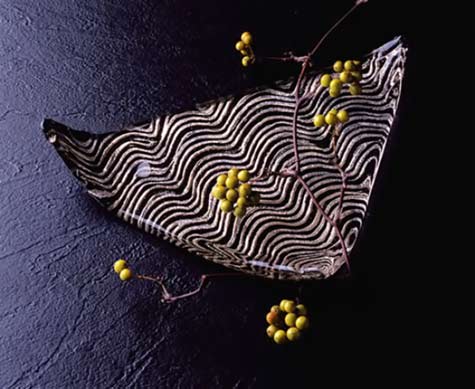
‘Dish with incised waves’ – Jinnai Sakata
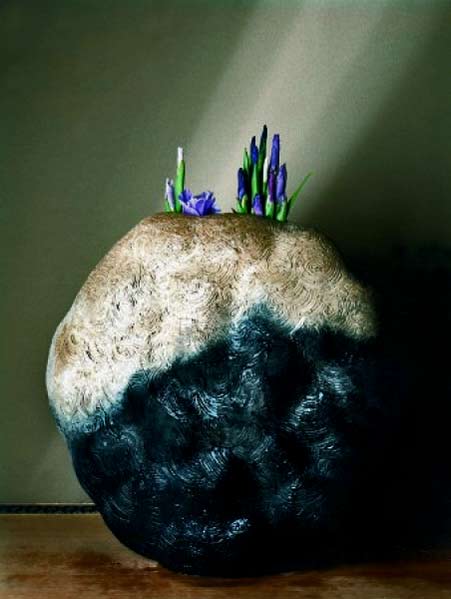
‘Bunhentsubo’ – Jinnai Sakata ikebana
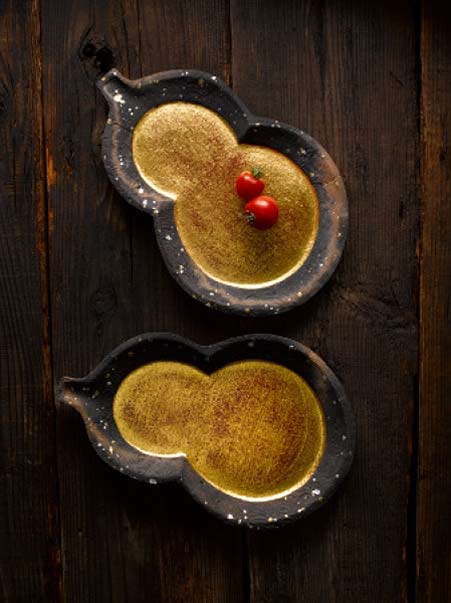
Jinnai Sakata
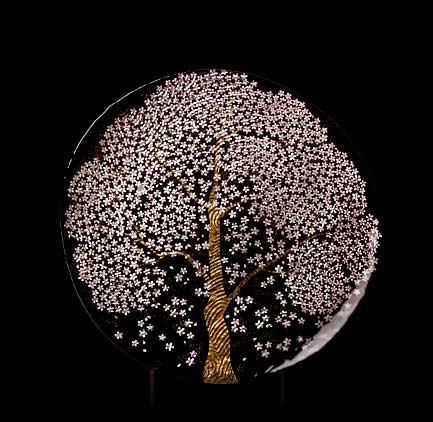
Jinnai Sakata – Very large deep glass dish foil paper-‘Man open Sakurai’ series
‘Inhaling deeply, I feel myself become like a cherry tree drawing deep energy from the Earth. When I exhale, I expand ever outward, radiating from the top of my head, or crown chakra, all the way to the Polaris or Pole Star. If we say that each individual is a micro cosmos then isn’t the top of his head his own Pole Star. Thus the Earth is connected to the Pole Star by the vertical flow of energy, which simultaneously flows downward, piercing the Earth’s mantle to its very core. Heaven, Earth and Man all connected. This connecting energy is what I mean by the Eye of Polaris.’ – Jinnai Sakata (this is Iron Shirt Kung Fu philosophy)
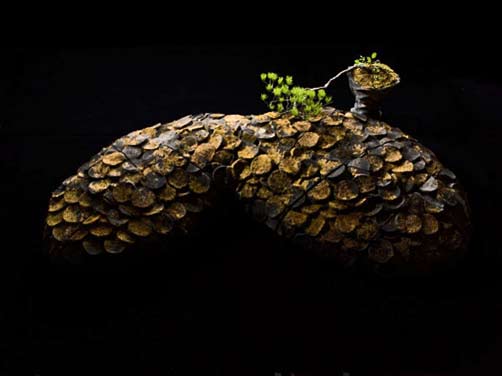
‘Chain Of Life’ bonsai sculpture – Sakata Jinnai
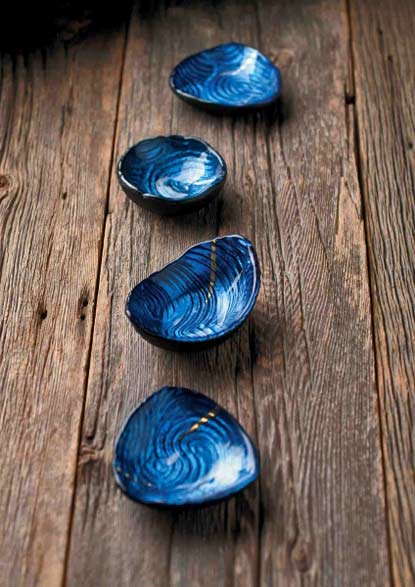
Blue dishes – Jinnai Sakata
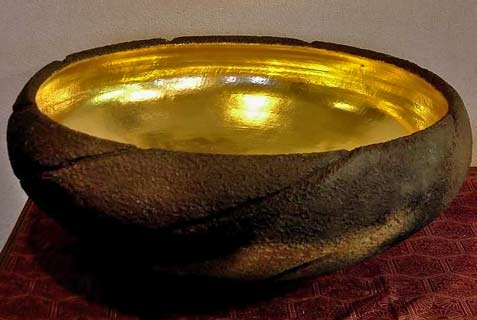
Jinnai Sakata
Large bowl with a rough textured facade that contrasts with the glittering gold kinpaku (gold foil) inside. width 45cm
Inscribed on the bottom is the statement – “Though we travel the world over to find the beautiful, we must carry it with us or we find it not.” Ralph Waldo Emerson.
Ellen Kong
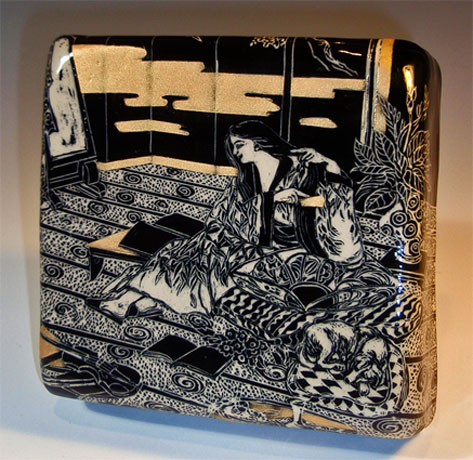
‘Madams Day Off ‘ – Ellen Kong
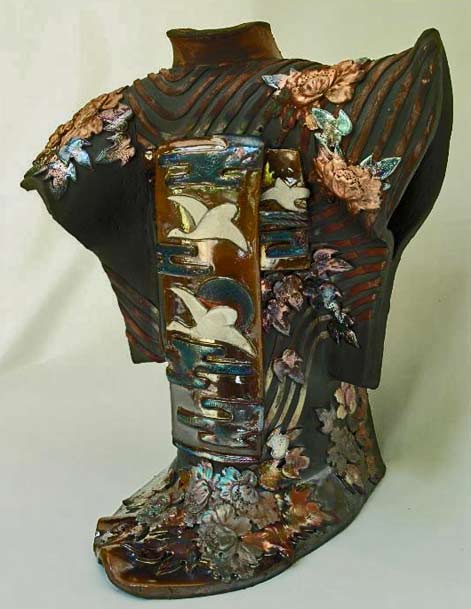
‘Sweet Fragrance Of Summer Eve’ by Ellen Kong
“Like the horticulturist, I must devote time to nurture each individual work. Creating with clay is forever new to me. It is challenging, and intriguing. I like to construct cascading ceramic series, in which one work flows into the next. This sculptural stream of consciousness intrigues me as a vehicle to capture ideas and forms. The incessant pursuit of the ever-expanding boundaries of technique and images nourishes me. In my work, wind-borne seeds sown long ago germinate and bloom unexpectedly, defying time and space. In a unique fashion, they emerge and transform into design elements that reflect my own passage”. Ellen Kong
…
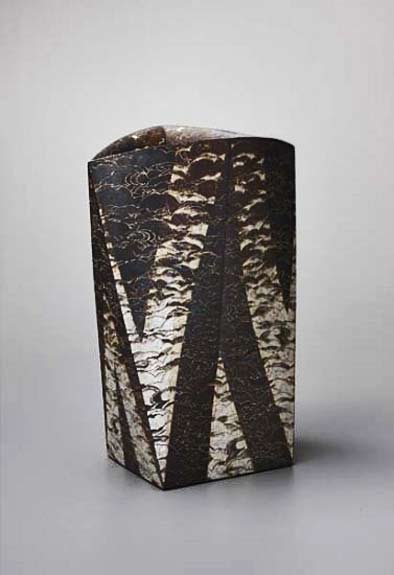
‘Pattern from Inner Image’ – Morihiro Wada
1985
…
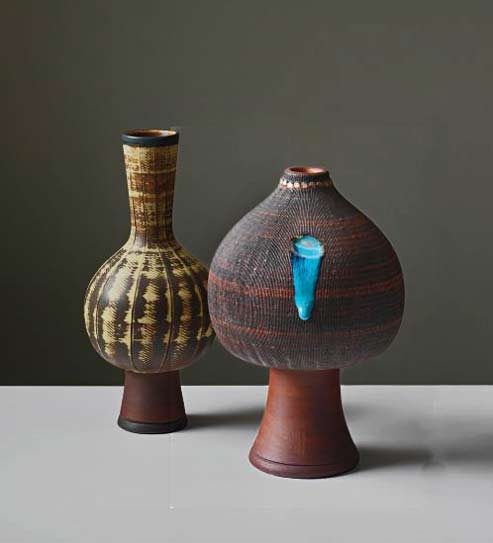
Mid Century Farsta Vase – Wilhelm Cage
Gustavsberg
‘The Sphinx is a symbol shrouded in myth and antiquity; revered in many cultures.’
“I adopted this symbol as a signature to demonstrate respect for the artists of the ancient East, whose pottery is a constant source of wonder. For me, the Sphinx is a guardian of arcane knowledge and many mysteries. By tradition, the vessel held in her paws denotes life and special insight. She has faithfully served Katrich Studios, as a companion and good-luck token.”
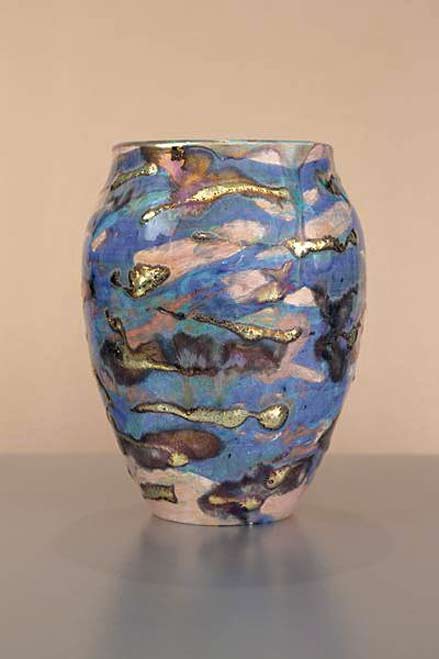
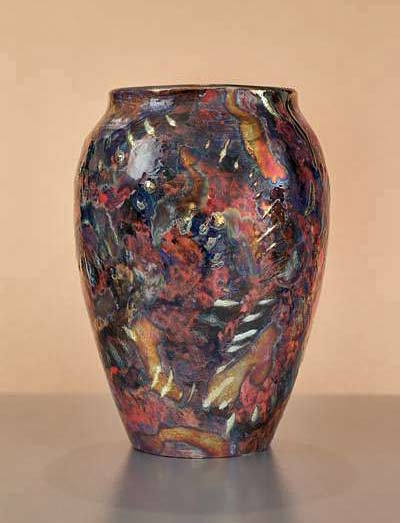
‘Dying Sun’ – Paul Katrich
Scarlet, violet, and magenta peer through a – combustive atmosphere of eternal iridescent night
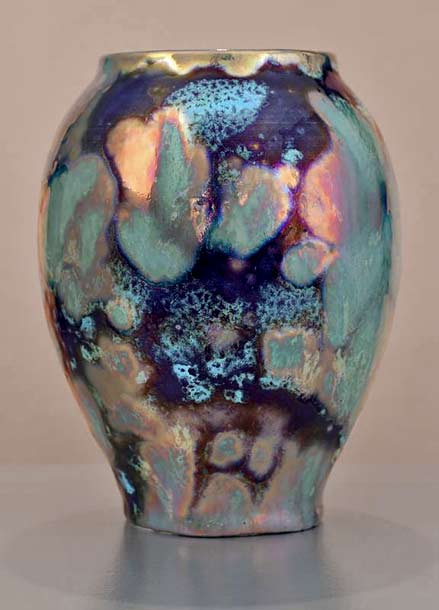
‘Stars and Clouds’
Lustre glaze vessel – Paul Katrich
His clay figures and vessels tell a dramatic story that flows seamlessly from past to future. Resilience, perseverance, honor and history are the themes which he continues to explore. Ortiz has expanded from simply traditional clay, materials and firing to contemporary clay to tell his story on a larger and more complex scale than ever before. – King Gallery, Scottsdale
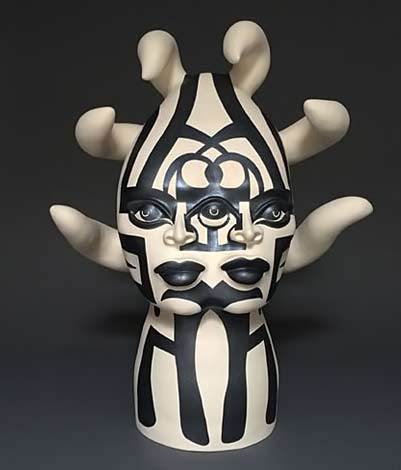
‘Translator Time Shift’ – Virgil Ortiz
Modernly Ancestral Series
‘The masks and vessels. The clay. The past. The future. All are portents to the destruction and victories to come…’
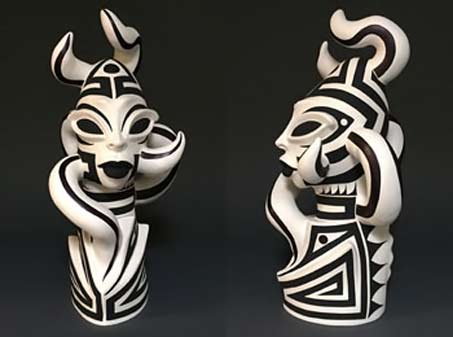
‘Helix’ – Virgil Ortiz
‘My ceramics studies in the U.S. led me to Midcentury Modernism, while my studies in Japan influenced my affinity for Eastern principles that shows up in my work today. I am deeply guided by Hakomi, which is an experiential, mindfulness-based therapy rooted in Taoism. Hakomi is a discipline of paying attention to what you’re experiencing in any given moment, and this allows me to stay focused on the clay as the form reveals itself.
I am fascinated by the inner and outer landscapes of the creative process. When I start a piece I don’t know where it’s going, I don’t have a preconceived shape or idea in mind. I just allow my senses to engage and feel my way to the final result. The clay has a language, a way of communicating its limitations and strengths, and I tap into that dialectic to bring the form to life.’
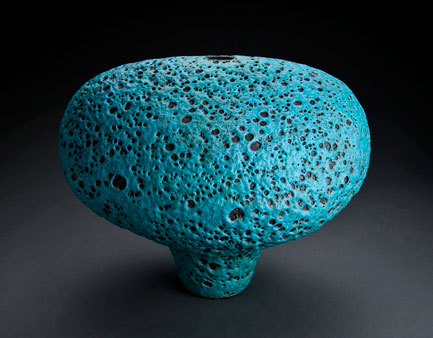
‘Pod’ – turquoise volcanic glaze
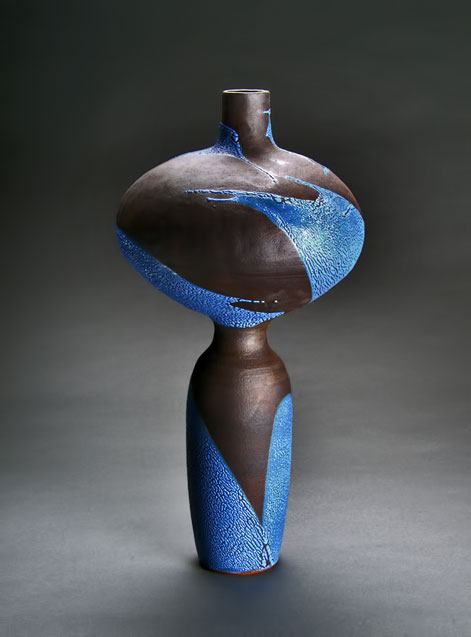
‘Blue Lichen’ Tall Bottle- Josh Herman
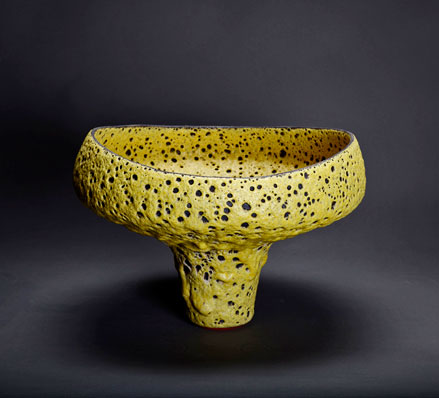
‘Round Chalice—Chartreuse’ by Josh Herman
Australia
“I search for clues in the personal and intimate relics that history left behind, in marks of individuality within the collective, in the tension they hold: quintessential and idiosyncratic forms, manuscripts and letters, the Divine that can be hand held. Working in clay, with its primacy, transformations and its place as a provider of human needs from food receptacles to effigies and Gods, keeps one in a close embrace with this kind of spirituality.”
“I perceive material and spirit as inseparable. Humanity of all persuasions, even the most agnostic, harbours a deep need for ritual and custom, for the embodiment of the spiritual… in objects of meaning and beauty; I am interested in the manifestations of that need and in the conflicts it engenders…my inquiry naturally takes me on the path of the language I love and the stories of my ancestry, yet I am acutely aware of it being the story of humanity. I am inspired by the artisan who sits on the shoulders of humble teachers; who draws on ancient knowledge and traditions; who finds fulfilment in acquiring and refining skills; who takes part in creating complex systems of beauty that resonate with the depth of the human spirit; who touches a place that is beyond time.”
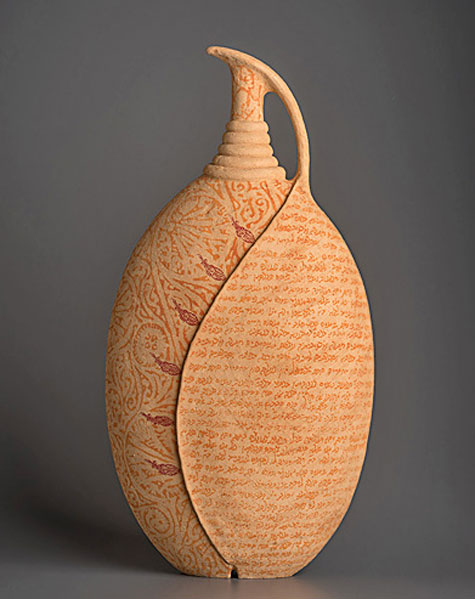
‘Lekitos V’ — Avital Sheffer
2015
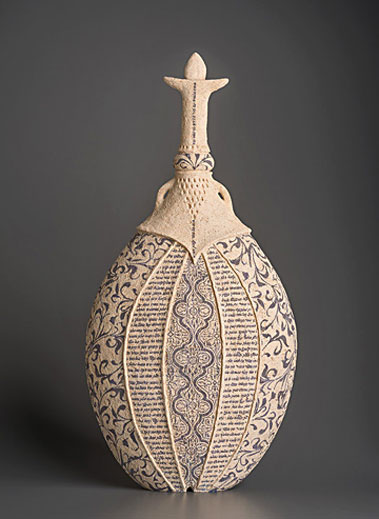
‘Kesher VI’ by Avital Sheffer
2015
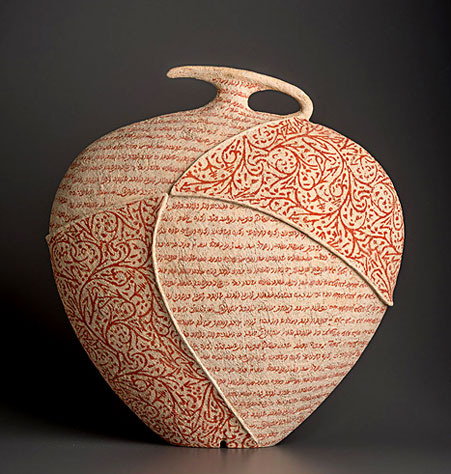
‘Chalcos VI’ by Avital Sheffer
photo – David Young
Catherine White
Because pottery itself abstractly expresses—through clay, glaze and shape—nature’s landscape, it can be as spirited as a spring day or as barren as a raw and sullen winter afternoon, barely touched with color. I am aiming for distillations from nature, historically alive and poetically inspired.
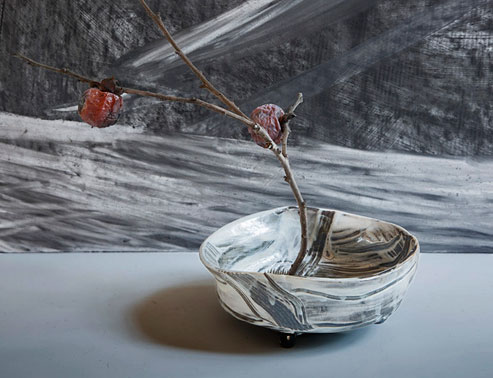
Catherine White – Winter 2015
To the attentive eye,
each moment of the year
has its own beauty,
and in the same field,
it beholds,
every hour,
a picture which was never seen before,
and which shall never be seen again.
— Ralph Waldon Emerson ( via catherinewhite.com)
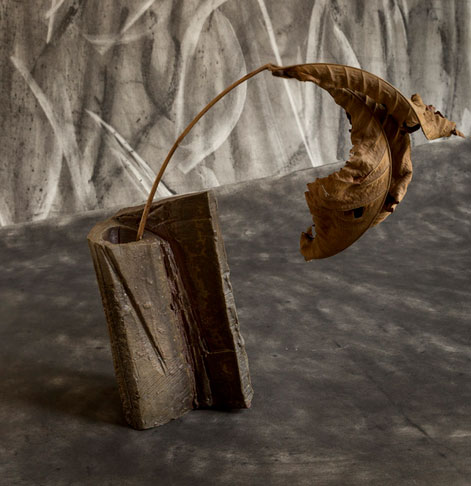
Catherine White ikebana
“I try to apply colors like words that shape poems, like notes that shape music.”
–Joan Miro
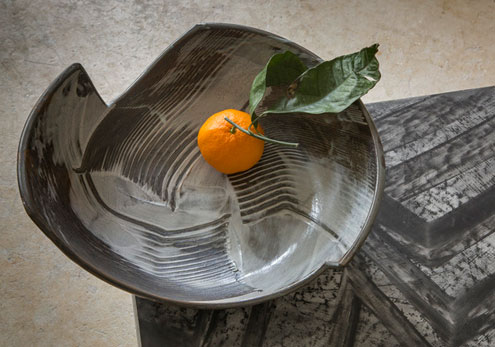
Catherine White ceramics
Nothing is more abstract than reality. – Giorgio Morandi
Thijs Nel
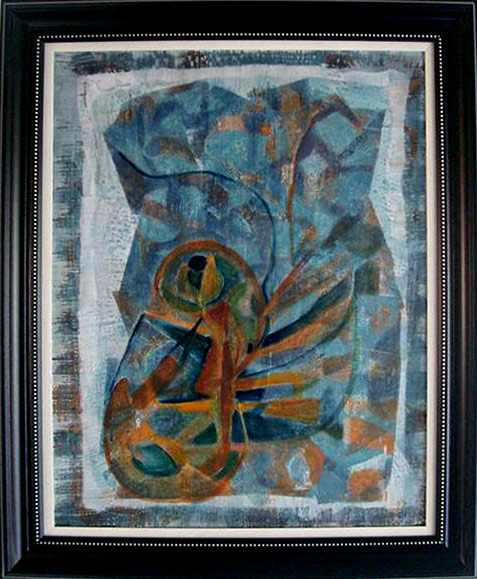
Thijs Nel, South Africa
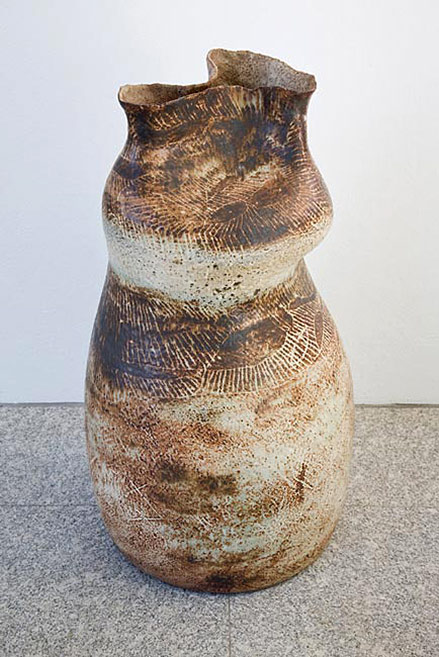
Folded ceramic sculpture vessel — Thijs Nel
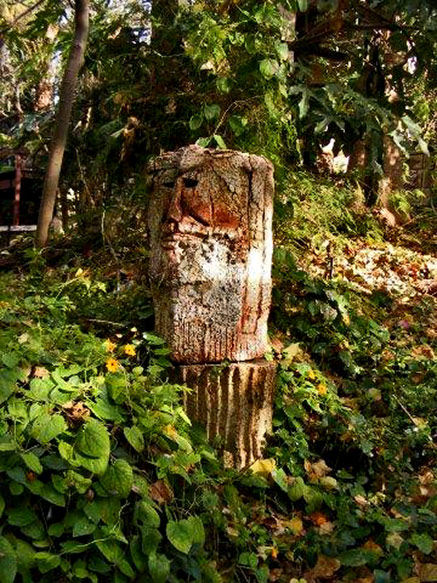
Thijs Nel garden sculpture
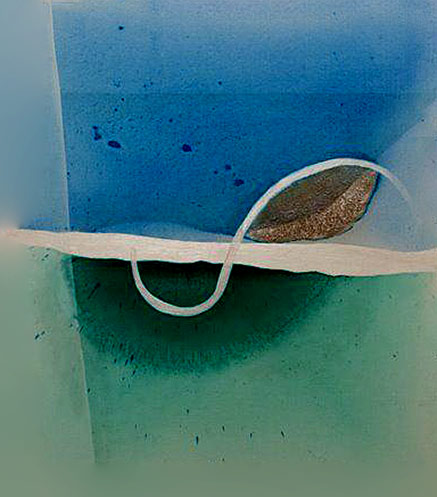
‘Mystical Spiral’ — Thijs Nel
“The circles, squares and spirals always find their way into my work as symbols that suggest wholeness, movement and change. The spiral often becomes a tree of life… a metaphor for the Omnipresence of creation in action.
I have been fascinated by the relationship between the physical material and the metaphysical spiritual conditions of our existence and it became a lifelong quest to find a balance for myself between these phenomena, the Omnipresence of spirit of place… the x- quality that moves us in wonderment about life and the core of our existence.
For as long as I can remember, all forms of creativity and especially painting, sculpting, ceramics and writing… have been for me a means of coming to terms with my immediate environment. I have to find a balance between nature and that which is manmade, including the work of art itself. Something universal and satisfying — something beautiful, should enter into this balance and I dare say that all of these qualities create a dynamic process which should hopefully keep me occupied for the rest of my life.”
–
